N-((het)arylmethyl)-heteroaryl-carboxamides compounds as kallikrein inhibitors
Davie , et al.
U.S. patent number 10,611,758 [Application Number 16/460,630] was granted by the patent office on 2020-04-07 for n-((het)arylmethyl)-heteroaryl-carboxamides compounds as kallikrein inhibitors. This patent grant is currently assigned to Kalvista Pharmaceuticals Limited. The grantee listed for this patent is KalVista Pharmaceuticals Limited. Invention is credited to Rebecca Louise Davie, Hannah Joy Edwards, David Michael Evans, Simon Teanby Hodgson.
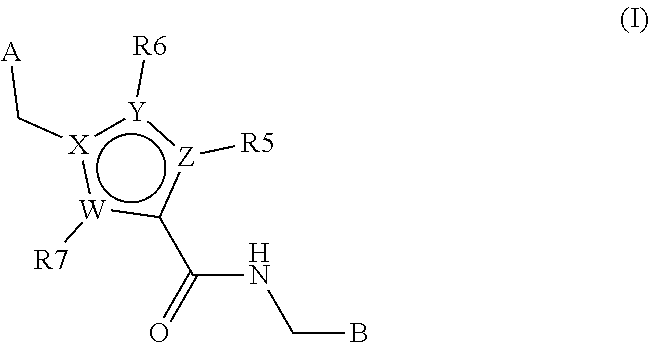
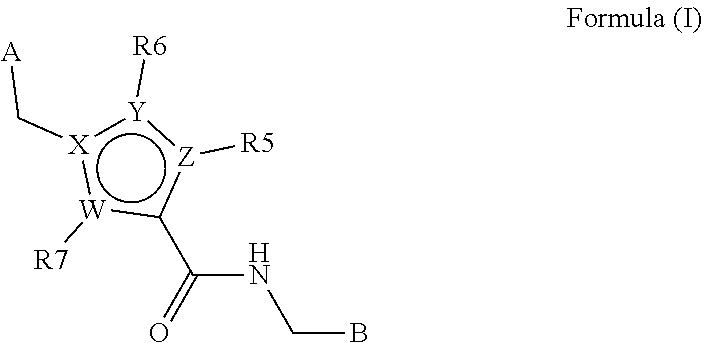
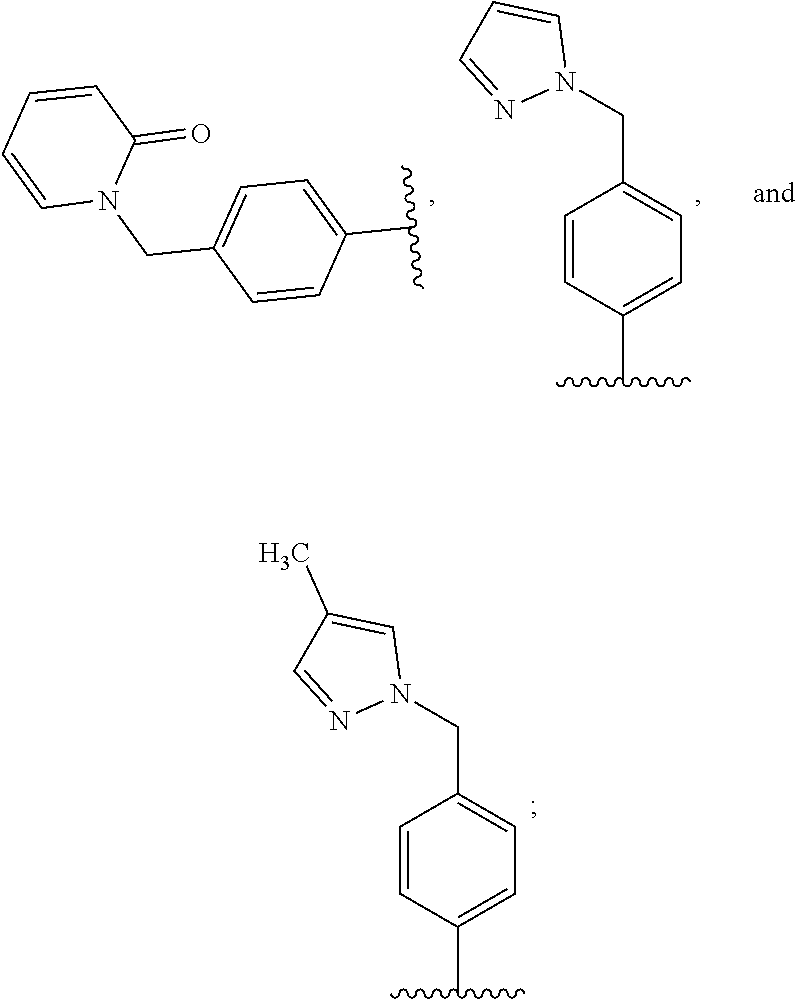
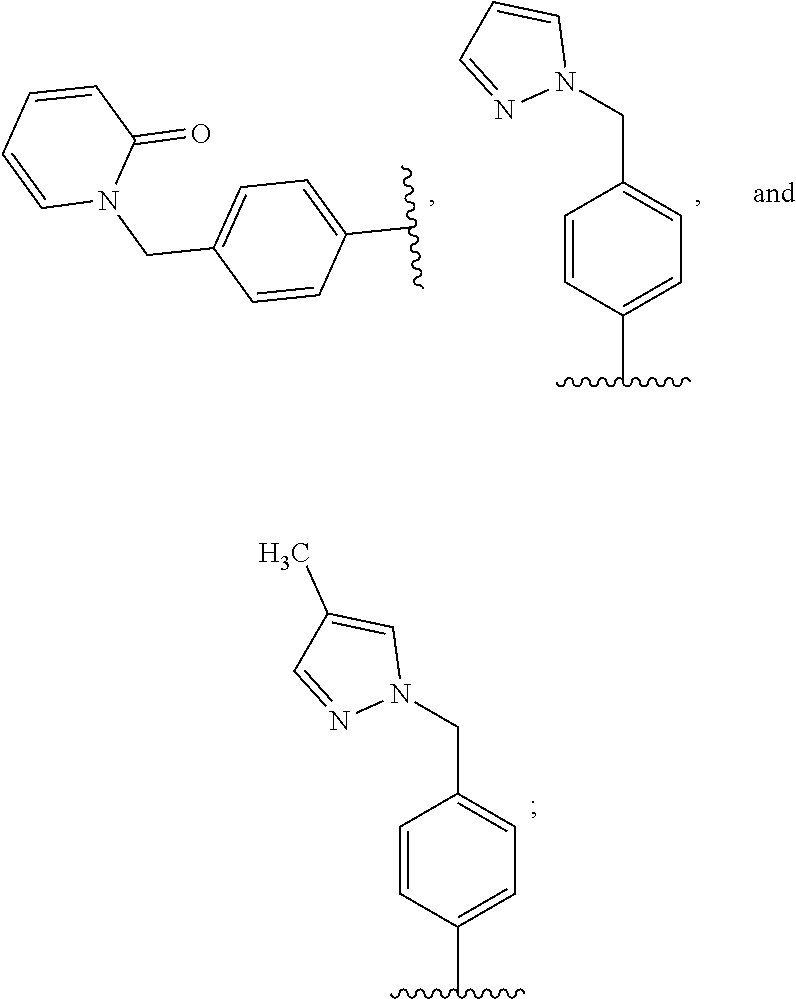

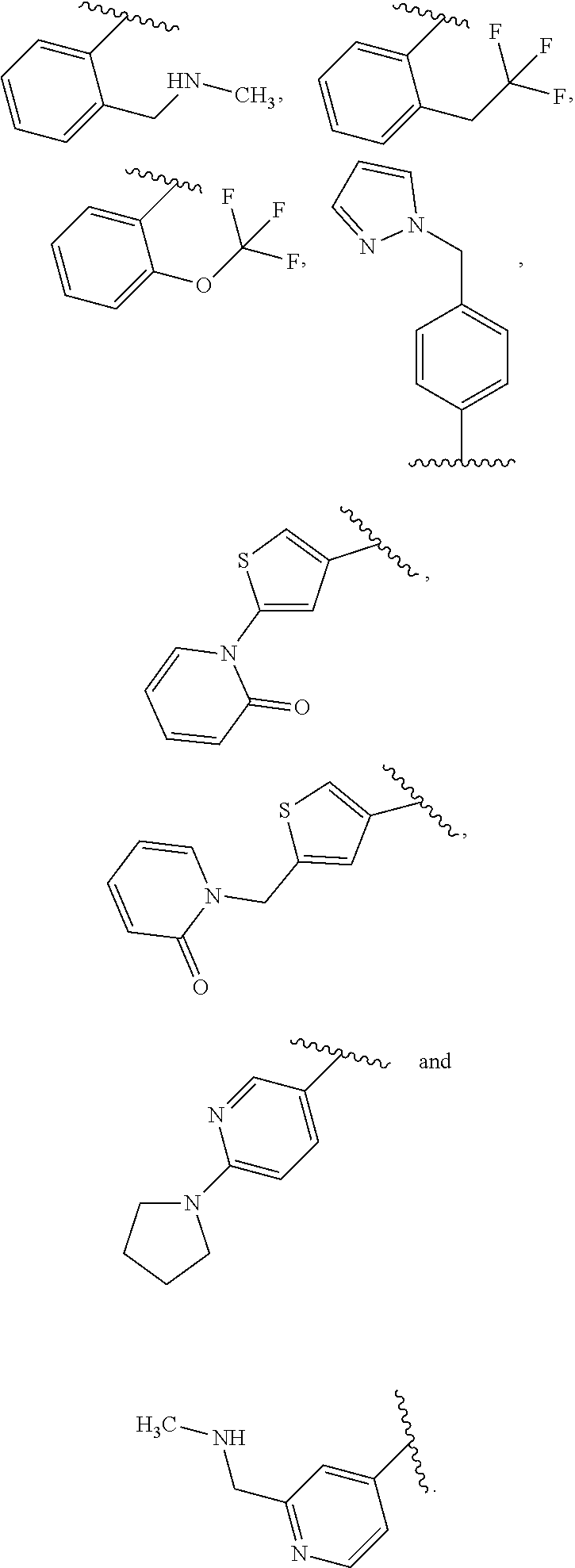
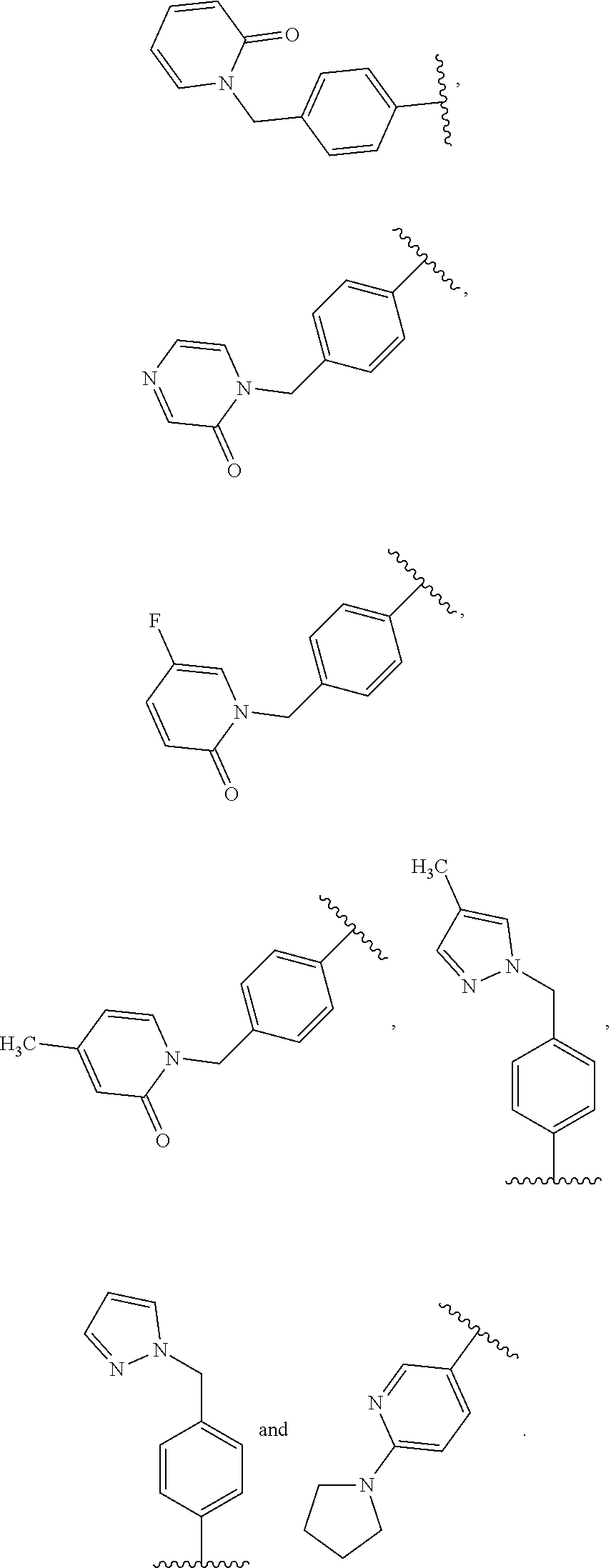
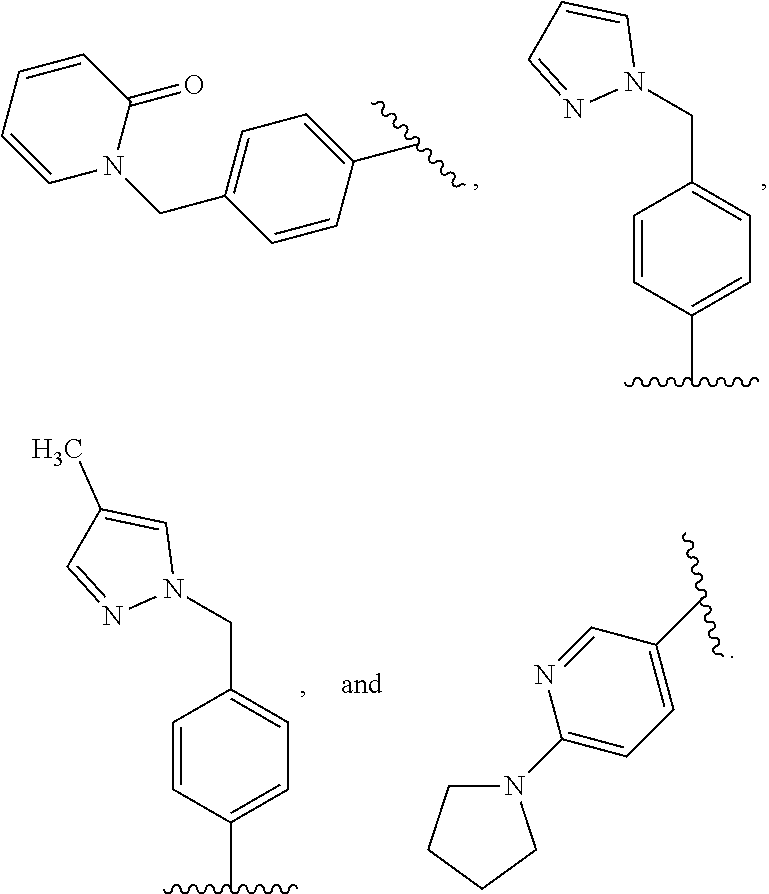
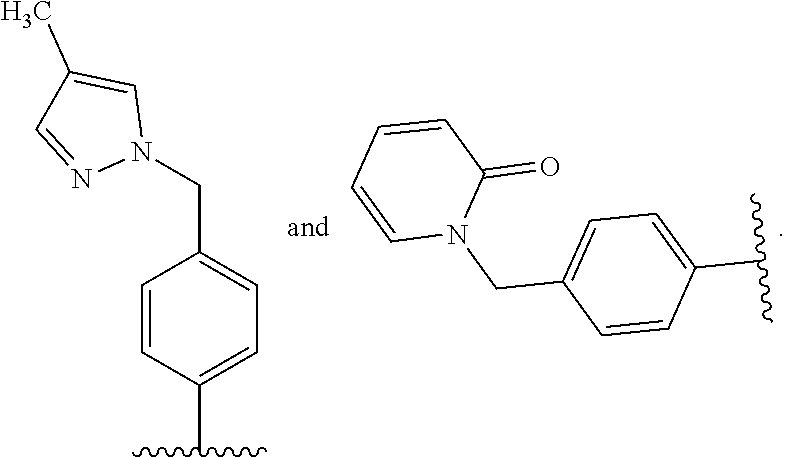
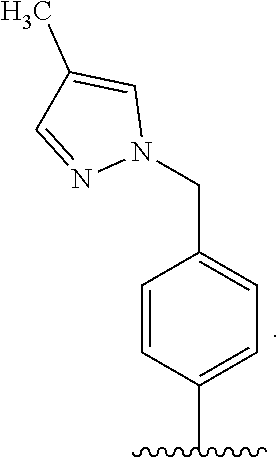
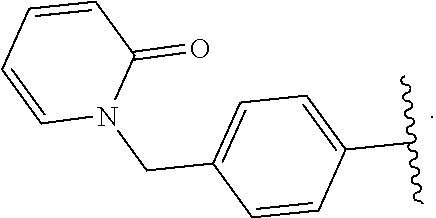
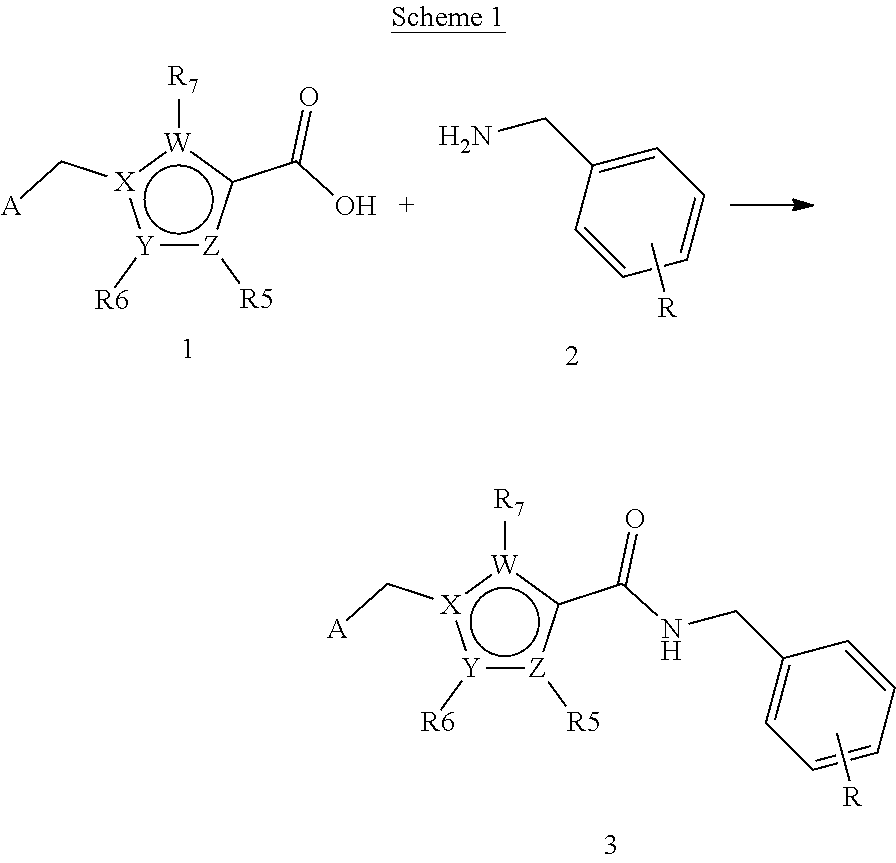
View All Diagrams
| United States Patent | 10,611,758 |
| Davie , et al. | April 7, 2020 |
N-((het)arylmethyl)-heteroaryl-carboxamides compounds as kallikrein inhibitors
Abstract
The present invention provides compounds of formula (I): ##STR00001## compositions comprising such compounds; the use of such compounds in therapy (for example in the treatment or prevention of a disease or condition in which plasma kallikrein activity is implicated); and methods of treating patients with such compounds; wherein R5, R6, R7, A, B, W, X, Y and Z are as defined herein.
| Inventors: | Davie; Rebecca Louise (Salisbury, GB), Edwards; Hannah Joy (Salisbury, GB), Evans; David Michael (Salisbury, GB), Hodgson; Simon Teanby (Bedfordshire, GB) | ||||||||||
|---|---|---|---|---|---|---|---|---|---|---|---|
| Applicant: |
|
||||||||||
| Assignee: | Kalvista Pharmaceuticals
Limited (Porton Down, Wiltshire, GB) |
||||||||||
| Family ID: | 52349552 | ||||||||||
| Appl. No.: | 16/460,630 | ||||||||||
| Filed: | July 2, 2019 |
Prior Publication Data
| Document Identifier | Publication Date | |
|---|---|---|
| US 20190330200 A1 | Oct 31, 2019 | |
Related U.S. Patent Documents
| Application Number | Filing Date | Patent Number | Issue Date | ||
|---|---|---|---|---|---|
| 15527923 | Jul 30, 2019 | 10364238 | |||
| PCT/GB2015/053615 | Nov 26, 2015 | ||||
Foreign Application Priority Data
| Nov 27, 2014 [GB] | 1421083.5 | |||
| Current U.S. Class: | 1/1 |
| Current CPC Class: | C07D 401/14 (20130101); C07D 409/14 (20130101); A61K 31/496 (20130101); C07D 401/06 (20130101); A61P 43/00 (20180101); C07D 401/10 (20130101); A61K 31/4439 (20130101); A61K 31/445 (20130101); C07D 413/14 (20130101); C07D 231/14 (20130101); C07D 403/10 (20130101) |
| Current International Class: | A61K 31/4439 (20060101); C07D 401/14 (20060101); C07D 401/10 (20060101); C07D 409/14 (20060101); A61P 43/00 (20060101); C07D 413/14 (20060101); C07D 401/06 (20060101); C07D 403/10 (20060101); C07D 231/14 (20060101); A61K 31/445 (20060101); A61K 31/496 (20060101) |
References Cited [Referenced By]
U.S. Patent Documents
| 5187157 | February 1993 | Kettner et al. |
| 7101878 | September 2006 | Anderson et al. |
| 8207378 | June 2012 | Steinmetzer et al. |
| 9382219 | July 2016 | Das et al. |
| 9512065 | December 2016 | Northen et al. |
| 9533987 | January 2017 | Davie et al. |
| 9670157 | June 2017 | Allan et al. |
| 9738641 | August 2017 | Edwards et al. |
| 10221161 | March 2019 | Edwards et al. |
| 2007/0254894 | November 2007 | Kane et al. |
| 2008/0221091 | September 2008 | Gege et al. |
| 2009/0163545 | June 2009 | Goldfarb |
| 2010/0113782 | May 2010 | Bolin et al. |
| 2011/0152533 | June 2011 | Sinha et al. |
| 2012/0298326 | November 2012 | Born |
| 2014/0213611 | July 2014 | Evans et al. |
| 2014/0378474 | December 2014 | Flohr et al. |
| 2015/0191421 | July 2015 | Northen et al. |
| 2015/0315198 | November 2015 | Li et al. |
| 2017/0305863 | October 2017 | Evans et al. |
| 2018/0319782 | November 2018 | Davie et al. |
| 201200917 | Dec 2012 | EA | |||
| 1426364 | Jun 2004 | EP | |||
| 1568698 | Aug 2005 | EP | |||
| 2281885 | Feb 2011 | EP | |||
| 2010-520294 | Jun 2010 | JP | |||
| 2485114 | Jun 2013 | RU | |||
| 9204371 | Mar 1992 | WO | |||
| 9429335 | Dec 1994 | WO | |||
| 9507921 | Mar 1995 | WO | |||
| 03/35076 | May 2003 | WO | |||
| 03/37274 | May 2003 | WO | |||
| 03076458 | Sep 2003 | WO | |||
| 03091226 | Nov 2003 | WO | |||
| 2004/062657 | Jul 2004 | WO | |||
| 2004/069792 | Aug 2004 | WO | |||
| 2005049578 | Jun 2005 | WO | |||
| 2005/079800 | Sep 2005 | WO | |||
| 2005123680 | Dec 2005 | WO | |||
| 2006091459 | Aug 2006 | WO | |||
| 2006/114313 | Nov 2006 | WO | |||
| 2007/011626 | Jan 2007 | WO | |||
| 2007113289 | Oct 2007 | WO | |||
| 2008016883 | Feb 2008 | WO | |||
| 2008049595 | May 2008 | WO | |||
| 2008091692 | Jul 2008 | WO | |||
| 2008/121670 | Oct 2008 | WO | |||
| 2009/012998 | Jan 2009 | WO | |||
| 2009026407 | Feb 2009 | WO | |||
| 2009/083553 | Jul 2009 | WO | |||
| 2009097141 | Aug 2009 | WO | |||
| 2009/106980 | Sep 2009 | WO | |||
| 2009/114677 | Sep 2009 | WO | |||
| 2010142801 | Dec 2010 | WO | |||
| 2011/075684 | Jun 2011 | WO | |||
| 2011/094496 | Aug 2011 | WO | |||
| 2011118672 | Sep 2011 | WO | |||
| 2012/009009 | Jan 2012 | WO | |||
| 2012004678 | Jan 2012 | WO | |||
| 2012017020 | Feb 2012 | WO | |||
| 2012/142308 | Oct 2012 | WO | |||
| 2012/174362 | Dec 2012 | WO | |||
| 2013/048982 | Apr 2013 | WO | |||
| 2013/049096 | Apr 2013 | WO | |||
| 2013111107 | Aug 2013 | WO | |||
| 2013111108 | Aug 2013 | WO | |||
| 2013120104 | Aug 2013 | WO | |||
| 2013/130603 | Sep 2013 | WO | |||
| 2014/108406 | Jul 2014 | WO | |||
| 2014108679 | Jul 2014 | WO | |||
| 2014145986 | Sep 2014 | WO | |||
| 2014188211 | Nov 2014 | WO | |||
| 2015022546 | Feb 2015 | WO | |||
| 2015022547 | Feb 2015 | WO | |||
| 2015103317 | Jul 2015 | WO | |||
| 2015134998 | Sep 2015 | WO | |||
| 2015171526 | Nov 2015 | WO | |||
| 2015171527 | Nov 2015 | WO | |||
| 2016011209 | Jan 2016 | WO | |||
| 2016029214 | Feb 2016 | WO | |||
| 2016044662 | Mar 2016 | WO | |||
| 2016/083820 | Jun 2016 | WO | |||
| 2016083816 | Jun 2016 | WO | |||
| 2016083818 | Jun 2016 | WO | |||
| 2016138532 | Sep 2016 | WO | |||
| 2017/001924 | Jan 2017 | WO | |||
| 2017001926 | Jan 2017 | WO | |||
| 2017001936 | Jan 2017 | WO | |||
| 2017072020 | May 2017 | WO | |||
| 2017072021 | May 2017 | WO | |||
| 2017/207983 | Dec 2017 | WO | |||
| 2017/207985 | Dec 2017 | WO | |||
| 2017/208005 | Dec 2017 | WO | |||
| 2018/011628 | Jan 2018 | WO | |||
| 2019/106359 | Jun 2019 | WO | |||
| 2019/106375 | Jun 2019 | WO | |||
| 2019/106377 | Jun 2019 | WO | |||
Other References
|
Babu et al., "A Simple, Sensitive and Selective Fluorogenic Assay to Monitor Plasma Kallikrein Inhibitory Activity of BCX4161 in Activated Plasma", Journal of Allergy and Clinical Immunology, Feb. 2014, 133(2 Supp), Abstract AB40, p. 1. cited by applicant . Bhoola et al., "Bioregulation of Kinins: Kallikreins, Kininogens and Kininases", Pharmacological Rev., Mar. 1992, 44 (1), pp. 1-80. cited by applicant . Bhoola et al., "Kallikrein-Kinin Cascade" Encyclopedia of Respiratory Medicine, 2006, pp. 483-493. cited by applicant . Bryant et al., "Human Plasma Kallikrein-Kinin System: Physiological and Biochemical Parameters", Cardiovascular and Haematological Agents in Medicinal Chemistry, Jul. 2009, pp. 234-250. cited by applicant . Calderone et al., "1,2,3-Triazol-Carboxanilides and 1,2,3-Triazol-(N-Benzyl)-Carboxamides as BK-Potassium Channel Activators. XII" European Journal of Medicinal Chemistry 43, 2008, pp. 2618-2626. cited by applicant . Campbell, "Towards Understanding the Kallikrein-Kinin System: Insights from the Measurement of Kinin Peptides", Brazilian Journal of Medical and Biological Research, Jun. 2000, 33(6), pp. 665-677. cited by applicant . Chilcote et al., "ASP-634: An Oral Drug Candidate for Diabetic Macular Edema", ARVO Mar. 2012, Presentation 2240, Abstract, p. 1. cited by applicant . Clermont et al., "Plasma Kallikrein Mediates Retinal Vascular Dysfunction and Induces Retinal Thickening in Diabetic Rats", Diabetes, May 2011, 60(5), pp. 1590-1598. cited by applicant . Collis et al., "BCX4161, An Oral Kallikrein Inhibitor: Safety and Pharmacokinetic Results of a Phase 1 Study in Healthy Volunteers", Journal of Allergy and Clinical Immunology, vol. 133, Issue 2, Supplement, Feb. 2014, p. AB39. cited by applicant . CAS Extract for Compound 1086603-52-2, dated Dec. 18, 2008, 2 pages. cited by applicant . CAS Extract for Compound 1094996-93-6, dated Jan. 22, 2009, 1 page. cited by applicant . CAS Extract for Compound 1171693-25-6, dated Aug. 2, 2017, 1 page. cited by applicant . CAS Extract for Compound 1386189-59-8, dated Aug. 3, 2012, 1 page. cited by applicant . Elman et al., "Randomized Trial Evaluating Ranibizumab Plus Prompt or Deferred Laser or Triamcinolone Plus Prompt Laser for Diabetic Macular Edema", Ophthalmology, Jun. 2010, 117(6), e35, pp. 1064-1077. cited by applicant . Evans et al., "Selective Inhibitors of Plasma Kallikrein", Immunopharmacology, May 1996, 32(1-3), pp. 115-116. cited by applicant . Garrett et al. "Peptide Aldehyde Inhibitors of the Kallikreins: an Investigation of Subsite Interactions with Tripeptides Containing Structural Variations at the Amino Terminus", J. Peptide Research, Jul. 1998, 52(1), pp. 60-71. cited by applicant . Griesbacher et al., "Involvement of Tissue Kallikrein But Not Plasma Kallikrein in the Development of Symptoms Mediated by Endogenous Kinins in Acute Pancreatitis in Rats", British Journal of Pharmacology, 2002, 137, pp. 692-700. cited by applicant . Johansen et al., "Assay of Kallikrein Inhibitors and Levels of Acetone-Activated Kallikrein in Plasma Specimens from Reactors to Dextran or to Contrast Media", International Journal Tissue Reactions, 1986, 8, pp. 185-192. cited by applicant . Kolte et al., "Biochemical Characterization of a Novel High-Affinity and Specific Kallikrein Inhibitor", British Journal of Pharmacology, Apr. 2011, 162(7), pp. 1639-1649. cited by applicant . Lehmann, "Ecallantide (DX-88), a Plasma Kallikrein Inhibitor for the Treatment of Hereditary Angioedema and the Prevention of Blood Loss in On-Pump Cardiothoracic Surgery", Expert Opinion Biol. Ther., Jul. 2008, 8(8), pp. 1187-1199. cited by applicant . Leinweber et al, "Possible Physiological Roles of Carboxylic Ester Hydrolases", Drug Metabolism Reviews, Jan. 1987, 18(4), pp. 379-439. cited by applicant . Liang et al. "Fast-Dissolving Intraoral Drug Delivery Systems", Expert Opinion in Therapeutic Patients, Jun. 2001, 11(6), pp. 981-986. cited by applicant . Lieberman et al., Pharmaceutical Dosage Forms: Tablets, vol. 1, 1980, pp. 145-157. cited by applicant . Marceau et al., "Bradykinin Receptor Ligands: Therapeutic Perspectives", Nature Reviews Drug Discovery, Oct. 2004, 3, pp. 845-852. cited by applicant . Okada et al., "Development of Potent and Selective Plasmin and Plasma Kallikrein Inhibitors and Studies on the Structure-Activity Relationship", Chem. Pharm. Bull., Sep. 2000, 48, pp. 1964-1972. cited by applicant . Patel, "Combination Therapy for Age-Related Macular Degeneration", Retina, Jun. 2009, 29(6), pp. S45-S48. cited by applicant . Remington: Practice of the Science and Pharmacy; 19th Edition; Mack Publishing Company, 1995, 5 pages. cited by applicant . Shori et al., "New Specific Assays for Tonin and Tissue Kallikrein Activities in Rat Submandibular Glands: Assays Reveal Differences in the Effects of Sympathetic and Parasympathetic Stimulation on Proteinases in Saliva", Biochemical Pharmacology, Mar. 17, 1992, 43(6), pp. 1209-1217. cited by applicant . Sturzebecher et al., "Inhibition of Human Mast Cell Tryptase by Benzamidine Derivatives", Biological Chemistry Hoppe-Seyler, Oct. 1992, 373(2), p. 1025. cited by applicant . Sturzebecher et al., "Novel Plasma Kallikrein Inhibitors of the Benzamidine Type", Brazilian J. Med. Biol. Res, Aug. 1994, 27(8), pp. 1929-1934. cited by applicant . Tang et al., "Expression, Crystallization, and Three-Dimensional Structure of the Catalytic Domain of Human Plasma Kallikrein", The Journal of Biological Chemistry vol. 280, No. 49, Dec. 2005, pp. 41077-41089. cited by applicant . Teno et al., "Development of Active Center-Directed Plasmin and Plasma Kallikrein Inhibitors and Studies on the Structure-Inhibitory Activity Relationship", Chemical and Pharmaceutical Bulletin, Jun. 1993, 41(6), pp. 1079-1090. cited by applicant . Wermuth et al., Handbook of Pharmaceutical Salts: Properties, Selection and Use, 2002 vol. 24, No. 3, p. 20. cited by applicant . Wermuth, "The Practice of Medicinal Chemistry", 2003, 2nd Ed., pp. 561-585. cited by applicant . Young et al., "Small Molecule Inhibitors of Plasma Kallikrein", Bioorg. Med. Chem. Letts., Apr. 2006, 16(7), pp. 2034-2036. cited by applicant . Zhang et al. "Discovery of Highly Potent Small Molecule Kallikrein Inhibitors", Medicinal Chemistry, 2006, 2, pp. 545-553. cited by applicant . Pace, et al., "4-Hydroxy-5-pyrrolinone-3-carboxamide HIV-1 integrase inhibitors", Bioorganic Medicinal Chemistry Letters., Jun. 18, 2008, pp. 3865-3869. cited by applicant . Registry No. 1086603-42-0, Chemical Library-AKos Consulting and Solutions GmbH, CHEMCATS, dated Dec. 18, 2008, 1 page. cited by applicant . Registry No. 1318167-86-0, Chemical Library--Fch Group, CHEMCATS, dated Aug. 15, 2011, 1 page. cited by applicant . Registry No. 1570266-44-2, Chemical Library--FCH Group, dated Mar. 19, 2014, 1 page. cited by applicant . Registry No. 1572436-72-6, Chemical Library--FCH Group, dated Mar. 24, 2014, 1 page. cited by applicant . Registry No. 1573976-69-8, Chemical Library--FCH Group, dated Mar. 26, 2014, 1 page. cited by applicant . Registry No. 1575214-30-0, Chemical Library--FCH Group, dated Mar. 28, 2014, 1 page. cited by applicant . Registry No. 1580327-09-8, Chemical Library--FCH Group, dated Apr. 4, 2014, 1 page. cited by applicant . Registry No. 1572946-10-1, Chemical Library--FCH Group, Mar. 25, 2014, 1 page. cited by applicant . Registry No. 1569406-35-4, Chemical Library--FCH Group, Mar. 18, 2014, 1 page. cited by applicant . Registry No. 1320653-15-3, Chemical Library--FCH Group, Aug. 21, 2011, 1 page. cited by applicant . Registry No. 1086603-37-3, Chemical Library-AKos Consulting and Solutions GmbH, CHEMCATS, dated Dec. 18, 2008, 1 page. cited by applicant . Ambinter Sari: "1 H-Pyrazole-4-carboxamides" In: Chemical Catalog, Sep. 11, 2011 (Sep. 11, 2011), Ambinter SARL, XP055601375. cited by applicant . Babu, "Drug Discovery at BioCryst Pharmaceuticals Inc.", Presentation, http://files.shareholder.com/downloads/BCRX/OxOx403076/97a18d6e-1621 -4fc6- -8f5fd0828bddab4f/, Sep. 16, 2010, 18 pages. cited by applicant . Bird et al. Thrombosis and Haemostasis, Effects of plasma kallikrein deficiency on haemostasis and thrombosis in mice: Murine Ortholog of the Fletcher Trait, 2012, 107, 1141-50. cited by applicant . Bjorkqvist et al., "Plasma kallikrein: the bradykinin-producing enzyme", Thrombosis and Haemotasis, 2013, 110, 399-407. cited by applicant . Caddick et al., "Convenient Synthesis of Protected Primary Amines from Nitriles", Tetrahedron Letters, Apr. 29, 2000, 41(18), 3513-3516. cited by applicant . Calderone et al., "1,2,3-Triazol-Carboxanilides and 1,2,3-Triazol-(N-Benzyl)-Carboxamides as BK-Potassium Channe Activators. XII" European Journal of Medicinal Chemistry 43, 2008, pp. 2618-2626. cited by applicant . Cannon, Chapter Nineteen in Burger's Medicinal Chemistry and Drug Discovery, Fifth Edition, vol. I: Principles and Practice, Wiley-Interscience 1995, pp. 783-802. cited by applicant . CAS abstract accession No. 1990:515202, corresponding to Ried et al. Liebigs Annalen der Chemie, 1990, 8, 2 pages. cited by applicant . CAS abstract accession No. 2013:1177162, corresponding to Ye et al. Chemical Science, 2013, 4(9), 4 pages. cited by applicant . CAS abstract accession No. 2013:1592386, corresponding to FR2989085 A1 (Commissariat Energie Atomique), 3 pages. cited by applicant . CAS abstract accession Nos. 2009:769551 and 2009:846114, corresponding to U.S. Publication 2009-0163545A1, 5 pages. cited by applicant . CAS extract for Compound 1180236-10-5; Sep. 4, 2009. cited by applicant . CAS extract for Compound 1180808-34-7; Sep. 6, 2009. cited by applicant . CAS Extract for Compound 1197490-19-9, dated Dec. 16, 2009, 1 page. cited by applicant . CAS Extract for Compound 120842-4-4, dated Apr. 18, 2011, 1 page. cited by applicant . CAS Extract for Compound 120842-43-4, dated Apr. 18, 2011, 1 page. cited by applicant . CAS extract for Compound 1288265-35-9; May 1, 2011. cited by applicant . CAS extract for Compound 1288488-40-3; May 1, 2011. cited by applicant . CAS extract for Compound 1288531-53-2; May 1, 2011. cited by applicant . CAS extract for Compound 1293757-54-6; May 12, 2011. cited by applicant . CAS extract for Compound 1297493-36-7; May 19, 2011. cited by applicant . CAS Extract for Compound 1386962-55-5, dated Aug. 6, 2012, 1 page. cited by applicant . CAS Extract for Compound 1388550-15-9, dated Aug. 9, 2012, 1 page. cited by applicant . CAS Extract for Compound 1626023-22-0, dated Sep. 25, 2014, 1 page. cited by applicant . CAS Structures cited in WO201683818 Written Opinion dated Jun. 2, 2016, 290 pages. cited by applicant . Chemical Abstract Service, CHEMCATS, RN 1424383-07-2, Mar. 15, 2013. cited by applicant . Chemical Abstracts Registry No. 1147797-44-1, indexed in the Registry file on STN CAS Online May 20, 2009. cited by applicant . Chemical Abstracts Registry No. 1217027-87-6, indexed in the Registry file on STN CAS Online Apr. 5, 2010. cited by applicant . Chemical Abstracts Registry No. 1241137-33-6, indexed in the Registry file on STN CAS Online Sep. 15, 2010. cited by applicant . Chemical Abstracts Registry No. 1295467-87-6, indexed in the Registry file on STN CAS Online May 16, 2011. cited by applicant . Chemical Abstracts Registry No. 1296846-83-7, indexed in the Registry file on STN CAS Online May 18, 2011. cited by applicant . Chemical Abstracts Registry No. 1297526-11-4, indexed in the Registry file on STN CAS Online May 19, 2011. cited by applicant . Chemical Abstracts Registry No. 1389653-06-8, indexed in the Registry file on STN CAS Online Aug. 12, 2012. cited by applicant . Chemical Abstracts Registry No. 1575116-26-5, indexed in the Registry file on STN CAS Online Mar. 28, 2014. cited by applicant . Chemical Abstracts Registry No. 942731-43-3, indexed in the Registry file on STN CAS Online Jul. 19, 2007. cited by applicant . Chemical Abstracts Registry No. 955899-78-2, indexed in the Registry file on STN CAS Online on Nov. 25, 2007. cited by applicant . Colman, "Plasma and tissue kallikrein in arthritis and inflammatory bowel disease", Immunopharmacology, 1999, 43, 103-108. cited by applicant . Davis III et al., "Biological activities of C1 inhibitor", Molecular Immunology, 2008, 45, 4057-4063. cited by applicant . Enamine website on Jul. 25, 2013 from the Internet Archive Way Back Machine {https://web.archive.org/web/20130725053127/http://www.enamine.ne- t/index.php?option=com_content&task=view&id=22. cited by applicant . Feener at al., "Role of plasma kallikrein in diabetes and metabolism", Thrombosis and Haemostasis, Sep. 2013, 110(3), 434-441. cited by applicant . Ikeda et al., "Host Stromal Bradykinin B.sub.2 Receptor Signaling Facilitates Tumor-Associated Angiogenesis and Tumor Growth", Cancer Research, Aug. 2004, 64, 5178-5185. cited by applicant . International Patent Application No. PCT/GB2015/053613: International Search Report dated Jun. 2, 2016, 5 pages. cited by applicant . International Patent Application No. PCT/GB2015/053613: Written Opinion dated Jun. 2, 2016, 9 pages. cited by applicant . International Search Report for PCT/GB2014/051592 completed Jul. 23, 2014. cited by applicant . Jaffa et al., "Plasma Prekallikrein a Risk Marker for Hypertension and Nephropathy in Type 1 Diabetes", Diabetes, May 2003, vol. 52, 1215-1221. cited by applicant . Katsuura et al., "Effects of a Highly Selective Synthetic Inhibitor of Plasma Kallikrein on Disseminated Intravascular Coagulation in Rats" Thrombosis Research, 1996, 82, 361-368. cited by applicant . Kenniston, J Bio Chem, "Inhibition of Plasma Kallikrein by a Highly Specific Active Site Blocking Antibody", vol. 289 (34), 2014, 23596-23608. cited by applicant . Liu et al., Nat Med., Hyperglycemia Induced Cerebral Hematoma Expansion is Mediated by Plasma Kallikrein, 2011, 17, 206-210. cited by applicant . Lussis et al.; "A single synthetic small molecule that generates force against a load"; Nature Nanotechnology; vol. 6; 2011; p. 553-557. cited by applicant . Luthin et al., "The Discovery of Novel Small Molecule Non-peptide Gonadotropin Releasing Hormone (GnRH) Receptor Antagonists" Bioorg Med Chem Lett, 12, 2002, pp. 3467-3470. cited by applicant . Pace, et al., "4-Hydroxy-5-pynolinone-3-carboxamide HIV-1 integrase inhibitors", Bioorganic & Medicinal Chemistry Letters., Jun. 18, 2008, pp. 3865-3869. cited by applicant . Prassas, "Unleashing the therapeutic potential of human kallikrein--related serine proteases", Nature Reviews Drug Discovery, vol. 14, 183-202, 2015. cited by applicant . PubChem Compound 40150888 May 30, 2009. cited by applicant . PubChem Compound 51143945 May 3, 2011. cited by applicant . PubChem Compound 52011740 May 20, 2011. cited by applicant . PubChem Compound 52011741 May 20, 2001. cited by applicant . PubChem Compound 52011742 May 20, 2011. cited by applicant . PubChem Compound 52011935 May 20, 2011. cited by applicant . PubChem Compound 52011936 May 20, 2011. cited by applicant . PubChem Compound 52011937 May 20, 2011. cited by applicant . PubChem Compound 52011938 May 20, 2011. cited by applicant . PubChem Compound 55389827 Jan. 25, 2012. cited by applicant . PubChem Compound 55408484 Jan. 25, 2012. cited by applicant . PubChem Compound 55408530 Jan. 25, 2012. cited by applicant . PubChem Compound 55408677 Jan. 25, 2012. cited by applicant . PubChem Compound 55408742 Jan. 25, 2012. cited by applicant . PubChem Compound 55408894 Jan. 25, 2012. cited by applicant . PubChem Compound 55438190 Jan. 25, 2012. cited by applicant . PubChem Compound 55494217 Jan. 25, 2012. cited by applicant . PubChem Compound 55650494 Jan. 25, 2012. cited by applicant . PubChem Compound 60376550 Oct. 18, 2012. cited by applicant . PubChem Compound ID 22830339 Dec. 5, 2007. cited by applicant . PubChem Compound ID 24488625 Feb. 29, 2008. cited by applicant . PubChem Compound ID 38284485 May 29, 2009. cited by applicant . PubChem Compound ID 38284487 May 29, 2009. cited by applicant . PubChem Compound ID 46438580 Jul. 23, 2010. cited by applicant . Registry No. 1027627-81-1, Chemical Library--FCG Group, Jun. 12, 2008, 1 page. cited by applicant . Registry No. 1028093-96-0, Chemical Library--FCG Group, Jun. 13, 2008, 1 page. cited by applicant . Registry No. 1028094-50-9, Chemical Library--FCG Group, Jun. 13, 2008, 1 page. cited by applicant . Registry No. 1028096-34-5, Chemical Library--FCG Group, Jun. 13, 2008, 1 page. cited by applicant . Registry No. 1028361-95-6, Chemical Library--FCG Group, Jun. 16, 2008, 1 page. cited by applicant . Registry No. 1061709-51-0, Chemical Library--FCG Group, Oct. 15, 2008, 1 page. cited by applicant . Registry No. 1062408-24-5, Chemical Library--FCG Group, Oct. 17, 2008, 1 page. cited by applicant . Registry No. 1094996-93-6, Chemical Library--AKos Consulting and Solutions GmbH, CHEMCATS, dated Jan. 22, 2009, 1 page. cited by applicant . Registry No. 1103271-51-7, Chemical Library--FCG Group, Feb. 9, 2009, 1 page. cited by applicant . Registry No. 1170030-40-6, Chemical Library--FCG Group, Jul. 29, 2009, 1 page. cited by applicant . Registry No. 1171669-07-0, Chemical Library--FCG Group, Aug. 2, 2009, 1 page. cited by applicant . Registry No. 1171693-25-6, Chemical Library-Ambinter, CHEMCATS, dated Aug. 2, 2017, 1 page. cited by applicant . Registry No. 1278351-92-0, Chemical Library--FCG Group, Apr. 11, 2011, 1 page. cited by applicant . Registry No. 1280842-43-4, Chemical Library--FCG Group, Apr. 18, 2011, 1 page. cited by applicant . Registry No. 1317328-27-0, Chemical Library--FCG Group, Aug. 14, 2011, 1 page. cited by applicant . Registry No. 1317855-54-1, Chemical Library--FCG Group, Aug. 15, 2011, 1 page. cited by applicant . Registry No. 1318604-27-1, Chemical Library--FCG Group, Aug. 16, 2011, 1 page. cited by applicant . Registry No. 1321195-15-6, Chemical Library--FCG Group, Aug. 21, 2011, 1 page. cited by applicant . Registry No. 1321521-84-9, Chemical Library--FCG Group, Aug. 12, 2011, 1 page. cited by applicant . Registry No. 1386189-59-8, Chemical Library--Ukrorgsyntez Ltd., CHEMCATS, dated Aug. 3, 2012, 1 page. cited by applicant . Registry No. 1390613-03-2, Chemical Library--FCG Group, Aug. 13, 2012, 1 page. cited by applicant . Registry No. 1575116-26-5, Chemical Library--FCG Group, Mar. 28, 2014, 1 page. cited by applicant . Registry No. 1625594-62-8, Chemical Library--FCG Group, Sep. 24, 2014, 1 page. cited by applicant . Registry No. 879195-72-9, Chemical Library--FCG Group, Apr. 4, 2006, 1 page. cited by applicant . Registry No. 879300-81-9, Chemical Library--FCG Group, Apr. 5, 2006, 1 page. cited by applicant . Registry No. 955867-36-4, Chemical Library--FCG Group, Nov. 23, 2007, 1 page. cited by applicant . Registry No. 955899-78-2, Chemical Library--FCG Group, Nov. 25, 2007, 1 page. cited by applicant . Registry No. 956190-38-8, Chemical Library--FCG Group, Nov. 28, 2007, 1 page. cited by applicant . Registry No. 956290-77-0, Chemical Library--FCG Group, Nov. 29, 2007, 1 page. cited by applicant . Registry No. 956444-80-7, Chemical Library--FCG Group, Dec. 2, 2007, 1 page. cited by applicant . Registry No. 956521-49-6, Chemical Library--FCG Group, Dec. 3, 2007, 1 page. cited by applicant . Registry No. 956529-72-9, Chemical Library--FCG Group, Dec. 3, 2007, 1 page. cited by applicant . Registry No. 956747-39-0, Chemical Library--FCG Group, Dec. 5, 2007, 1 page. cited by applicant . Registry No. 1015534-45-8, Chemical Library--FCG Group, Apr. 18, 2008, 1 page. cited by applicant . Revenko et al., Blood Journal, "Selective depletion of plasma prekallikrein or coagulation factor XII inhibits thrombosis in mice without increased risk of bleeding", 2011, 118, 5302-5311. cited by applicant . Siebeck et al., "Inhibition of Plasma Kallikrein With Aprotinin in Porcine Endotoxin Shock", The Journal of Trauma, 1993, vol. 34, No. 2, 193-198. cited by applicant . Stahl et al., "Handbook of Pharmaceutical Salts: Properties, Selection and Use", Wiley-VCH, Weinheim, Germany, 2002, 1 page. cited by applicant . STN Registry, "5-Pyrimidinecarboxamide, 1,6-dihydro-N-[1-(6-methyl-1 H-benzimidazol-2-yl)ethyl]-2-oxo-2-(1H-1,2,4-triazol-1-ylmethyl)", CAS No. 1422635-37-7, Mar. 8, 2013. cited by applicant . STN Registry, "5-Pyrimidinecarboxamide, N-[1-(1 H-benzimidazol-2-yl)ethyl]-1,6-dihydro-6-oxo-2-(phenoxymethyl)", CAS No. 1434334-41-4, Jun. 5, 2013. cited by applicant . Tanaka et al., Thrombosis Research, Evaluation of a novel kallikrein inhibitor on hemostatic activation in vitro; 2004, 113, 333-339. cited by applicant . Tombran-Tink et al., "Opthamology Research", Visual Dysfunction in Diabetes the Science of Patient Impairment and Health Care, 2012, 4 pages. cited by applicant . Ulven et al.; "6-Acylamino-2-amino-4-methylquinolines as potent melanin-concentrating hormone 1 receptor antagonists: Structure-activity exploration of eastern and western parts"; Bioorganic & Medicinal Chemistry Letters; vol. 16 Issue 4; Feb. 2006; p. 1070-1075. cited by applicant. |
Primary Examiner: Shterengarts; Samantha L
Attorney, Agent or Firm: BakerHostetler
Parent Case Text
CROSS-REFERENCE TO RELATED APPLICATIONS
This application is a divisional of U.S. patent application Ser. No. 15/527,923, filed May 18, 2017, which is the U.S. national stage of International Patent Application No. PCT/GB2015/053615, filed Nov. 26, 2015, which claims the benefit of Great Britain Patent Application No. 1421083.5, filed Nov. 27, 2014, the disclosures of which are incorporated by reference herein.
This invention relates to enzyme inhibitors that are inhibitors of plasma kallikrein and to pharmaceutical compositions containing and the uses of, such inhibitors.
Claims
What is claimed is:
1. A method of treating a disease or condition in which plasma kallikrein activity is implicated, comprising administration to a subject in need thereof a therapeutically effective amount of a compound of formula (I), or a pharmaceutically acceptable salt or solvate thereof, wherein the disease or condition in which plasma kallikrein activity is implicated is hereditary angioedema, and wherein the compound of Formula (I) is: ##STR00060##
Description
BACKGROUND TO THE INVENTION
The heterocyclic derivatives of the present invention are inhibitors of plasma kallikrein and have a number of therapeutic applications, particularly in the treatment of retinal vascular permeability associated with diabetic retinopathy and diabetic macular edema.
Plasma kallikrein is a trypsin-like serine protease that can liberate kinins from kininogens (see K. D. Bhoola et al., "Kallikrein-Kinin Cascade", Encyclopedia of Respiratory Medicine, p 483-493; J. W. Bryant et al., "Human plasma kallikrein-kinin system: physiological and biochemical parameters" Cardiovascular and haematological agents in medicinal chemistry, 7, p 234-250, 2009; K. D. Bhoola et al., Pharmacological Rev., 1992, 44, 1; and D. J. Campbell, "Towards understanding the kallikrein-kinin system: insights from the measurement of kinin peptides", Brazilian Journal of Medical and Biological Research 2000, 33, 665-677). It is an essential member of the intrinsic blood coagulation cascade although its role in this cascade does not involve the release of bradykinin or enzymatic cleavage. Plasma prekallikrein is encoded by a single gene and synthesized in the liver. It is secreted by hepatocytes as an inactive plasma prekallikrein that circulates in plasma as a heterodimer complex bound to high molecular weight kininogen which is activated to give the active plasma kallikrein. Kinins are potent mediators of inflammation that act through G protein-coupled receptors and antagonists of kinins (such as bradykinin antagonists) have previously been investigated as potential therapeutic agents for the treatment of a number of disorders (F. Marceau and D. Regoli, Nature Rev., Drug Discovery, 2004, 3, 845-852).
Plasma kallikrein is thought to play a role in a number of inflammatory disorders. The major inhibitor of plasma kallikrein is the serpin C1 esterase inhibitor. Patients who present with a genetic deficiency in C1 esterase inhibitor suffer from hereditary angioedema (HAE) which results in intermittent swelling of face, hands, throat, gastro-intestinal tract and genitals. Blisters formed during acute episodes contain high levels of plasma kallikrein which cleaves high molecular weight kininogen liberating bradykinin leading to increased vascular permeability. Treatment with a large protein plasma kallikrein inhibitor has been shown to effectively treat HAE by preventing the release of bradykinin which causes increased vascular permeability (A. Lehmann "Ecallantide (DX-88), a plasma kallikrein inhibitor for the treatment of hereditary angioedema and the prevention of blood loss in on-pump cardiothoracic surgery" Expert Opin. Biol. Ther. 8, p 1187-99).
The plasma kallikrein-kinin system is abnormally abundant in patients with advanced diabetic macular edema. It has been recently published that plasma kallikrein contributes to retinal vascular dysfunctions in diabetic rats (A. Clermont et al. "Plasma kallikrein mediates retinal vascular dysfunction and induces retinal thickening in diabetic rats" Diabetes, 2011, 60, p 1590-98). Furthermore, administration of the plasma kallikrein inhibitor ASP-440 ameliorated both retinal vascular permeability and retinal blood flow abnormalities in diabetic rats. Therefore a plasma kallikrein inhibitor should have utility as a treatment to reduce retinal vascular permeability associated with diabetic retinopathy and diabetic macular edema.
Other complications of diabetes such as cerebral haemorrhage, nephropathy, cardiomyopathy and neuropathy, all of which have associations with plasma kallikrein may also be considered as targets for a plasma kallikrein inhibitor.
Synthetic and small molecule plasma kallikrein inhibitors have been described previously, for example by Garrett et al. ("Peptide aldehyde . . . " J. Peptide Res. 52, p 62-71 (1998)), T. Griesbacher et al. ("Involvement of tissue kallikrein but not plasma kallikrein in the development of symptoms mediated by endogenous kinins in acute pancreatitis in rats" British Journal of Pharmacology 137, p 692-700 (2002)), Evans ("Selective dipeptide inhibitors of kallikrein" WO03/076458), Szelke et al. ("Kininogenase inhibitors" WO92/04371), D. M. Evans et al. (Immunolpharmacology, 32, p 115-116 (1996)), Szelke et al. ("Kininogen inhibitors" WO95/07921), Antonsson et al. ("New peptides derivatives" WO94/29335), J. Corte et al. ("Six membered heterocycles useful as serine protease inhibitors" WO2005/123680), J. Sturzbecher et al. (Brazilian J. Med. Biol. Res 27, p 1929-34 (1994)), Kettner et al. (U.S. Pat. No. 5,187,157), N. Teno et al. (Chem. Pharm. Bull. 41, p 1079-1090 (1993)), W. B. Young et al. ("Small molecule inhibitors of plasma kallikrein" Bioorg. Med. Chem. Letts. 16, p 2034-2036 (2006)), Okada et al. ("Development of potent and selective plasmin and plasma kallikrein inhibitors and studies on the structure-activity relationship" Chem. Pharm. Bull. 48, p 1964-72 (2000)), Steinmetzer et al. ("Trypsin-like serine protease inhibitors and their preparation and use" WO08/049595), Zhang et al. ("Discovery of highly potent small molecule kallikrein inhibitors" Medicinal Chemistry 2, p 545-553 (2006)), Sinha et al. ("Inhibitors of plasma kallikrein" WO08/016883), Shigenaga et al. ("Plasma Kallikrein Inhibitors" WO2011/118672), and Kolte et al. ("Biochemical characterization of a novel high-affinity and specific kallikrein inhibitor", British Journal of Pharmacology (2011), 162(7), 1639-1649). Also, Steinmetzer et al. ("Serine protease inhibitors" WO2012/004678) describes cyclized peptide analogs which are inhibitors of human plasmin and plasma kallikrein.
To date, no small molecule synthetic plasma kallikrein inhibitor has been approved for medical use. The molecules described in the known art suffer from limitations such as poor selectivity over related enzymes such as KLK1, thrombin and other serine proteases, and poor oral availability. The large protein plasma kallikrein inhibitors present risks of anaphylactic reactions, as has been reported for Ecallantide. Thus there remains a need for compounds that selectively inhibit plasma kallikrein, that do not induce anaphylaxis and that are orally available. Furthermore, the vast majority of molecules in the known art feature a highly polar and ionisable guanidine or amidine functionality. It is well known that such functionalities may be limiting to gut permeability and therefore to oral availability. For example, it has been reported by Tamie J. Chilcote and Sukanto Sinha ("ASP-634: An Oral Drug Candidate for Diabetic Macular Edema", ARVO 2012 May 6-May 9, 2012, Fort Lauderdale, Fla., Presentation 2240) that ASP-440, a benzamidine, suffers from poor oral availability. It is further reported that absorption may be improved by creating a prodrug such as ASP-634. However, it is well known that prodrugs can suffer from several drawbacks, for example, poor chemical stability and potential toxicity from the inert carrier or from unexpected metabolites. In another report, indole amides are claimed as compounds that might overcome problems associated with drugs possessing poor or inadequate ADME-tox and physicochemical properties although no inhibition against plasma kallikrein is presented or claimed (Griffioen et al, "Indole amide derivatives and related compounds for use in the treatment of neurodegenerative diseases", WO2010, 142801).
BioCryst Pharmaceuticals Inc. have reported the discovery of the orally available plasma kallikrein inhibitor BCX4161 ("BCX4161, An Oral Kallikrein Inhibitor: Safety and Pharmacokinetic Results Of a Phase 1 Study In Healthy Volunteers", Journal of Allergy and Clinical Immunology, Volume 133, Issue 2, Supplement, February 2014, page AB39 and "A Simple, Sensitive and Selective Fluorogenic Assay to Monitor Plasma Kallikrein Inhibitory Activity of BCX4161 in Activated Plasma", Journal of Allergy and Clinical Immunology, Volume 133, Issue 2, Supplement February 2014, page AB40). However, human doses are relatively large, currently being tested in proof of concept studies at doses of 400 mg three times daily.
There are only few reports of plasma kallikrein inhibitors that do not feature guanidine or amidine functionalities. One example is Brandl et al. ("N-((6-amino-pyridin-3-yl)methyl)-heteroaryl-carboxamides as inhibitors of plasma kallikrein" WO2012/017020), which describes compounds that feature an amino-pyridine functionality. Oral efficacy in a rat model is demonstrated at relatively high doses of 30 mg/kg and 100 mg/kg but the pharmacokinetic profile is not reported. Thus it is not yet known whether such compounds will provide sufficient oral availability or efficacy for progression to the clinic. Other examples are Brandl et al. ("Aminopyridine derivatives as plasma kallikrein inhibitors" WO2013/111107) and Flohr et al. ("5-membered heteroarylcarboxamide derivatives as plasma kallikrein inhibitors" WO2013/111108). However, neither of these documents report any in vivo data and therefore it is not yet known whether such compounds will provide sufficient oral availability or efficacy for progression to the clinic. Another example is Allen et al. "Benzylamine derivatives" WO2014/108679.
Therefore there remains a need to develop new plasma kallikrein inhibitors that will have utility to treat a wide range of disorders, in particular to reduce retinal vascular permeability associated with diabetic retinopathy and diabetic macular edema. Preferred compounds will possess a good pharmacokinetic profile and in particular will be suitable as drugs for oral delivery.
SUMMARY OF THE INVENTION
The present invention relates to a series of heterocyclic derivatives that are inhibitors of plasma kallikrein. These compounds demonstrate good selectivity for plasma kallikrein and are potentially useful in the treatment of impaired visual acuity, diabetic retinopathy, macular edema, hereditary angioedema, diabetes, pancreatitis, cerebral haemorrhage, nephropathy, cardiomyopathy, neuropathy, inflammatory bowel disease, arthritis, inflammation, septic shock, hypotension, cancer, adult respiratory distress syndrome, disseminated intravascular coagulation, cardiopulmonary bypass surgery and bleeding from post operative surgery. The invention further relates to pharmaceutical compositions of the inhibitors, to the use of the compositions as therapeutic agents, and to methods of treatment using these compositions.
In a first aspect, the present invention provides compounds of formula I
##STR00002##
wherein
B is phenyl substituted with 1 to 4 substituents selected from alkyl.sup.b, alkoxy, OH, halo, CN, heteroaryl, COOR8, NHCOR8, CONR8R9, OCF.sub.3, and CF.sub.3;
B is selected from benzothiophenyl, benzofuranyl, benzomorpholinyl, and a 5 or 6 membered heterocyclic ring containing one or two heteroatoms selected from N, O and S; wherein said 5 or 6 membered heterocyclic ring may be aromatic or non-aromatic; and wherein said benzothiophenyl, said benzofuranyl, said benzomorpholinyl or said 5 or 6 membered heterocyclic ring is substituted with 1 to 3 substituents selected from alkyl.sup.b, alkoxy, OH, oxo, halo, CN, heteroaryl, COOR8, NHCOR8, CONR8R9, OCF.sub.3 and CF.sub.3;
W is C and X, Y and Z are independently selected from C, N, O and S, such that the ring containing W, X, Y and Z is a five membered aromatic heterocycle;
R5 and R6 are independently absent or independently selected from H, alkyl, cycloalkyl, alkoxy, halo, OH, aryl, heteroaryl, N-linked pyrrolidinyl, N-linked piperidinyl, N-linked morpholinyl, N-linked piperazinyl, --NR8R9, CN, COOR8, CONR8R9, --NR8COR9 and CF.sub.3; wherein at least one of R5 and R6 is present and is not H;
R7 is H;
A is selected from aryl and heteroaryl; wherein aryl is substituted with 1, 2 or 3 substituents independently selected from alkyl, alkoxy, methylenedioxy, ethylenedioxy, OH, halo, CN, heteroaryl, --(CH.sub.2).sub.0-3--O-heteroaryl, aryl.sup.b, --O-aryl.sup.b, --(CH.sub.2).sub.1-3-aryl.sup.b, --(CH.sub.2).sub.1-3-heteroaryl, --COOR10, --CONR10R11, --(CH.sub.2).sub.0-3--NR10R11, OCF.sub.3 and CF.sub.3; and heteroaryl is substituted with 1, 2 or 3 substituents independently selected from alkyl, alkoxy, OH, OCF.sub.3, halo, CN, aryl, --(CH.sub.2).sub.1-3-aryl, --(CH.sub.2).sub.0-3--NR10R11, heteroaryl.sup.b, --COOR10, --CONR10R11 and CF.sub.3;
R8 and R9 are independently selected from H and alkyl;
alkyl is a linear saturated hydrocarbon having up to 10 carbon atoms (C.sub.1-C.sub.10) or a branched saturated hydrocarbon of between 3 and 10 carbon atoms (C.sub.3-C.sub.10); alkyl may optionally be substituted with 1 or 2 substituents independently selected from (C.sub.1-C.sub.6)alkoxy, OH, CN, CF.sub.3, COOR10, CONR10R11, fluoro and NR10R11;
alkyl.sup.b is a linear saturated hydrocarbon having up to 6 carbon atoms or a branched saturated hydrocarbon of between 3 and 6 carbon atoms (C.sub.3-6); alkyl.sup.b may optionally be substituted with 1 or 2 substituents independently selected from (C.sub.1-C.sub.6)alkoxy, OH, CN, CF.sub.3, COOR10, CONR10R11 and fluoro;
cycloalkyl is a monocyclic saturated hydrocarbon of between 3 and 6 carbon atoms;
alkoxy is a linear O-linked hydrocarbon of between 1 and 6 carbon atoms (C.sub.1-C.sub.6) or a branched O-linked hydrocarbon of between 3 and 6 carbon atoms (C.sub.3-C.sub.6); alkoxy may optionally be substituted with 1 or 2 substituents independently selected from OH, CN, CF.sub.3, COOR10, CONR10R11, fluoro and NR10R11;
aryl is phenyl, biphenyl or naphthyl; aryl may be optionally substituted with 1, 2 or 3 substituents independently selected from alkyl, alkoxy, methylenedioxy, ethylenedioxy, OH, halo, CN, heteroaryl, --(CH.sub.2).sub.0-3--O-heteroaryl, aryl.sup.b, --O-aryl.sup.b, --(CH.sub.2).sub.1-3-aryl.sup.b, --(CH.sub.2).sub.1-3-heteroaryl, --COOR10, --CONR10R11, --(CH.sub.2).sub.0-3--NR10R11, OCF.sub.3 and CF.sub.3;
aryl.sup.b is phenyl, biphenyl or naphthyl, which may be optionally substituted with 1, 2 or 3 substituents independently selected from alkyl, alkoxy, OH, halo, CN, --COOR10, --CONR10R11, CF.sub.3 and NR10R11;
heteroaryl is a 5, 6, 9 or 10 membered mono- or bi-cyclic aromatic ring, containing, where possible, 1, 2, 3 or 4 ring members independently selected from N, NR8, S and O; heteroaryl may be optionally substituted with 1, 2 or 3 substituents independently selected from alkyl, alkoxy, OH, OCF.sub.3, halo, CN, aryl, --(CH.sub.2).sub.1-3-aryl, --(CH.sub.2).sub.0-3--NR10R11, heteroaryl.sup.b, --COOR10, --CONR10R11 and CF.sub.3;
heteroaryl.sup.b is a 5, 6, 9 or 10 membered mono- or bi-cyclic aromatic ring, containing, where possible, 1, 2 or 3 ring members independently selected from N, NR8, S and O; wherein heteroaryl.sup.b may be optionally substituted with 1, 2 or 3 substituents independently selected from alkyl, alkoxy, OH, halo, CN, aryl, --(CH.sub.2).sub.1-3-aryl, --COOR10, --CONR10R11, CF.sub.3 and NR10R11;
R10 and R11 are independently selected from H, alkyl, aryl.sup.b and heteroaryl.sup.b or R10 and R11 together with the nitrogen atom to which they are attached form a carbon-containing 4-, 5-, 6- or 7-membered heterocyclic ring, optionally containing an additional heteroatom selected from N, S and O, which may be saturated or unsaturated with 1 or 2 double bonds and which may be optionally mono- or di-substituted with substituents selected from oxo, alkyl, alkoxy, OH, halo and CF.sub.3;
and tautomers, isomers, stereoisomers (including enantiomers, diastereoisomers and racemic and scalemic mixtures thereof), pharmaceutically acceptable salts and solvates thereof.
In another aspect the present invention provides a prodrug of a compound of formula (I) as herein defined, or a pharmaceutically acceptable salt thereof.
In yet another aspect the present invention provides an N-oxide of a compound of formula (I) as herein defined, or a prodrug or pharmaceutically acceptable salt thereof.
It will be understood that certain compounds of the present invention may exist in solvated, for example hydrated, as well as unsolvated forms. It is to be understood that the present invention encompasses all such solvated forms.
In a further aspect, also provided are compounds of formula (I), wherein:
B is selected from phenyl, thiophenyl, benzothiophenyl and pyridyl, each substituted with 1 to 3 substituents selected from alkyl.sup.b, alkoxy, halo, CN, COOR8, CONR8R9, OCF.sub.3 and CF.sub.3; wherein alkyl.sup.b, alkoxy, R8 and R9 are as defined above;
W is C and X, Y and Z are independently selected from C and N, such that the ring containing W, X, Y and Z is a five membered aromatic heterocycle;
R5 and R6 are independently absent or independently selected from H, CH.sub.2OCH.sub.3, cycloalkyl, --NR8R9, --NR8COR9 and CF.sub.3; wherein at least one of R5 and R6 is present and is not H;
R7 is H;
A is selected from:
##STR00003##
wherein alkyl, cycloalkyl, alkoxy, R8 and R9 are as defined above;
and tautomers, isomers, stereoisomers (including enantiomers, diastereoisomers and racemic and scalemic mixtures thereof), pharmaceutically acceptable salts and solvates thereof.
In a further aspect, also provided are compounds of formula (I), wherein:
B is selected from phenyl and pyridyl, each substituted with 1 to 3 substituents selected from methyl, ethyl, methoxy, ethoxy, CF.sub.3, CN and F;
W is C, X is N and Y and Z are selected from C and N;
R7 is H and R5 and R6 are independently absent or independently selected from H, CH.sub.2OCH.sub.3, cyclopropyl, NH.sub.2 and CF.sub.3; wherein at least one of R5 and R6 is present and is not H;
A is selected from:
##STR00004##
and tautomers, isomers, stereoisomers (including enantiomers, diastereoisomers and racemic and scalemic mixtures thereof), pharmaceutically acceptable salts and solvates thereof.
The aspects of the invention described above may also comprise the following features: B is phenyl substituted with 1 to 4 substituents selected from alkyl.sup.b, alkoxy, OH, halo, CN, heteroaryl, COOR8, NHCOR8, CONR8R9, OCF.sub.3, and CF.sub.3; or B is selected from benzothiophenyl, benzofuranyl, benzomorpholinyl, and a 5 or 6 membered heterocyclic ring containing one or two heteroatoms selected from N, O and S; wherein said 5 or 6 membered heterocyclic ring may be aromatic or non-aromatic; and wherein said benzothiophenyl, said benzofuranyl, said benzomorpholinyl or said 5 or 6 membered heterocyclic ring is substituted with 1 to 3 substituents selected from alkyl.sup.b, alkoxy, OH, oxo, halo, CN, heteroaryl, COOR8, NHCOR8, CONR8R9, OCF.sub.3 and CF.sub.3; B is phenyl substituted with 1 to 4 substituents selected from alkyl.sup.b, alkoxy, OH, halo, CN, heteroaryl, COOR8, NHCOR8, CONR8R9, OCF.sub.3, and CF.sub.3; or B is selected from benzothiophenyl, benzofuranyl, and a 5 or 6 membered heterocyclic ring containing one or two heteroatoms selected from N, O and S; wherein said 5 or 6 membered heterocyclic ring may be aromatic or non-aromatic; and wherein said benzothiophenyl, said benzofuranyl or said 5 or 6 membered heterocyclic ring is substituted with 1 to 3 substituents selected from alkyl.sup.b, alkoxy, OH, oxo, halo, CN, heteroaryl, COOR8, NHCOR8, CONR8R9, OCF.sub.3 and CF.sub.3; wherein alkyl.sup.b, alkoxy, R8 and R9 are as defined above. B is selected from phenyl, pyridyl, pyrimidone, pyrimidine, thiazolyl, isothiazolyl, pyrazolyl, imidazolyl, isoxazolyl, oxazolyl, thiophenyl, benzothiophenyl and furanyl, each substituted, when possible, with 1 to 3 substituents selected from alkyl.sup.b, alkoxy, OH, oxo, halo, CN, COOR8, CONR8R9, OCF.sub.3 and CF.sub.3; wherein alkyl.sup.b, alkoxy, R8 and R9 are as defined above. B is selected from phenyl, pyridyl, pyrimidone, thiazolyl, pyrazolyl, isoxazolyl, thiophenyl, benzothiophenyl and furanyl, each substituted, when possible, with 1 to 3 substituents selected from alkyl.sup.b, alkoxy, OH, oxo, halo, CN, COOR8, CONR8R9, OCF.sub.3 and CF.sub.3; wherein alkyl.sup.b, alkoxy, R8 and R9 are as defined above. B is selected from phenyl, thiophenyl, benzothiphenyl and pyridyl, each substituted with 1 to 3 substituents selected from alkyl.sup.b, alkoxy, halo, CN, COOR8, CONR8R9, OCF.sub.3 and CF.sub.3; wherein alkyl.sup.b, alkoxy, R8 and R9 are as defined above. B is selected from phenyl and pyridyl, each substituted with 1 to 3 substituents selected from alkyl.sup.b, alkoxy, CN, CF.sub.3 and halo; wherein alkyl.sup.b and alkoxy are as defined above. B is selected from phenyl and pyridyl, each substituted with 1 to 3 substituents selected from alkyl.sup.b, alkoxy, CF.sub.3 and halo; wherein alkyl.sup.b and alkoxy are as defined above. B is selected from phenyl and pyridyl, each substituted with 1 to 3 substituents selected from methyl, ethyl, methoxy, ethoxy, CF.sub.3, CN and F. B is selected from phenyl and pyridyl, each substituted with 1 to 3 substituents selected from methyl, ethyl, methoxy, ethoxy, CF.sub.3, Cl, CHF.sub.2 and F. B is selected from phenyl substituted with 1 to 3 substituents selected from methyl, ethyl, methoxy, ethoxy, CN, CF.sub.3, Cl, CHF.sub.2 and F. B is selected from phenyl substituted with 1 to 3 substituents selected from methyl, ethyl, methoxy, ethoxy, CF.sub.3, Cl, CHF.sub.2 and F. W is C and X, Y and Z are independently selected from C and N, such that the ring containing W, X, Y and Z is a five membered aromatic heterocycle. W is C and X, Y and Z are independently selected from C and N, such that the ring containing W, X, Y and Z is selected from pyrrole, pyrazole, imidazole and 1, 2, 3-triazole. W is C and X, Y and Z are independently selected from C and N, such that the ring containing W, X, Y and Z is selected from pyrazole and imidazole. W is C. X is N. W is C, X is N and Y and Z are selected from C and N. W is C, X is N, Y is N and Z is C. W is C, X is N, Y is C and Z is N. R5 and R6 are independently absent or independently selected from H, alkyl, cycloalkyl, alkoxy, halo, OH, aryl, heteroaryl, N-linked pyrrolidinyl, N-linked piperidinyl, N-linked morpholinyl, N-linked piperazinyl, --NR8R9, CN, COOR8, CONR8R9, --NR8COR9 and CF.sub.3; wherein at least one of R5 and R6 is present and is not H; wherein alkyl, cycloalkyl, alkoxy, aryl, heteroaryl, R8 and R9 are as defined above. R5 and R6 are independently absent or independently selected from H, alkyl, cycloalkyl, --NR8R9, CN, --NR8COR9 and CF.sub.3; wherein at least one of R5 and R6 is present and is not H; wherein alkyl, cycloalkyl, R8 and R9 are as defined above. R5 and R6 are independently absent or independently selected from H, CH.sub.2OCH.sub.3, cycloalkyl, CN, --NR8R9, --NR8COR9 and CF.sub.3; wherein at least one of R5 and R6 is present and is not H; wherein cycloalkyl, R8 and R9 are as defined above. R5 and R6 are independently absent or independently selected from H, cycloalkyl, CN, --NR8R9, --NR8COR9 and CF.sub.3; wherein at least one of R5 and R6 is present and is not H; wherein cycloalkyl, R8 and R9 are as defined above. R5 and R6 are independently absent or independently selected from H, CH.sub.2OCH.sub.3, cycloalkyl, CN, NR8R9 and CF.sub.3; wherein R8 and R9 are H and cycloalkyl is as defined above; and, wherein at least one of R5 and R6 is present and is not H. R7 is H. R7 is H and R5 and R6 are independently absent or independently selected from H, CH.sub.2OCH.sub.3, cyclopropyl, CN, NH.sub.2 and CF.sub.3; wherein at least one of R5 and R6 is present and is not H. R7 is H and R5 and R6 are independently absent or independently selected from H, CH.sub.2OCH.sub.3, cyclopropyl, NH.sub.2, CN and CF.sub.3; wherein at least one of R5 and R6 is present and is not H. R7 is H and R5 and R6 are independently absent or independently selected from H, CH.sub.2OCH.sub.3, cyclopropyl, NH.sub.2 and CF.sub.3; wherein at least one of R5 and R6 is present and is not H. R7 is H, R6 is absent and R5 is selected from CH.sub.2OCH.sub.3, cyclopropyl, NH.sub.2 and CF.sub.3. R7 is H, R6 is absent and R5 is CH.sub.2OCH.sub.3. W is C, X is N, Y and Z are selected from C and N, R7 is H and R5 and R6 are independently absent or independently selected from H, CH.sub.2OCH.sub.3, cycloalkyl, NR8R9 and CF.sub.3; wherein R8 and R9 are H and cycloalkyl is as defined above. W is C, X is N, Y is N, Z is C, R7 is H, R6 is absent and R5 is selected from CH.sub.2OCH.sub.3, cyclopropyl, NH.sub.2 and CF.sub.3. A is selected from aryl and heteroaryl, each substituted as specified above. A is phenyl, pyridyl, thiophenyl or quinolinyl, each substituted with 1, 2 or 3 substituents independently selected from alkyl, alkoxy, halo, CN, aryl.sup.b, --(CH.sub.2).sub.1-3-aryl.sup.b, --(CH.sub.2).sub.1-3-heteroaryl, --(CH.sub.2).sub.0-3--NR10R11 and CF.sub.3; wherein alkyl, alkoxy, heteroaryl, aryl.sup.b, R10 and R11 are as defined above. A is phenyl or pyridyl, each substituted with 1, 2 or 3 substituents independently selected from alkyl, alkoxy, halo, --(CH.sub.2).sub.1-3-aryl.sup.b, --(CH.sub.2).sub.1-3-heteroaryl, CF.sub.3 and --(CH.sub.2).sub.0-3--NR10R11; wherein alkyl, alkoxy, heteroaryl, aryl.sup.b, R10 and R11 are as defined above. A is pyridyl substituted with 1, 2 or 3 substituents independently selected from alkyl, halo, heteroaryl.sup.b, CF.sub.3 and --NR10R11; wherein alkyl, heteroaryl.sup.b, R10 and R11 are as defined above. A is pyridyl substituted with heteroaryl.sup.b or --NR10R11 and, optionally, 1 or 2 additional substituents independently selected from alkyl, halo and CF.sub.3; wherein alkyl, heteroaryl.sup.b, R10 and R11 are as defined above. A is phenyl substituted with 1, 2 or 3 substituents independently selected from alkyl, halo, --(CH.sub.2).sub.1-3-heteroaryl, CF.sub.3 and --(CH.sub.2).sub.1-3--NR10R11; wherein alkyl, heteroaryl, R10 and R11 are as defined above. A is phenyl substituted with --(CH.sub.2).sub.1-3-heteroaryl or --(CH.sub.2).sub.1-3--NR10R11 and, optionally, 1 or 2 additional substituents independently selected from alkyl, halo and CF.sub.3; wherein alkyl, heteroaryl, R10 and R11 are as defined above. A is selected from
##STR00005## ##STR00006##
A is selected from:
##STR00007## A is selected from:
##STR00008## A is selected from:
##STR00009## A is:
##STR00010## A is:
##STR00011## R8 and R9 are independently selected from H and alkyl; wherein alkyl is defined above. R8 and R9 are independently selected from H and methyl, ethyl, n-propyl and isopropyl. R8 and R9 are independently selected from H and methyl. R10 and R11 are independently selected from H, alkyl, aryl.sup.b and heteroaryl.sup.b or R10 and R11 together with the nitrogen atom to which they are attached form a carbon-containing 4-, 5-, 6- or 7-membered heterocylic ring, optionally containing an additional heteroatom selected from N, S and O, which may be saturated or unsaturated with 1 or 2 double bonds and which may be optionally mono- or di-substituted with substituents selected from oxo, alkyl, alkoxy, OH, halo and CF.sub.3; wherein alkyl, alkoxy, aryl.sup.b and heteroaryl.sup.b are as defined above. R10 and R11 are independently selected from H and alkyl or R10 and R11 together with the nitrogen atom to which they are attached form a carbon-containing 5- or 6-membered heterocylic ring, optionally containing an addition N atom, which may be saturated or unsaturated with 1 or 2 double bonds and which may be optionally mono- or di-substituted with substituents selected from oxo, alkyl, alkoxy, OH, Cl, F and CF.sub.3; wherein alkyl and alkoxy are as defined above. R10 and R11 are independently selected from H and alkyl or R10 and R11 together with the nitrogen atom to which they are attached form a 5- or 6-membered carbon containing heterocylic ring, optionally containing an addition N atom, which may be saturated or unsaturated with 1 or 2 double bonds, and optionally mono- or di-substituted with substituents selected from oxo, methyl, Cl and F; wherein alkyl is as defined above. R10 and R11 together with the nitrogen atom to which they are attached form a 5- or 6-membered carbon containing heterocylic ring, optionally containing an addition N atom, which may be saturated or unsaturated with 1 or 2 double bonds, and optionally mono- or di-substituted with substituents selected from oxo, methyl, Cl and F. R10 and R11 together with the nitrogen atom to which they are attached form a 6-membered carbon containing heterocylic ring, optionally containing an addition N atom, which may be saturated or unsaturated with 1 or 2 double bonds, and optionally may be oxo substituted. R10 and R11 together with the nitrogen atom to which they are attached form a carbon-containing 5- or 6-membered saturated heterocylic ring. R10 and R11 are independently selected from H and alkyl.sup.b; wherein alkyl.sup.b is as defined above.
The present invention also encompasses, but is not limited to, the compounds listed below: N-(3,5-Dimethoxybenzyl)-3-(methoxymethyl)-1-(4-((2-oxopyridin-1(2H)-yl)me- thyl)benzyl)-1H-pyrazole-4-carboxamide; 3-Amino-1-[4-(2-oxo-2H-pyridin-1-ylmethyl)-benzyl]-1H-pyrazole-4-carboxyl- ic acid 2-fluoro-3-methoxy-benzylamide; 1-(7-Chloro-quinolin-3-ylmethyl)-3-methoxymethyl-1H-pyrazole-4-carboxylic acid 2-fluoro-3-methoxy-benzylamide; N-[(2-fluoro-3-methoxyphenyl)methyl]-1-({4-[(4-methylpyrazol-1-yl)methyl]- phenyl}methyl)-3-(trifluoromethyl)pyrazole-4-carboxamide; N-[(3-methoxyphenyl)methyl]-1-({4-[(4-methylpyrazol-1-yl)methyl]phenyl}me- thyl)-3-(trifluoromethyl)pyrazole-4-carboxamide; N-[(3-ethoxyphenyl)methyl]-1-({4-[(4-methylpyrazol-1-yl)methyl]phenyl}met- hyl)-3-(trifluoromethyl)pyrazole-4-carboxamide; 1-({4-[(4-methylpyrazol-1-yl)methyl]phenyl}methyl)-N-{[3-(trifluoromethox- y)phenyl]methyl}-3-(trifluoromethyl)pyrazole-4-carboxamide; N-[(4-methylphenyl)methyl]-1-({4-[(4-methylpyrazol-1-yl)methyl]phenyl}met- hyl)-3-(trifluoromethyl)pyrazole-4-carboxamide; N-[(2-fluoro-5-methoxyphenyl)methyl]-1-({4-[(4-methylpyrazol-1-yl)methyl]- phenyl}methyl)-3-(trifluoromethyl)pyrazole-4-carboxamide; N-[(2,4-dimethoxyphenyl)methyl]-1-({4-[(4-methylpyrazol-1-yl)methyl]pheny- l}methyl)-3-(trifluoromethyl)pyrazole-4-carboxamide; N-[(2,6-difluoro-4-methoxyphenyl)methyl]-1-({4-[(4-methylpyrazol-1-yl)met- hyl]phenyl}methyl)-3-(trifluoromethyl)pyrazole-4-carboxamide; N-{[4-methoxy-2-(trifluoromethyl)phenyl]methyl}-1-({4-[(4-methylpyrazol-1- -yl)methyl]phenyl}methyl)-3-(trifluoromethyl)pyrazole-4-carboxamide; N-[(2,6-difluorophenyl)methyl]-1-({4-[(4-methylpyrazol-1-yl)methyl]phenyl- }methyl)-3-(trifluoromethyl)pyrazole-4-carboxamide; N-[(2-chloro-6-fluorophenyl)methyl]-1-({4-[(4-methylpyrazol-1-yl)methyl]p- henyl}methyl)-3-(trifluoromethyl)pyrazole-4-carboxamide; N-{[2-fluoro-6-(trifluoromethyl)phenyl]methyl}-1-({4-[(4-methylpyrazol-1-- yl)methyl]phenyl}methyl)-3-(trifluoromethyl)pyrazole-4-carboxamide; N-[(4-chloro-2,6-difluorophenyl)methyl]-1-({4-[(4-methylpyrazol-1-yl)meth- yl]phenyl}methyl)-3-(trifluoromethyl)pyrazole-4-carboxamide; N-[(4-chloro-2-fluorophenyl)methyl]-1-({4-[(4-methylpyrazol-1-yl)methyl]p- henyl}methyl)-3-(trifluoromethyl)pyrazole-4-carboxamide; N-[(3-chloro-2,6-difluorophenyl)methyl]-1-({4-[(4-methylpyrazol-1-yl)meth- yl]phenyl}methyl)-3-(trifluoromethyl)pyrazole-4-carboxamide; N-[(3-chloro-2-fluorophenyl)methyl]-1-({4-[(4-methylpyrazol-1-yl)methyl]p- henyl}methyl)-3-(trifluoromethyl)pyrazole-4-carboxamide; N-[(5-chloro-2-fluorophenyl)methyl]-1-({4-[(4-methylpyrazol-1-yl)methyl]p- henyl}methyl)-3-(trifluoromethyl)pyrazole-4-carboxamide; N-{[3-chloro-2-fluoro-6-(trifluoromethyl)phenyl]methyl}-1-({4-[(4-methylp- yrazol-1-yl)methyl]phenyl}methyl)-3-(trifluoromethyl)pyrazole-4-carboxamid- e; N-[(2,6-dichlorophenyl)methyl]-1-({4-[(4-methylpyrazol-1-yl)methyl]phen- yl}methyl)-3-(trifluoromethyl)pyrazole-4-carboxamide; N-{[5-chloro-2-(trifluoromethyl)phenyl]methyl}-1-({4-[(4-methylpyrazol-1-- yl)methyl]phenyl}methyl)-3-(trifluoromethyl)pyrazole-4-carboxamide; N-[(2,4-dimethyl phenyl)methyl]-1-({4-[(4-methylpyrazol-1-yl)methyl]phenyl}methyl)-3-(trif- luoromethyl)pyrazole-4-carboxamide; N-[(2,6-dimethyl phenyl)methyl]-1-({4-[(4-methylpyrazol-1-yl)methyl]phenyl}methyl)-3-(trif- luoromethyl)pyrazole-4-carboxamide; 1-({4-[(4-methylpyrazol-1-yl)methyl]phenyl}methyl)-3-(trifluoromethyl)-N-- [(2,4,6-trimethyl phenyl)methyl]pyrazole-4-carboxamide; N-[(3-fluoro-2-methyl phenyl)methyl]-1-({4-[(4-methylpyrazol-1-yl)methyl]phenyl}methyl)-3-(trif- luoromethyl)pyrazole-4-carboxamide; N-[(2-fluoro-4-methyl phenyl)methyl]-1-({4-[(4-methylpyrazol-1-yl)methyl]phenyl}methyl)-3-(trif- luoromethyl)pyrazole-4-carboxamide; N-[(3-fluoropyridin-2-yl)methyl]-1-({4-[(4-methylpyrazol-1-yl)methyl]phen- yl}methyl)-3-(trifluoromethyl)pyrazole-4-carboxamide; N-[(4-chloropyridin-2-yl)methyl]-1-({4-[(4-methylpyrazol-1-yl)methyl]phen- yl}methyl)-3-(trifluoromethyl)pyrazole-4-carboxamide; 3-(methoxymethyl)-1-({4-[(2-oxopyridin-1-yl)methyl]phenyl}methyl)-N-{[4-(- trifluoromethyl)pyridin-3-yl]methyl}pyrazole-4-carboxamide; 3-(methoxymethyl)-N-[(6-methyl pyridin-3-yl)methyl]-1-({4-[(2-oxopyridin-1-yl)methyl]phenyl}methyl)pyraz- ole-4-carboxamide; N-[(4-fluoro-5-methoxypyrid in-3-yl)methyl]-3-(methoxymethyl)-1-({4-[(2-oxopyridin-1-yl)methyl]phenyl- }methyl)pyrazole-4-carboxamide; N-[(4-acetamidopyridin-3-yl)methyl]-3-(methoxymethyl)-1-({4-[(2-oxopyridi- n-1-yl)methyl]phenyl}methyl)pyrazole-4-carboxamide; N-{[4-fluoro-2-(trifluoromethyl)pyridin-3-yl]methyl}-3-(methoxymethyl)-1-- ({4-[(2-oxopyridin-1-yl)methyl]phenyl}methyl)pyrazole-4-carboxamide; 3-(methoxymethyl)-1-({4-[(2-oxopyridin-1-yl)methyl]phenyl}methyl)-N-{[2-(- trifluoromethyl)pyridin-3-yl]methyl}pyrazole-4-carboxamide; 3-(methoxymethyl)-1-({4-[(2-oxopyridin-1-yl)methyl]phenyl}methyl)-N-{[4-(- trifluoromethyl)pyridin-3-yl]methyl}pyrazole-4-carboxamide; N-[(4-fluoropyrid in-3-yl)methyl]-3-(methoxymethyl)-1-({4-[(2-oxopyridin-1-yl)methyl]phenyl- }methyl)pyrazole-4-carboxamide; 3-(methoxymethyl)-N-[(6-methyl pyridin-3-yl)methyl]-1-({4-[(2-oxopyridin-1-yl)methyl]phenyl}methyl)pyraz- ole-4-carboxamide; 3-(methoxymethyl)-N-[(6-methoxypyrid in-2-yl)methyl]-1-({4-[(2-oxopyridin-1-yl)methyl]phenyl}methyl)pyrazole-4- -carboxamide; N-[(3-fluoro-4-methoxypyridin-2-yl)methyl]-3-(methoxymethyl)-1-({4-[(2-ox- opyridin-1-yl)methyl]phenyl}methyl)pyrazole-4-carboxamide; N-[(3-fluoro-6-methoxypyridin-2-yl)methyl]-3-(methoxymethyl)-1-({4-[(2-ox- opyridin-1-yl)methyl]phenyl}methyl)pyrazole-4-carboxamide; N-[(3-chlorothiophen-2-yl)methyl]-3-(methoxymethyl)-1-({4-[(2-oxopyridin-- 1-yl)methyl]phenyl}methyl)pyrazole-4-carboxamide; N-[(3-chloro-5-methylthiophen-2-yl)methyl]-3-(methoxymethyl)-1-({4-[(2-ox- opyridin-1-yl)methyl]phenyl}methyl)pyrazole-4-carboxamide; N-[(5-chloro-1-benzothiophen-3-yl)methyl]-3-(methoxymethyl)-1-({4-[(2-oxo- pyridin-1-yl)methyl]phenyl}methyl)pyrazole-4-carboxamide; N-[(5-chloro-1-benzothiophen-3-yl)methyl]-3-(methoxymethyl)-1-{[6-(pyrrol- idin-1-yl)pyridin-3-yl]methyl}pyrazole-4-carboxamide; N-[(5-chloro-1-benzothiophen-3-yl)methyl]-3-(methoxymethyl)-1-({4-[(4-met- hylpyrazol-1-yl)methyl]phenyl}methyl)pyrazole-4-carboxamide; N-[(2-carbamoylphenyl)methyl]-3-cyclopropyl-1-({4-[(2-oxopyridin-1-yl)met- hyl]phenyl}methyl)pyrazole-4-carboxamide; N-[(3-carbamoylphenyl)methyl]-3-cyclopropyl-1-({4-[(2-oxopyridin-1-yl)met- hyl]phenyl}methyl)pyrazole-4-carboxamide; N-[(4-carbamoylphenyl)methyl]-3-cyclopropyl-1-({4-[(2-oxopyridin-1-yl)met- hyl]phenyl}methyl)pyrazole-4-carboxamide; N-{[2-fluoro-6-(trifluoromethyl)phenyl]methyl}-1-({4-[(2-oxopyridin-1-yl)- methyl]phenyl}methyl)-3-(trifluoromethyl)pyrazole-4-carboxamide; 3-cyclopropyl-N-[(2-fluoro-3-methoxyphenyl)methyl]-1-({4-[(2-oxopyridin-1- -yl)methyl]phenyl}methyl)pyrazole-4-carboxamide; N-[(2-fluoro-3-methoxyphenyl)methyl]-3-(methoxymethyl)-1-({4-[(2-oxopyrid- in-1-yl)methyl]phenyl}methyl)pyrazole-4-carboxamide; N-[(2-fluoro-3,6-dimethoxyphenyl)methyl]-3-(methoxymethyl)-1-({4-[(2-oxop- yridin-1-yl)methyl]phenyl}methyl)pyrazole-4-carboxamide; N-[(2-fluoro-3-methoxyphenyl)methyl]-3-(methylamino)-1-({4-[(2-oxopyridin- -1-yl)methyl]phenyl}methyl)pyrazole-4-carboxamide; 3-(ethylamino)-N-[(2-fluoro-3-methoxyphenyl)methyl]-1-({4-[(2-oxopyridin-- 1-yl)methyl]phenyl}methyl)pyrazole-4-carboxamide; N-[(2-fluoro-3-methoxyphenyl)methyl]-3-(isopropylamino)-1-({4-[(2-oxopyri- din-1-yl)methyl]phenyl}methyl)pyrazole-4-carboxamide; 3-amino-1-({4-[(2-oxopyridin-1-yl)methyl]phenyl}methyl)-N-{[4-(trifluorom- ethoxy)phenyl]methyl}pyrazole-4-carboxamide; 3-(dimethylamino)-N-[(2-fluoro-3-methoxyphenyl)methyl]-1-({4-[(2-oxopyrid- in-1-yl)methyl]phenyl}methyl)pyrazole-4-carboxamide; 3-amino-N-[(2,6-difluoro-3-methoxyphenyl)methyl]-1-({4-[(2-oxopyridin-1-y- l)methyl]phenyl}methyl)pyrazole-4-carboxamide; N-[(2,6-difluoro-3-methoxyphenyl)methyl]-3-(methylamino)-1-({4-[(2-oxopyr- idin-1-yl)methyl]phenyl}methyl)pyrazole-4-carboxamide; N-[(2-fluorophenyl)methyl]-3-(methoxymethyl)-1-({4-[(2-oxopyridin-1-yl)me- thyl]phenyl}methyl)pyrazole-4-carboxamide; 3-(methoxymethyl)-1-({4-[(2-oxopyridin-1-yl)methyl]phenyl}methyl)-N-{[2-(- trifluoromethyl)phenyl]methyl}pyrazole-4-carboxamide; N-[(2-fluoro-5-methoxyphenyl)methyl]-3-(methoxymethyl)-1-({4-[(2-oxopyrid- in-1-yl)methyl]phenyl}methyl)pyrazole-4-carboxamide; N-[(2-fluoro-4-methylphenyl)methyl]-3-(methoxymethyl)-1-({4-[(2-oxopyridi- n-1-yl)methyl]phenyl}methyl)pyrazole-4-carboxamide; N-[(2,6-difluoro-3-methoxyphenyl)methyl]-3-(methoxymethyl)-1-({4-[(2-oxop- yridin-1-yl)methyl]phenyl}methyl)pyrazole-4-carboxamide; N-[(3-chloro-5-methoxyphenyl)methyl]-3-(methoxymethyl)-1-({4-[(2-oxopyrid- in-1-yl)methyl]phenyl}methyl)pyrazole-4-carboxamide; N-{[2-(difluoromethyl)phenyl]methyl}-3-(methoxymethyl)-1-({4-[(2-oxopyrid- in-1-yl)methyl]phenyl}methyl)pyrazole-4-carboxamide; N-{[2-(difluoromethyl)-3-methoxyphenyl]methyl}-3-(methoxymethyl)-1-({4-[(- 2-oxopyridin-1-yl)methyl]phenyl}methyl)pyrazole-4-carboxamide; 3-amino-N-{[2-fluoro-6-(trifluoromethyl)phenyl]methyl}-1-({4-[(2-oxopyrid- in-1-yl)methyl]phenyl}methyl)pyrazole-4-carboxamide; 3-acetamido-N-[(2-fluoro-3-methoxyphenyl)methyl]-1-({4-[(2-oxopyridin-1-y- l)methyl]phenyl}methyl)pyrazole-4-carboxamide; N-[(2-fluoro-3-methoxyphenyl)methyl]-3-(N-methylacetamido)-1-({4-[(2-oxop- yridin-1-yl)methyl]phenyl}methyl)pyrazole-4-carboxamide; N-[(3-chloro-2,6-difluorophenyl)methyl]-3-(methoxymethyl)-1-({4-[(2-oxopy- ridin-1-yl)methyl]phenyl}methyl)pyrazole-4-carboxamide; N-[(2-fluoro-3-methoxy-4-methylphenyl)methyl]-3-(methoxymethyl)-1-({4-[(2- -oxopyridin-1-yl)methyl]phenyl}methyl)pyrazole-4-carboxamide; N-[(2-cyano-5-methoxyphenyl)methyl]-3-(methoxymethyl)-1-({4-[(2-oxopyridi- n-1-yl)methyl]phenyl}methyl)pyrazole-4-carboxamide; N-[(5-chloro-2-cyanophenyl)methyl]-3-(methoxymethyl)-1-({4-[(2-oxopyridin- -1-yl)methyl]phenyl}methyl)pyrazole-4-carboxamide; N-[(6-cyano-2-fluoro-3-methoxyphenyl)methyl]-3-(methoxymethyl)-1-({4-[(2-- oxopyridin-1-yl)methyl]phenyl}methyl)pyrazole-4-carboxamide; N-{[3-methoxy-2-(trifluoromethyl)phenyl]methyl}-3-(methoxymethyl)-1-({4-[- (2-oxopyridin-1-yl)methyl]phenyl}methyl)pyrazole-4-carboxamide; N-{[5-methoxy-2-(trifluoromethyl)phenyl]methyl}-3-(methoxymethyl)-1-({4-[- (2-oxopyridin-1-yl)methyl]phenyl}methyl)pyrazole-4-carboxamide; N-{[2-(difluoromethyl)-6-fluorophenyl]methyl}-3-(methoxymethyl)-1-({4-[(2- -oxopyridin-1-yl)methyl]phenyl}methyl)pyrazole-4-carboxamide; N-{[2-(difluoromethyl)-5-methoxyphenyl]methyl}-3-(methoxymethyl)-1-({4-[(- 2-oxopyridin-1-yl)methyl]phenyl}methyl)pyrazole-4-carboxamide; N-{[6-(difluoromethyl)-2-fluoro-3-methoxyphenyl]methyl}-3-(methoxymethyl)- -1-({4-[(2-oxopyridin-1-yl)methyl]phenyl}methyl)pyrazole-4-carboxamide; N-{[2-(difluoromethyl)-6-fluoro-3-methoxyphenyl]methyl}-3-(methoxymethyl)- -1-({4-[(2-oxopyridin-1-yl)methyl]phenyl}methyl)pyrazole-4-carboxamide; N-[(2-chloro-5-methoxyphenyl)methyl]-3-(methoxymethyl)-1-({4-[(2-oxopyrid- in-1-yl)methyl]phenyl}methyl)pyrazole-4-carboxamide; N-[(2-carbamoyl-6-fluorophenyl)methyl]-3-(methoxymethyl)-1-({4-[(2-oxopyr- idin-1-yl)methyl]phenyl}methyl)pyrazole-4-carboxamide; N-[(2-carbamoyl-5-methoxyphenyl)methyl]-3-(methoxymethyl)-1-({4-[(2-oxopy- ridin-1-yl)methyl]phenyl}methyl)pyrazole-4-carboxamide; 2-({[3-(methoxymethyl)-1-({4-[(2-oxopyridin-1-yl)methyl]phenyl}methyl)pyr- azol-4-yl]formamido}methyl)benzoic acid N-{[2-fluoro-6-(1,2,3,4-tetrazol-1-yl)phenyl]methyl}-3-(methoxymethyl)-1-- ({4-[(2-oxopyridin-1-yl)methyl]phenyl}methyl)pyrazole-4-carboxamide; N-{[2-fluoro-5-(1,2,3,4-tetrazol-1-yl)phenyl]methyl}-3-(methoxymethyl)-1-- ({4-[(2-oxopyridin-1-yl)methyl]phenyl}methyl)pyrazole-4-carboxamide; N-{[3-(difluoromethoxy)-2-fluorophenyl]methyl}-3-(methoxymethyl)-1-({4-[(- 2-oxopyridin-1-yl)methyl]phenyl}methyl)pyrazole-4-carboxamide; N-{[3-(difluoromethoxy)phenyl]methyl}-3-(methoxymethyl)-1-({4-[(2-oxopyri- din-1-yl)methyl]phenyl}methyl)pyrazole-4-carboxamide; N-{[2-(difluoromethoxy)-6-fluorophenyl]methyl}-3-(methoxymethyl)-1-({4-[(- 2-oxopyridin-1-yl)methyl]phenyl}methyl)pyrazole-4-carboxamide; N-{[2-(difluoromethyl)-6-fluoro-4-methylphenyl]methyl}-3-(methoxymethyl)-- 1-({4-[(2-oxopyridin-1-yl)methyl]phenyl}methyl)pyrazole-4-carboxamide; N-[(2,5-difluorophenyl)methyl]-3-(methoxymethyl)-1-({4-[(2-oxopyridin-1-y- l)methyl]phenyl}methyl)pyrazole-4-carboxamide; N-[(3-fluoro-5-methoxyphenyl)methyl]-3-(methoxymethyl)-1-({4-[(2-oxopyrid- in-1-yl)methyl]phenyl}methyl)pyrazole-4-carboxamide; N-[(2,5-difluoro-3-methoxyphenyl)methyl]-3-(methoxymethyl)-1-({4-[(2-oxop- yridin-1-yl)methyl]phenyl}methyl)pyrazole-4-carboxamide; N-[(2-fluoro-6-methylphenyl)methyl]-3-(methoxymethyl)-1-({4-[(2-oxopyridi- n-1-yl)methyl]phenyl}methyl)pyrazole-4-carboxamide; N-[(5-chloro-2-fluoro-3-methoxyphenyl)methyl]-3-(methoxymethyl)-1-({4-[(2- -oxopyridin-1-yl)methyl]phenyl}methyl)pyrazole-4-carboxamide; N-[(6-chloro-2-fluoro-3-methoxyphenyl)methyl]-3-(methoxymethyl)-1-({4-[(2- -oxopyridin-1-yl)methyl]phenyl}methyl)pyrazole-4-carboxamide; N-{[2-fluoro-3-methoxy-6-(trifluoromethyl)phenyl]methyl}-3-(methoxymethyl- )-1-({4-[(2-oxopyridin-1-yl)methyl]phenyl}methyl)pyrazole-4-carboxamide; N-{[2-fluoro-4-methyl-6-(trifluoromethyl)phenyl]methyl}-3-(meth oxymethyl)-1-({4-[(2-oxopyridin-1-yl)methyl]phenyl}methyl)pyrazole-4-carb- oxamide; N-{[4-chloro-2-fluoro-6-(trifluoromethyl)phenyl]methyl}-3-(methox- ymethyl)-1-({4-[(2-oxopyridin-1-yl)methyl]phenyl}methyl)pyrazole-4-carboxa- mide; 3-cyano-N-[(2-fluoro-3-methoxyphenyl)methyl]-1-({4-[(2-oxopyridin-1-- yl)methyl]phenyl}methyl)pyrazole-4-carboxamide; N-[(2-fluoro-3-hydroxyphenyl)methyl]-3-(methoxymethyl)-1-({4-[(2-oxopyrid- in-1-yl)methyl]phenyl}methyl)pyrazole-4-carboxamide; 3-amino-N-[(2-fluoro-3-hydroxyphenyl)methyl]-1-({4-[(2-oxopyridin-1-yl)me- thyl]phenyl}methyl)pyrazole-4-carboxamide; methyl 2-({[3-(methoxymethyl)-1-({4-[(2-oxopyridin-1-yl)methyl]phenyl}methyl)pyr- azol-4-yl]formamido}methyl)benzoate N-[(3-ethyl-2-fluorophenyl)methyl]-3-(methoxymethyl)-1-({4-[(2-oxopyridin- -1-yl)methyl]phenyl}methyl)pyrazole-4-carboxamide; 3-(methoxymethyl)-N-[(3-methoxyphenyl)methyl]-1-({4-[(2-oxopyridin-1-yl)m- ethyl]phenyl}methyl)pyrazole-4-carboxamide; N-[(2-fluoro-3-methoxyphenyl)methyl]-3-(methoxymethyl)-1-({4-[(2-oxopyraz- in-1-yl)methyl]phenyl}methyl)pyrazole-4-carboxamide; N-[(2,6-difluoro-3-methoxyphenyl)methyl]-1-({4-[(4-fluoro-2-oxopyridin-1-- yl)methyl]phenyl}methyl)-3-(methoxymethyl)pyrazole-4-carboxamide; N-[(2,6-difluoro-3-methoxyphenyl)methyl]-3-(methoxymethyl)-1-({4-[(4-meth- yl-2-oxopyridin-1-yl)methyl]phenyl}methyl)pyrazole-4-carboxamide; 1-({4-[(5-fluoro-2-oxopyridin-1-yl)methyl]phenyl}methyl)-N-[(2-fluoro-3-m- ethoxyphenyl)methyl]-3-(methoxymethyl)pyrazole-4-carboxamide; N-[(2,6-difluoro-3-methoxyphenyl)methyl]-1-({4-[(5-fluoro-2-oxopyridin-1-- yl)methyl]phenyl}methyl)-3-(methoxymethyl)pyrazole-4-carboxamide; N-[(2,6-difluoro-3-methoxyphenyl)methyl]-1-({4-[(4-ethoxy-2-oxopyridin-1-- yl)methyl]phenyl}methyl)-3-(methoxymethyl)pyrazole-4-carboxamide; N-[(2-fluoro-3-methoxyphenyl)methyl]-1-({4-[(5-methoxy-4-methylpyrazol-1-- yl)methyl]phenyl}methyl)-3-(methoxymethyl)pyrazole-4-carboxamide; N-[(2-fluoro-3-methoxyphenyl)methyl]-3-(methoxymethyl)-1-{[5-(2-oxopyridi- n-1-yl)thiophen-3-yl]methyl}pyrazole-4-carboxamide; N-[(2-fluoro-3-methoxyphenyl)methyl]-3-(methoxymethyl)-1-({5-[(2-oxopyrid- in-1-yl)methyl]thiophen-3-yl}methyl)pyrazole-4-carboxamide; 3-amino-N-[(2-fluoro-3-methoxyphenyl)methyl]-1-({4-[(4-methylpyrazol-1-yl- )methyl]phenyl}methyl)pyrazole-4-carboxamide; 3-methoxymethyl-1-[4-(4-methyl-pyrazol-1-ylmethyl)-benzyl]-1H-pyrazole-4-- carboxylic acid 6-cyano-2-fluoro-3-methoxy-benzylamide; 3-methoxymethyl-1-(2-pyrrolidin-1-yl-pyrimidin-5-ylmethyl)-1H-pyrazole-4-- carboxylic acid 6-cyano-2-fluoro-3-methoxy-benzylamide; 1-(2-pyrrolidin-1-yl-pyrimidin-5-ylmethyl)-3-trifluoromethyl-1H-pyrazole-- 4-carboxylic acid 6-cyano-2-fluoro-3-methoxy-benzylamide; N-[(2-fluoro-3-methoxyphenyl)methyl]-1-({4-[(2-fluoro-6-oxopyridin-1-yl)m- ethyl]phenyl}methyl)-3-(methoxymethyl)pyrazole-4-carboxamide; 1-({4-[(2-chloro-6-oxopyridin-1-yl)methyl]phenyl}methyl)-N-[(2-fluoro-3-m-
ethoxyphenyl)methyl]-3-(methoxymethyl)pyrazole-4-carboxamide; N-[(2,6-difluoro-3-methoxyphenyl)methyl]-3-(methoxymethyl)-1-({2-[(methyl- amino)methyl]phenyl}methyl)pyrazole-4-carboxamide; N-[(2,6-difluoro-3-methoxyphenyl)methyl]-3-(methoxymethyl)-1-{[2-(methyla- mino)pyridin-4-yl]methyl}pyrazole-4-carboxamide; N-[(2-fluoro-3-methoxyphenyl)methyl]-3-(methoxymethyl)-1-{[2-(2,2,2-trifl- uoroethyl)phenyl]methyl}pyrazole-4-carboxamide; N-[(2-fluoro-3-methoxyphenyl)methyl]-3-(methoxymethyl)-1-{[2-(trifluorome- thoxy)phenyl]methyl}pyrazole-4-carboxamide; N-[(2-fluoro-3-methoxyphenyl)methyl]-2-methyl-1-({4-[(2-oxopyridin-1-yl)m- ethyl]phenyl}methyl)imidazole-4-carboxamide; 2-amino-N-[(2-fluoro-3-methoxyphenyl)methyl]-1-({4-[(2-oxopyridin-1-yl)me- thyl]phenyl}methyl)imidazole-4-carboxamide; 2-cyclopropyl-N-[(2-fluoro-3-methoxyphenyl)methyl]-1-({4-[(2-oxopyridin-1- -yl)methyl]phenyl}methyl)imidazole-4-carboxamide; N-[(2-fluoro-3-methoxyphenyl)methyl]-1-({4-[(2-oxopyridin-1-yl)methyl]phe- nyl}methyl)-2-(trifluoromethyl)imidazole-4-carboxamide; N-[(2-fluoro-3-methoxyphenyl)methyl]-2-(methoxymethyl)-1-({4-[(2-oxopyrid- in-2-yl)methyl]phenyl}methyl)imidazole-4-carboxamide; N-[(2-fluoro-3-methoxyphenyl)methyl]-1-{[6-(pyrrolidin-1-yl)pyridin-3-yl]- methyl}-3-(trifluoromethyl)pyrazole-4-carboxamide; 3-amino-N-[(2-fluoro-3-methoxyphenyl)methyl]-1-{[6-(pyrrolidin-1-yl)pyrid- in-3-yl]methyl}pyrazole-4-carboxamide; N-[(2-fluoro-3-methoxyphenyl)methyl]-3-(methoxymethyl)-1-{[6-(pyrrolidin-- 1-yl)pyridin-3-yl]methyl}pyrazole-4-carboxamide; 3-methoxymethyl-1-(6-pyrrolidin-1-yl-pyridin-3-ylmethyl)-1H-pyrazole-4-ca- rboxylic acid 6-cyano-2-fluoro-3-methoxy-benzylamide; 1-(6-pyrrolidin-1-yl-pyridin-3-ylmethyl)-3-trifluoromethyl-1H-pyrazole-4-- carboxylic acid 6-cyano-2-fluoro-3-methoxy-benzylamide; 3-amino-N-[(7-chloro-4-methyl-2,3-dihydro-1,4-benzoxazin-2-yl)methyl]-1-(- {4-[(2-oxopyridin-1-yl)methyl]phenyl}methyl)pyrazole-4-carboxamide; 3-amino-N-[(7-chloro-3,4-dihydro-2H-1,4-benzoxazin-2-yl)methyl]-1-({4-[(2- -oxopyridin-1-yl)methyl]phenyl}methyl)pyrazole-4-carboxamide;
and pharmaceutically acceptable salts and solvates thereof.
The present invention also encompasses, but is not limited to, the compounds listed below: 3-Amino-1-[4-(2-oxo-2H-pyridin-1-ylmethyl)-benzyl]-1H-pyrazole-4-carboxyl- ic acid 2-fluoro-3-methoxy-benzylamide; N-[(2-fluoro-3-methoxyphenyl)methyl]-1-({4-[(4-methylpyrazol-1-yl)methyl]- phenyl}methyl)-3-(trifluoromethyl)pyrazole-4-carboxamide; N-[(2-fluoro-5-methoxyphenyl)methyl]-1-({4-[(4-methylpyrazol-1-yl)methyl]- phenyl}methyl)-3-(trifluoromethyl)pyrazole-4-carboxamide; N-{[2-fluoro-6-(trifluoromethyl)phenyl]methyl}-1-({4-[(4-methylpyrazol-1-- yl)methyl]phenyl}methyl)-3-(trifluoromethyl)pyrazole-4-carboxamide; N-[(4-chloro-2,6-difluorophenyl)methyl]-1-({4-[(4-methylpyrazol-1-yl)meth- yl]phenyl}methyl)-3-(trifluoromethyl)pyrazole-4-carboxamide; N-{[3-chloro-2-fluoro-6-(trifluoromethyl)phenyl]methyl}-1-({4-[(4-methylp- yrazol-1-yl)methyl]phenyl}methyl)-3-(trifluoromethyl)pyrazole-4-carboxamid- e; N-[(2-fluoro-4-methyl phenyl)methyl]-1-({4-[(4-methylpyrazol-1-yl)methyl]phenyl}methyl)-3-(trif- luoromethyl)pyrazole-4-carboxamide; N-[(3-fluoro-4-methoxypyridin-2-yl)methyl]-3-(methoxymethyl)-1-({4-[(2-ox- opyridin-1-yl)methyl]phenyl}methyl)pyrazole-4-carboxamide; N-[(5-chloro-1-benzothiophen-3-yl)methyl]-3-(methoxymethyl)-1-({4-[(2-oxo- pyridin-1-yl)methyl]phenyl}methyl)pyrazole-4-carboxamide; N-{[2-fluoro-6-(trifluoromethyl)phenyl]methyl}-1-({4-[(2-oxopyridin-1-yl)- methyl]phenyl}methyl)-3-(trifluoromethyl)pyrazole-4-carboxamide; 3-cyclopropyl-N-[(2-fluoro-3-methoxyphenyl)methyl]-1-({4-[(2-oxopyridin-1- -yl)methyl]phenyl}methyl)pyrazole-4-carboxamide; N-[(2-fluoro-3-methoxyphenyl)methyl]-3-(methoxymethyl)-1-({4-[(2-oxopyrid- in-1-yl)methyl]phenyl}methyl)pyrazole-4-carboxamide; N-[(2-fluoro-3,6-dimethoxyphenyl)methyl]-3-(methoxymethyl)-1-({4-[(2-oxop- yridin-1-yl)methyl]phenyl}methyl)pyrazole-4-carboxamide; 3-(dimethylamino)-N-[(2-fluoro-3-methoxyphenyl)methyl]-1-({4-[(2-oxopyrid- in-1-yl)methyl]phenyl}methyl)pyrazole-4-carboxamide; N-[(2-fluoro-5-methoxyphenyl)methyl]-3-(methoxymethyl)-1-({4-[(2-oxopyrid- in-1-yl)methyl]phenyl}methyl)pyrazole-4-carboxamide; N-[(2-fluoro-4-methyl phenyl)methyl]-3-(methoxymethyl)-1-({4-[(2-oxopyridin-1-yl)methyl]phenyl}- methyl)pyrazole-4-carboxamide; N-[(2,6-difluoro-3-methoxyphenyl)methyl]-3-(methoxymethyl)-1-({4-[(2-oxop- yridin-1-yl)methyl]phenyl}methyl)pyrazole-4-carboxamide; N-{[2-(difluoromethyl)phenyl]methyl}-3-(methoxymethyl)-1-({4-[(2-oxopyrid- in-1-yl)methyl]phenyl}methyl)pyrazole-4-carboxamide; N-{[2-(difluoromethyl)-3-methoxyphenyl]methyl}-3-(methoxymethyl)-1-({4-[(- 2-oxopyridin-1-yl)methyl]phenyl}methyl)pyrazole-4-carboxamide; 3-amino-N-{[2-fluoro-6-(trifluoromethyl)phenyl]methyl}-1-({4-[(2-oxopyrid- in-1-yl)methyl]phenyl}methyl)pyrazole-4-carboxamide; 3-acetamido-N-[(2-fluoro-3-methoxyphenyl)methyl]-1-({4-[(2-oxopyridin-1-y- l)methyl]phenyl}methyl)pyrazole-4-carboxamide; N-[(3-chloro-2,6-difluorophenyl)methyl]-3-(methoxymethyl)-1-({4-[(2-oxopy- ridin-1-yl)methyl]phenyl}methyl)pyrazole-4-carboxamide; N-[(5-chloro-2-cyanophenyl)methyl]-3-(methoxymethyl)-1-({4-[(2-oxopyridin- -1-yl)methyl]phenyl}methyl)pyrazole-4-carboxamide; N-[(6-cyano-2-fluoro-3-methoxyphenyl)methyl]-3-(methoxymethyl)-1-({4-[(2-- oxopyridin-1-yl)methyl]phenyl}methyl)pyrazole-4-carboxamide; N-{[5-methoxy-2-(trifluoromethyl)phenyl]methyl}-3-(methoxymethyl)-1-({4-[- (2-oxopyridin-1-yl)methyl]phenyl}methyl)pyrazole-4-carboxamide; N-{[2-(difluoromethyl)-6-fluorophenyl]methyl}-3-(methoxymethyl)-1-({4-[(2- -oxopyridin-1-yl)methyl]phenyl}methyl)pyrazole-4-carboxamide; N-{[2-(difluoromethyl)-5-methoxyphenyl]methyl}-3-(methoxymethyl)-1-({4-[(- 2-oxopyridin-1-yl)methyl]phenyl}methyl)pyrazole-4-carboxamide; N-{[2-(difluoromethyl)-6-fluoro-3-methoxyphenyl]methyl}-3-(methoxymethyl)- -1-({4-[(2-oxopyridin-1-yl)methyl]phenyl}methyl)pyrazole-4-carboxamide; N-[(2-carbamoyl-6-fluorophenyl)methyl]-3-(methoxymethyl)-1-({4-[(2-oxopyr- idin-1-yl)methyl]phenyl}methyl)pyrazole-4-carboxamide; N-[(2-carbamoyl-5-methoxyphenyl)methyl]-3-(methoxymethyl)-1-({4-[(2-oxopy- ridin-1-yl)methyl]phenyl}methyl)pyrazole-4-carboxamide; N-{[3-(difluoromethoxy)-2-fluorophenyl]methyl}-3-(methoxymethyl)-1-({4-[(- 2-oxopyridin-1-yl)methyl]phenyl}methyl)pyrazole-4-carboxamide; N-{[2-(difluoromethoxy)-6-fluorophenyl]methyl}-3-(methoxymethyl)-1-({4-[(- 2-oxopyridin-1-yl)methyl]phenyl}methyl)pyrazole-4-carboxamide; N-[(2,5-difluoro-3-methoxyphenyl)methyl]-3-(methoxymethyl)-1-({4-[(2-oxop- yridin-1-yl)methyl]phenyl}methyl)pyrazole-4-carboxamide; N-[(2-fluoro-6-methylphenyl)methyl]-3-(methoxymethyl)-1-({4-[(2-oxopyridi- n-1-yl)methyl]phenyl}methyl)pyrazole-4-carboxamide; N-[(6-chloro-2-fluoro-3-methoxyphenyl)methyl]-3-(methoxymethyl)-1-({4-[(2- -oxopyridin-1-yl)methyl]phenyl}methyl)pyrazole-4-carboxamide; 3-amino-N-[(2-fluoro-3-hydroxyphenyl)methyl]-1-({4-[(2-oxopyridin-1-yl)me- thyl]phenyl}methyl)pyrazole-4-carboxamide; N-[(3-ethyl-2-fluorophenyl)methyl]-3-(methoxymethyl)-1-({4-[(2-oxopyridin- -1-yl)methyl]phenyl}methyl)pyrazole-4-carboxamide; 3-(methoxymethyl)-N-[(3-methoxyphenyl)methyl]-1-({4-[(2-oxopyridin-1-yl)m- ethyl]phenyl}methyl)pyrazole-4-carboxamide; N-[(2,6-difluoro-3-methoxyphenyl)methyl]-3-(methoxymethyl)-1-({4-[(4-meth- yl-2-oxopyridin-1-yl)methyl]phenyl}methyl)pyrazole-4-carboxamide; N-[(2,6-difluoro-3-methoxyphenyl)methyl]-1-({4-[(5-fluoro-2-oxopyridin-1-- yl)methyl]phenyl}methyl)-3-(methoxymethyl)pyrazole-4-carboxamide; N-[(2-fluoro-3-methoxyphenyl)methyl]-2-methyl-1-({4-[(2-oxopyridin-1-yl)m- ethyl]phenyl}methyl)imidazole-4-carboxamide; N-[(2-fluoro-3-methoxyphenyl)methyl]-1-({4-[(2-oxopyridin-1-yl)methyl]phe- nyl}methyl)-2-(trifluoromethyl)imidazole-4-carboxamide; 3-amino-N-[(7-chloro-4-methyl-2,3-dihydro-1,4-benzoxazin-2-yl)methyl]-1-(- {4-[(2-oxopyridin-1-yl)methyl]phenyl}methyl)pyrazole-4-carboxamide; 3-amino-N-[(7-chloro-3,4-dihydro-2H-1,4-benzoxazin-2-yl)methyl]-1-({4-[(2- -oxopyridin-1-yl)methyl]phenyl}methyl)pyrazole-4-carboxamide;
and pharmaceutically acceptable salts and solvates thereof.
The present invention also encompasses, but is not limited to, the compounds listed below: 3-Amino-1-[4-(2-oxo-2H-pyridin-1-ylmethyl)-benzyl]-1H-pyrazole-4-carboxyl- ic acid 2-fluoro-3-methoxy-benzylamide; N-[(3-fluoro-4-methoxypyridin-2-yl)methyl]-3-(methoxymethyl)-1-({4-[(2-ox- opyridin-1-yl)methyl]phenyl}methyl)pyrazole-4-carboxamide; N-{[2-fluoro-6-(trifluoromethyl)phenyl]methyl}-1-({4-[(2-oxopyridin-1-yl)- methyl]phenyl}methyl)-3-(trifluoromethyl)pyrazole-4-carboxamide; 3-cyclopropyl-N-[(2-fluoro-3-methoxyphenyl)methyl]-1-({4-[(2-oxopyridin-1- -yl)methyl]phenyl}methyl)pyrazole-4-carboxamide; N-[(2-fluoro-3-methoxyphenyl)methyl]-3-(methoxymethyl)-1-({4-[(2-oxopyrid- in-1-yl)methyl]phenyl}methyl)pyrazole-4-carboxamide; N-[(2-fluoro-3,6-dimethoxyphenyl)methyl]-3-(methoxymethyl)-1-({4-[(2-oxop- yridin-1-yl)methyl]phenyl}methyl)pyrazole-4-carboxamide; 3-(dimethylamino)-N-[(2-fluoro-3-methoxyphenyl)methyl]-1-({4-[(2-oxopyrid- in-1-yl)methyl]phenyl}methyl)pyrazole-4-carboxamide; N-[(2-fluoro-5-methoxyphenyl)methyl]-3-(methoxymethyl)-1-({4-[(2-oxopyrid- in-1-yl)methyl]phenyl}methyl)pyrazole-4-carboxamide; N-[(2-fluoro-4-methyl phenyl)methyl]-3-(methoxymethyl)-1-({4-[(2-oxopyridin-1-yl)methyl]phenyl}- methyl)pyrazole-4-carboxamide; N-[(2,6-difluoro-3-methoxyphenyl)methyl]-3-(methoxymethyl)-1-({4-[(2-oxop- yridin-1-yl)methyl]phenyl}methyl)pyrazole-4-carboxamide; N-{[2-(difluoromethyl)phenyl]methyl}-3-(methoxymethyl)-1-({4-[(2-oxopyrid- in-1-yl)methyl]phenyl}methyl)pyrazole-4-carboxamide; N-{[2-(difluoromethyl)-3-methoxyphenyl]methyl}-3-(methoxymethyl)-1-({4-[(- 2-oxopyridin-1-yl)methyl]phenyl}methyl)pyrazole-4-carboxamide; 3-amino-N-{[2-fluoro-6-(trifluoromethyl)phenyl]methyl}-1-({4-[(2-oxopyrid- in-1-yl)methyl]phenyl}methyl)pyrazole-4-carboxamide; N-[(5-chloro-2-cyanophenyl)methyl]-3-(methoxymethyl)-1-({4-[(2-oxopyridin- -1-yl)methyl]phenyl}methyl)pyrazole-4-carboxamide; N-[(6-cyano-2-fluoro-3-methoxyphenyl)methyl]-3-(methoxymethyl)-1-({4-[(2-- oxopyridin-1-yl)methyl]phenyl}methyl)pyrazole-4-carboxamide; N-{[5-methoxy-2-(trifluoromethyl)phenyl]methyl}-3-(methoxymethyl)-1-({4-[- (2-oxopyridin-1-yl)methyl]phenyl}methyl)pyrazole-4-carboxamide; N-{[2-(difluoromethyl)-6-fluorophenyl]methyl}-3-(methoxymethyl)-1-({4-[(2- -oxopyridin-1-yl)methyl]phenyl}methyl)pyrazole-4-carboxamide; N-{[2-(difluoromethyl)-5-methoxyphenyl]methyl}-3-(methoxymethyl)-1-({4-[(- 2-oxopyridin-1-yl)methyl]phenyl}methyl)pyrazole-4-carboxamide; N-{[2-(difluoromethyl)-6-fluoro-3-methoxyphenyl]methyl}-3-(methoxymethyl)- -1-({4-[(2-oxopyridin-1-yl)methyl]phenyl}methyl)pyrazole-4-carboxamide; N-[(2-carbamoyl-6-fluorophenyl)methyl]-3-(methoxymethyl)-1-({4-[(2-oxopyr- idin-1-yl)methyl]phenyl}methyl)pyrazole-4-carboxamide; N-[(2-carbamoyl-5-methoxyphenyl)methyl]-3-(methoxymethyl)-1-({4-[(2-oxopy- ridin-1-yl)methyl]phenyl}methyl)pyrazole-4-carboxamide; N-{[2-(difluoromethoxy)-6-fluorophenyl]methyl}-3-(methoxymethyl)-1-({4-[(- 2-oxopyridin-1-yl)methyl]phenyl}methyl)pyrazole-4-carboxamide; N-[(2,5-difluoro-3-methoxyphenyl)methyl]-3-(methoxymethyl)-1-({4-[(2-oxop- yridin-1-yl)methyl]phenyl}methyl)pyrazole-4-carboxamide; N-[(6-chloro-2-fluoro-3-methoxyphenyl)methyl]-3-(methoxymethyl)-1-({4-[(2- -oxopyridin-1-yl)methyl]phenyl}methyl)pyrazole-4-carboxamide; 3-(methoxymethyl)-N-[(3-methoxyphenyl)methyl]-1-({4-[(2-oxopyridin-1-yl)m- ethyl]phenyl}methyl)pyrazole-4-carboxamide; N-[(2,6-difluoro-3-methoxyphenyl)methyl]-1-({4-[(5-fluoro-2-oxopyridin-1-- yl)methyl]phenyl}methyl)-3-(methoxymethyl)pyrazole-4-carboxamide; N-[(2-fluoro-3-methoxyphenyl)methyl]-2-methyl-1-({4-[(2-oxopyridin-1-yl)m- ethyl]phenyl}methyl)imidazole-4-carboxamide; 3-amino-N-[(7-chloro-4-methyl-2,3-dihydro-1,4-benzoxazin-2-yl)methyl]-1-(- {4-[(2-oxopyridin-1-yl)methyl]phenyl}methyl)pyrazole-4-carboxamide; 3-amino-N-[(7-chloro-3,4-dihydro-2H-1,4-benzoxazin-2-yl)methyl]-1-({4-[(2- -oxopyridin-1-yl)methyl]phenyl}methyl)pyrazole-4-carboxamide
and pharmaceutically acceptable salts and solvates thereof.
Therapeutic Applications
As previously mentioned, the compounds of the present invention are potent and selective inhibitors of plasma kallikrein. They are therefore useful in the treatment of disease conditions for which over-activity of plasma kallikrein is a causative factor.
Accordingly, the present invention provides a compound of formula (I) for use in medicine.
The present invention also provides for the use of a compound of formula (I) in the manufacture of a medicament for the treatment or prevention of a disease or condition in which plasma kallikrein activity is implicated.
The present invention also provides a compound of formula (I) for use in the treatment or prevention of a disease or condition in which plasma kallikrein activity is implicated.
The present invention also provides a method of treatment of a disease or condition in which plasma kallikrein activity is implicated comprising administration to a subject in need thereof a therapeutically effective amount of a compound of formula (I).
In one aspect, the disease or condition in which plasma kallikrein activity is implicated is selected from impaired visual acuity, diabetic retinopathy, diabetic macular edema, hereditary angioedema, diabetes, pancreatitis, cerebral haemorrhage, nephropathy, cardiomyopathy, neuropathy, inflammatory bowel disease, arthritis, inflammation, septic shock, hypotension, cancer, adult respiratory distress syndrome, disseminated intravascular coagulation, cardiopulmonary bypass surgery and bleeding from post operative surgery.
In a preferred aspect, the disease or condition in which plasma kallikrein activity is implicated is retinal vascular permeability associated with diabetic retinopathy and diabetic macular edema.
Combination Therapy
The compounds of the present invention may be administered in combination with other therapeutic agents. Suitable combination therapies include a compound of formula (I) combined with one or more agents selected from agents that inhibit platelet-derived growth factor (PDGF), endothelial growth factor (VEGF), integrin alpha5beta1, steroids, other agents that inhibit plasma kallikrein and other inhibitors of inflammation. Specific examples of therapeutic agents that may be combined with the compounds of the present invention include those disclosed in EP2281885A and by S. Patel in Retina, 2009 June; 29(6 Suppl): S45-8.
When combination therapy is employed, the compounds of the present invention and said combination agents may exist in the same or different pharmaceutical compositions, and may be administered separately, sequentially or simultaneously.
In another aspect, the compounds of the present invention may be administered in combination with laser treatment of the retina. The combination of laser therapy with intravitreal injection of an inhibitor of VEGF for the treatment of diabetic macular edema is known (Elman M, Aiello L, Beck R, et al. "Randomized trial evaluating ranibizumab plus prompt or deferred laser or triamcinolone plus prompt laser for diabetic macular edema". Ophthalmology. 27 Apr. 2010).
Definitions
The term "alkyl" includes saturated hydrocarbon residues including: linear groups up to 10 carbon atoms (C.sub.1-C.sub.10), or of up to 6 carbon atoms (C.sub.1-C.sub.6), or of up to 4 carbon atoms (C.sub.1-C.sub.4). Examples of such alkyl groups include, but are not limited, to C.sub.1-methyl, C.sub.2-ethyl, C.sub.3-propyl and C.sub.4-n-butyl. branched groups of between 3 and 10 carbon atoms (C.sub.3-C.sub.10), or of up to 7 carbon atoms (C.sub.3-C.sub.7), or of up to 4 carbon atoms (C.sub.3-C.sub.4). Examples of such alkyl groups include, but are not limited to, C.sub.3-iso-propyl, C.sub.4-sec-butyl, C.sub.4-iso-butyl, C.sub.4-tert-butyl and C.sub.5-neo-pentyl.
each optionally substituted as stated above.
Cycloalkyl is a monocyclic saturated hydrocarbon of between 3 and 7 carbon atoms, or between 3 and 6 carbon atoms, or between 3 and 5 carbon atoms. Optionally, cycloalkyl may be substituted with a substituent selected from alkyl, alkoxy and NR12R13; wherein R12 and R13 are independently selected from H and alkyl or R12 and R13 together with the nitrogen to which they are attached form a 4-, 5-, 6- or 7-membered heterocylic ring which may be saturated or unsaturated with 1 or 2 double bonds and which may be optionally mono- or di-substituted with substituents selected from oxo, alkyl, alkoxy, OH, F and CF.sub.3. Cycloalkyl groups may contain from 3 to 7 carbon atoms, or from 3 to 6 carbon atoms, or from 3 to 5 carbon atoms, or from 3 to 4 carbon atoms. Examples of suitable monocyclic cycloalkyl groups include cyclopropyl, cyclobutyl, cyclopentyl, cyclohexyl and cycloheptyl.
The term "alkoxy" includes O-linked hydrocarbon residues including: linear groups of between 1 and 6 carbon atoms (C.sub.1-C.sub.6), or of between 1 and 4 carbon atoms (C.sub.1-C.sub.4). Examples of such alkoxy groups include, but are not limited to, C.sub.1-methoxy, C.sub.2-ethoxy, C.sub.3-n-propoxy and C.sub.4-n-butoxy. branched groups of between 3 and 6 carbon atoms (C.sub.3-C.sub.6) or of between 3 and 4 carbon atoms (C.sub.3-C.sub.4). Examples of such alkoxy groups include, but are not limited to, C.sub.3-iso-propoxy, and C.sub.4-sec-butoxy and tert-butoxy.
each optionally substituted as stated above.
Unless otherwise stated, halo is selected from Cl, F, Br and I.
Aryl is as defined above. Typically, aryl will be optionally substituted with 1, 2 or 3 substituents. Optional substituents are selected from those stated above. Examples of suitable aryl groups include phenyl and naphthyl (each optionally substituted as stated above). Preferably aryl is selected from phenyl, substituted phenyl (wherein said substituents are selected from those stated above) and naphthyl.
Heteroaryl is as defined above. Typically, heteroaryl will be optionally substituted with 1, 2 or 3 substituents. Optional substituents are selected from those stated above. Examples of suitable heteroaryl groups include thienyl, furanyl, pyrrolyl, pyrazolyl, imidazoyl, oxazolyl, isoxazolyl, thiazolyl, isothiazolyl, triazolyl, oxadiazolyl, thiadiazolyl, tetrazolyl, pyridinyl, pyridazinyl, pyrimidinyl, pyrazinyl, indolyl, benzimidazolyl, benzotriazolyl, quinolinyl and isoquinolinyl (optionally substituted as stated above).
The term "N-linked", such as in "N-linked pyrrolidinyl", means that the heterocycloalkyl group is joined to the remainder of the molecule via a ring nitrogen atom.
The term "O-linked", such as in "O-linked hydrocarbon residue", means that the hydrocarbon residue is joined to the remainder of the molecule via an oxygen atom.
In groups such as --(CH.sub.2).sub.1-3-aryl, "-" denotes the point of attachment of the substituent group to the remainder of the molecule.
"Pharmaceutically acceptable salt" means a physiologically or toxicologically tolerable salt and includes, when appropriate, pharmaceutically acceptable base addition salts and pharmaceutically acceptable acid addition salts. For example (i) where a compound of the invention contains one or more acidic groups, for example carboxy groups, pharmaceutically acceptable base addition salts that can be formed include sodium, potassium, calcium, magnesium and ammonium salts, or salts with organic amines, such as, diethylamine, N-methyl-glucamine, diethanolamine or amino acids (e.g. lysine) and the like; (ii) where a compound of the invention contains a basic group, such as an amino group, pharmaceutically acceptable acid addition salts that can be formed include hydrochlorides, hydrobromides, sulfates, phosphates, acetates, citrates, lactates, tartrates, mesylates, succinates, oxalates, phosphates, esylates, tosylates, benzenesulfonates, naphthalenedisulphonates, maleates, adipates, fumarates, hippurates, camphorates, xinafoates, p-acetamidobenzoates, dihydroxybenzoates, hydroxynaphthoates, succinates, ascorbates, oleates, bisulfates and the like.
Hemisalts of acids and bases can also be formed, for example, hemisulfate and hemicalcium salts.
For a review of suitable salts, see "Handbook of Pharmaceutical Salts: Properties, Selection and Use" by Stahl and Wermuth (Wiley-VCH, Weinheim, Germany, 2002).
"Prodrug" refers to a compound which is convertible in vivo by metabolic means (e.g. by hydrolysis, reduction or oxidation) to a compound of the invention. Suitable groups for forming prodrugs are described in `The Practice of Medicinal Chemistry, 2.sup.nd Ed. pp 561-585 (2003) and in F. J. Leinweber, Drug Metab. Res., 1987, 18, 379.
The compounds of the invention can exist in both unsolvated and solvated forms. The term `solvate` is used herein to describe a molecular complex comprising the compound of the invention and a stoichiometric amount of one or more pharmaceutically acceptable solvent molecules, for example, ethanol. The term `hydrate` is employed when the solvent is water.
Where compounds of the invention exist in one or more geometrical, optical, enantiomeric, diastereomeric and tautomeric forms, including but not limited to cis- and trans-forms, E- and Z-forms, R-, S- and meso-forms, keto-, and enol-forms. Unless otherwise stated a reference to a particular compound includes all such isomeric forms, including racemic and other mixtures thereof. Where appropriate such isomers can be separated from their mixtures by the application or adaptation of known methods (e.g. chromatographic techniques and recrystallisation techniques). Where appropriate such isomers can be prepared by the application or adaptation of known methods (e.g. asymmetric synthesis).
Unless otherwise stated, the compounds of the invention include compounds that differ only in the presence of one or more isotopically enriched atoms. For example, compounds wherein hydrogen is replaced by deuterium or tritium, or wherein carbon is replaced by .sup.13C or .sup.14C, are within the scope of the present invention. Such compounds are useful, for example, as analytical tools or probes in biological assays.
In the context of the present invention, references herein to "treatment" include references to curative, palliative and prophylactic treatment.
General Methods
The compounds of formula (I) should be assessed for their biopharmaceutical properties, such as solubility and solution stability (across pH), permeability, etc., in order to select the most appropriate dosage form and route of administration for treatment of the proposed indication. They may be administered alone or in combination with one or more other compounds of the invention or in combination with one or more other drugs (or as any combination thereof). Generally, they will be administered as a formulation in association with one or more pharmaceutically acceptable excipients. The term `excipient` is used herein to describe any ingredient other than the compound(s) of the invention which may impart either a functional (i.e., drug release rate controlling) and/or a non-functional (i.e., processing aid or diluent) characteristic to the formulations. The choice of excipient will to a large extent depend on factors such as the particular mode of administration, the effect of the excipient on solubility and stability, and the nature of the dosage form.
Compounds of the invention intended for pharmaceutical use may be administered as a solid or liquid, such as a tablet, capsule or solution. Pharmaceutical compositions suitable for the delivery of compounds of the present invention and methods for their preparation will be readily apparent to those skilled in the art. Such compositions and methods for their preparation may be found, for example, in Remington's Pharmaceutical Sciences, 19th Edition (Mack Publishing Company, 1995).
Accordingly, the present invention provides a pharmaceutical composition comprising a compound of formula (I) and a pharmaceutically acceptable carrier, diluent or excipient.
For the treatment of conditions such as retinal vascular permeability associated with diabetic retinopathy and diabetic macular edema, the compounds of the invention may be administered in a form suitable for injection into the ocular region of a patient, in particular, in a form suitable for intra-vitreal injection. It is envisaged that formulations suitable for such use will take the form of sterile solutions of a compound of the invention in a suitable aqueous vehicle. The compositions may be administered to the patient under the supervision of the attending physician.
The compounds of the invention may also be administered directly into the blood stream, into subcutaneous tissue, into muscle, or into an internal organ. Suitable means for parenteral administration include intravenous, intraarterial, intraperitoneal, intrathecal, intraventricular, intraurethral, intrasternal, intracranial, intramuscular, intrasynovial and subcutaneous. Suitable devices for parenteral administration include needle (including microneedle) injectors, needle-free injectors and infusion techniques.
Parenteral formulations are typically aqueous or oily solutions. Where the solution is aqueous, excipients such as sugars (including but not restricted to glucose, manitol, sorbitol, etc.), salts, carbohydrates and buffering agents (preferably to a pH of from 3 to 9), but, for some applications, they may be more suitably formulated as a sterile non-aqueous solution or as a dried form to be used in conjunction with a suitable vehicle such as sterile, pyrogen-free water.
Parenteral formulations may include implants derived from degradable polymers such as polyesters (i.e., polylactic acid, polylactide, polylactide-co-glycolide, polycapro-lactone, polyhydroxybutyrate), polyorthoesters and polyanhydrides. These formulations may be administered via surgical incision into the subcutaneous tissue, muscular tissue or directly into specific organs.
The preparation of parenteral formulations under sterile conditions, for example, by lyophilisation, may readily be accomplished using standard pharmaceutical techniques well known to those skilled in the art.
The solubility of compounds of formula (I) used in the preparation of parenteral solutions may be increased by the use of appropriate formulation techniques, such as the incorporation of co-solvents and/or solubility-enhancing agents such as surfactants, micelle structures and cyclodextrins.
In one embodiment, the compounds of the invention may be administered orally. Oral administration may involve swallowing, so that the compound enters the gastrointestinal tract, and/or buccal, lingual, or sublingual administration by which the compound enters the blood stream directly from the mouth.
Formulations suitable for oral administration include solid plugs, solid microparticulates, semi-solid and liquid (including multiple phases or dispersed systems) such as tablets; soft or hard capsules containing multi- or nano-particulates, liquids, emulsions or powders; lozenges (including liquid-filled); chews; gels; fast dispersing dosage forms; films; ovules; sprays; and buccal/mucoadhesive patches.
Formulations suitable for oral administration may also be designed to deliver the compounds of the invention in an immediate release manner or in a rate-sustaining manner, wherein the release profile can be delayed, pulsed, controlled, sustained, or delayed and sustained or modified in such a manner which optimises the therapeutic efficacy of the said compounds. Means to deliver compounds in a rate-sustaining manner are known in the art and include slow release polymers that can be formulated with the said compounds to control their release.
Examples of rate-sustaining polymers include degradable and non-degradable polymers that can be used to release the said compounds by diffusion or a combination of diffusion and polymer erosion. Examples of rate-sustaining polymers include hydroxypropyl methylcellulose, hydroxypropyl cellulose, methyl cellulose, ethyl cellulose, sodium carboxymethyl cellulose, polyvinyl alcohol, polyvinyl pyrrolidone, xanthum gum, polymethacrylates, polyethylene oxide and polyethylene glycol.
Liquid (including multiple phases and dispersed systems) formulations include emulsions, solutions, syrups and elixirs. Such formulations may be presented as fillers in soft or hard capsules (made, for example, from gelatin or hydroxypropylmethylcellulose) and typically comprise a carrier, for example, water, ethanol, polyethylene glycol, propylene glycol, methylcellulose, or a suitable oil, and one or more emulsifying agents and/or suspending agents. Liquid formulations may also be prepared by the reconstitution of a solid, for example, from a sachet.
The compounds of the invention may also be used in fast-dissolving, fast-disintegrating dosage forms such as those described in Liang and Chen, Expert Opinion in Therapeutic Patents, 2001, 11 (6), 981-986.
The formulation of tablets is discussed in Pharmaceutical Dosage Forms: Tablets, Vol. 1, by H. Lieberman and L. Lachman (Marcel Dekker, New York, 1980).
For administration to human patients, the total daily dose of the compounds of the invention is typically in the range 0.01 mg and 1000 mg, or between 0.1 mg and 250 mg, or between 1 mg and 50 mg depending, of course, on the mode of administration.
The total dose may be administered in single or divided doses and may, at the physician's discretion, fall outside of the typical range given herein. These dosages are based on an average human subject having a weight of about 60 kg to 70 kg. The physician will readily be able to determine doses for subjects whose weight falls outside this range, such as infants and the elderly.
Synthetic Methods
The compounds of the present invention can be prepared according to the procedures of the following schemes and examples, using appropriate materials, and are further exemplified by the specific examples provided herein below. Moreover, by utilising the procedures described herein, one of ordinary skill in the art can readily prepare additional compounds that fall within the scope of the present invention claimed herein. The compounds illustrated in the examples are not, however, to be construed as forming the only genus that is considered as the invention. The examples further illustrate details for the preparation of the compounds of the present invention. Those skilled in the art will readily understand that known variations of the conditions and processes of the following preparative procedures can be used to prepare these compounds.
The compounds of the invention may be isolated in the form of their pharmaceutically acceptable salts, such as those described previously herein above.
It may be necessary to protect reactive functional groups (e.g. hydroxy, amino, thio or carboxy) in intermediates used in the preparation of compounds of the invention to avoid their unwanted participation in a reaction leading to the formation of the compounds. Conventional protecting groups, for example those described by T. W. Greene and P. G. M. Wuts in "Protective groups in organic chemistry" John Wiley and Sons, 4.sup.th Edition, 2006, may be used. For example, a common amino protecting group suitable for use herein is tert-butoxy carbonyl (Boc), which is readily removed by treatment with an acid such as trifluoroacetic acid or hydrogen chloride in an organic solvent such as dichloromethane. Alternatively the amino protecting group may be a benzyloxycarbonyl (Z) group which can be removed by hydrogenation with a palladium catalyst under a hydrogen atmosphere or 9-fluorenylmethyloxycarbonyl (Fmoc) group which can be removed by solutions of secondary organic amines such as diethylamine or piperidine in an organic solvent. Carboxyl groups are typically protected as esters such as methyl, ethyl, benzyl or tert-butyl which can all be removed by hydrolysis in the presence of bases such as lithium or sodium hydroxide. Benzyl protecting groups can also be removed by hydrogenation with a palladium catalyst under a hydrogen atmosphere whilst tert-butyl groups can also be removed by trifluoroacetic acid. Alternatively a trichloroethyl ester protecting group is removed with zinc in acetic acid. A common hydroxy protecting group suitable for use herein is a methyl ether, deprotection conditions comprise refluxing in 48% aqueous HBr for 1-24 hours, or by stirring with borane tribromide in dichloromethane for 1-24 hours. Alternatively where a hydroxy group is protected as a benzyl ether, deprotection conditions comprise hydrogenation with a palladium catalyst under a hydrogen atmosphere.
Examples of synthetic methods that may be used to prepare 4-carboxyimidazoles are described in EP 1426364 A1 ("Imidazole-derivatives as factor Xa inhibitors", p 27-28).
The compounds according to general formula I can be prepared using conventional synthetic methods for example but not limited to, the route outlined in Scheme 1. The amine 2 is coupled to an acid 1 to give the compound 3. This coupling is typically carried out using standard coupling conditions such as hydroxybenzotriazole and a carbodiimide, such as water soluble carbodiimide, in the presence of an organic base. Other standard coupling methods include the reaction of acids with amines in the presence of 2-(1H-benzotriazole-1-yl)-1,1,3,3-tetramethylaminium hexafluorophosphate, 2-(3H-[1,2,3]triazolo[4,5-b]pyridin-3-yl)-1,1,3,3-tetramethylisouronium hexafluorophosphate(V), benzotriazole-1-yl-oxy-tris-pyrrolidino-phosphoium hexaffluorophosphate or bromo-trispyrolidino-phosphoium hexafluorophosphate in the presence of organic bases such as triethylamine, diisopropylethylamine or N-methylmorpholine. Alternatively the amide formation can take place via an acid chloride in the presence of an organic base. Such acid chlorides can be formed by methods well known in the literature, for example reaction of the acid with oxalyl chloride or thionyl chloride.
##STR00012##
Alternatively compounds according to general formula I can be prepared using the route outlined in Scheme 2a. The acid 4 can be coupled to an amine 2 using suitable coupling methods as previously described to give compound 5. In a typical second step the nitrogen of the heterocyclic ring is alkylated with compound 6 to give compound 7. The alkylation can be carried out in the presence of a base such as potassium carbonate, cesium carbonate, sodium carbonate or sodium hydride in which case the leaving group is a halide or sulphonate. Alternatively the alkylation may be carried out using an alcohol under Mitsunobu conditions in the presence of triphenylphosphine.
##STR00013##
In a variation of Scheme 2a compounds according to general formula I can be prepared using the route outlined in Scheme 2b. Scheme 2b differs from Scheme 2a in that the moiety Y is equal to N therefore a protecting group strategy may be employed and the synthetic steps carried out in a different order. The pyrazole carboxylic acid, protected as an ester (PG) as described previously, compound 8, is alkylated with compound 6. The alkylation can be carried out in the presence of a base such as potassium carbonate, cesium carbonate, sodium carbonate or sodium hydride in which case the leaving group is a halide or sulphonate. Alternatively the alkylation may be carried out using an alcohol under Mitsunobu conditions in the presence of triphenylphosphine. In this case there are two possible nitrogens for the alkylation to occur at therefore there is the possibility of two regioisomers 9 and 10 being formed. Compounds 9 and 10 may be separated at this stage or at a subsequent stage in the synthesis using separation methods well known to those skilled in the art, for example by chromatography or by fractional crystallisation. The protecting group of compound 9 is removed by hydrolysis to give the corresponding acid 11 using standard methods as described previously. Compound 11 can be coupled to an amine 2 using suitable coupling methods as previously described to give compound 12.
##STR00014##
Alternatively compounds according to general formula I can be prepared using the route outlined in Scheme 3. The pyrrole 17 can be formed in two steps the first of which involves reaction of the sodium salt of an alkyl ketoacetate 13, typically protected with a protecting group (PG) as described previously, with a chloroketone 14 in the presence of a base such as potassium carbonate to give compound 15 which in a typical second step is reacted with the amine 16 in the presence of an acid such as but not limited to sulphonic acid derivatives e.g. p-toluenesulphonic acid to yield compound 17 which in a typical third step is subsequently hydrolysed to the corresponding acid 18 using standard methods as described previously. In a typical fourth step the acid 18 can be coupled to an amine 2 using suitable coupling methods as previously described to give compound 19.
##STR00015##
The amine, compound 2 can be prepared using conventional synthetic methods for example, but not limited to, the routes outlined in Scheme 4. The nitrile of compound 20 is reduced by standard reducing agents including but not limited to lithium aluminium hydride, sodium borohydride, sodium borohydride and nickel chloride, sodium borohydride and cobalt chloride, borane, and catalytic hydrogenation over a catalyst such as palladium, platinum or Raney nickel. In some cases, for example when the reducing agent is sodium borohydride or catalytic hydrogenation is employed, it is possible to carry out in situ protection of the resulting amino group, for example resulting in the carbamate 21, for example tert-butoxy carbamate. This may be helpful to enable for example purification by chromatography of the intermediate compound 21. The protecting group is subsequently removed using standard conditions as described previously to give compound 2.
##STR00016##
EXAMPLES
The invention is illustrated by the following non-limiting examples in which the following abbreviations and definitions are used:
TABLE-US-00001 aq Aqueous solution DCM Dichloromethane DMF N,N-Dimethylformamide DMSO Dimethyl sulfoxide EtOAc Ethyl Acetate HATU 2-(3H-[1,2,3]triazolo[4,5-b]pyridin-3-yl)-1,1,3,3-tetra- methylisouronium hexafluorophosphate(V) hrs Hours HOBt Hydroxybenzotriazole LCMS Liquid chromatography mass spectrometry Me Methyl MeCN Acetonitrile MeOH Methanol Min Minutes MS Mass spectrum NMR Nuclear magnetic resonance spectrum - NMR spectra were recorded at a frequency of 400 MHz unless otherwise indicated Pet. Petroleum ether fraction boiling at 60-80.degree. C. Ether Ph Phenyl SWFI Sterile water for injection rt room temperature THF Tetrahydrofuran TFA Trifluoroacetic acid
All reactions were carried out under an atmosphere of nitrogen unless specified otherwise.
.sup.1H NMR spectra were recorded on a Bruker (400 MHz) spectrometer with reference to deuterium solvent and at rt.
Molecular ions were obtained using LCMS which was carried out using a Chromolith Speedrod RP-18e column, 50.times.4.6 mm, with a linear gradient 10% to 90% 0.1% HCO.sub.2H/MeCN into 0.1% HCO.sub.2H/H.sub.2O over 13 min, flow rate 1.5 mL/min, or using Agilent, X-Select, acidic, 5-95% MeCN/water over 4 min. Data was collected using a Thermofinnigan Surveyor MSQ mass spectrometer with electospray ionisation in conjunction with a Thermofinnigan Surveyor LC system.
Where products were purified by flash chromatography, `silica` refers to silica gel for chromatography, 0.035 to 0.070 mm (220 to 440 mesh) (e.g. Merck silica gel 60), and an applied pressure of nitrogen up to 10 p.s.i accelerated column elution. Reverse phase preparative HPLC purifications were carried out using a Waters 2525 binary gradient pumping system at flow rates of typically 20 mL/min using a Waters 2996 photodiode array detector.
All solvents and commercial reagents were used as received.
Chemical names were generated using automated software such as the Autonom software provided as part of the ISIS Draw package from MDL Information Systems or the Chemaxon software provided as a component of MarvinSketch or as a component of the IDBS E-WorkBook.
A. 1-(4-Hydroxymethyl-benzyl)-1H-pyridin-2-one
4-(Chloromethyl)benzylalcohol (5.0 g, 31.93 mmol) was dissolved in acetone (150 mL). 2-hydroxypyridine (3.64 g, 38.3 mmol) and potassium carbonate (13.24 g, 95.78 mmol) were added and the reaction mixture was stirred at 50.degree. C. for 3 hrs after which time the solvent was removed in vacuo and the residue taken up in chloroform (100 mL). This solution was washed with water (30 mL), brine (30 mL), dried (Na.sub.2SO.sub.4) and evaporated in vacuo. The residue was purified by flash chromatography (silica), eluent 3% MeOH/97% CHCl.sub.3, to give a white solid identified as 1-(4-hydroxymethyl-benzyl)-1H-pyridin-2-one (5.30 g, 24.62 mmol, 77% yield).
[M+Na].sup.+=238
B1. 1-(4-Chloromethyl-benzyl)-1H-pyridin-2-one
1-(4-Hydroxymethyl-benzyl)-1H-pyridin-2-one (8.45 g, 39.3 mmol), dry DCM (80 mL) and triethylamine (7.66 ml, 55.0 mmol) were cooled in an ice bath. Methanesulfonyl chloride (3.95 ml, 51.0 mmol) was added and stirred in ice bath for 15 min. The ice bath was removed and stirring continued at rt temperature overnight. The reaction mixture was partitioned between DCM (100 mL) and saturated aqueous NH.sub.4Cl solution (100 mL). The aqueous layer was extracted with further DCM (2.times.50 mL) and the combined organics washed with brine (50 mL), dried over Na.sub.2SO.sub.4, filtered and concentrated to give 1-(4-chloromethyl-benzyl)-1H-pyridin-2-one (8.65 g, 36.6 mmol, 93% yield) as a pale yellow solid.
[MH].sup.+=234.1
B2. 1-(4-Bromomethyl-benzyl)-1H-pyridin-2-one
1-(4-Hydroxymethyl-benzyl)-1H-pyridin-2-one (2.30 g, 6.97 mmol) was dissolved in DCM (250 mL). To this solution was added phosphorous tribromide (5.78 g, 21.37 mmol). The reaction mixture was stirred at rt for 18 hrs and diluted with CHCl.sub.3 (250 mL). The filtrate was washed with sat. NaHCO.sub.3 (aq) (30 mL), water (30 mL), brine (30 mL), dried (Na.sub.2SO.sub.4) and evaporated in vacuo to give a white solid which was identified as 1-(4-bromomethyl-benzyl)-1H-pyridin-2-one (2.90 g, 10.43 mmol, 98%).
[M+H].sup.+=277.7
C. Methyl 3-(methoxymethyl)-1-(4-((2-oxopyridin-1(2H)-yl)methyl)benzyl)-1H- -pyrazole-4-carboxylate
Potassium carbonate (519 mg, 3.76 mmol) was added to a solution of methyl 3-(methoxymethyl)-1H-pyrazole-4-carboxylate (320 mg, 1.88 mmol; CAS no. 318496-66-1 (synthesised according to the method described in WO 2012/009009)) and 1-(4-(chloromethyl)benzyl)pyridin-2(1H)-one (527 mg, 2.26 mmol) in DMF (5 mL) and heated at 60.degree. C. overnight. The reaction mixture was diluted with EtOAc (50 mL) and washed with brine (2.times.100 mL), dried over magnesium sulfate, filtered and reduced in vacuo. The crude product was purified by flash chromatography (40 g column, 0-100% EtOAc in isohexanes) to afford two regioisomers. The second isomer off the column was collected to afford methyl 3-(methoxymethyl)-1-(4-((2-oxopyridin-1(2H)-yl)methyl)benzyl)-1H-pyrazole- -4-carboxylate (378 mg, 1.01 mmol, 53.7% yield) as a colourless gum.
[MH].sup.+=368.2
D. 3-(Methoxymethyl)-1-(4-((2-oxopyridin-1(2H)-yl)methyl)benzyl)-1H-pyrazo- le-4-carboxylic Acid
To methyl 3-(methoxymethyl)-1-(4-((2-oxopyridin-1(2H)-yl)methyl)benzyl)-1- H-pyrazole-4-carboxylate (3.77 g, 10.26 mmol) in THF (5 mL) and MeOH (5 mL) was added 2M NaOH solution (15.39 ml, 30.8 mmol) and stirred at rt overnight. 1M HCl (50 mL) was added and extracted with EtOAc (50 mL). The organic layer was washed with brine (50 mL), dried over magnesium sulfate, filtered and reduced in vacuo to give 3-(methoxymethyl)-1-(4-((2-oxopyridin-1(2H)-yl)methyl)benzyl)-1H-pyrazole- -4-carboxylic acid (1.22 g, 3.45 mmol, 33.6% yield) as a white powder.
[MH].sup.+=354.2
G. [4-(4-Methyl-pyrazol-1-ylmethyl)-phenyl]-methanol
4-(Chloromethyl)benzylalcohol (5.47 g, 34.9 mmol) was dissolved in acetone (50 mL). 4-Methylpyrazole (2.86 g, 34.9 mmol) and potassium carbonate (5.07 g, 36.7 mmol) were added and the reaction mixture was stirred at rt for 18 hrs and at 60.degree. C. for 30 hrs after which time the solvent was removed in vacuo and the residue taken up in EtOAc (100 mL). This solution was washed with water (30 mL), brine (30 mL), dried (MgSO.sub.4) and evaporated in vacuo. The residue was purified by flash chromatography (silica), eluent gradient of 10 to 80% EtOAc in iso-Hexane, fractions combined and evaporated in vacuo to give a white solid identified as [4-(4-methyl-pyrazol-1-ylmethyl)-phenyl]-methanol (3.94 g, 18.90 mmol, 54% yield).
[MH].sup.+=203
H. 1-(4-Chloromethyl-benzyl)-4-methyl-1H-pyrazole
[4-(4-Methyl-pyrazol-1-ylmethyl)-phenyl]-methanol (2.03 g, 10.04 mmol) and triethylamine (1.13 g, 11.54 mmol) was dissolved in DCM (40 mL). To this solution was added methanesulphonyl chloride (1.26 g, 11.04 mmol) dropwise. The reaction mixture was stirred at rt for 18 hrs and diluted with CHCl.sub.3 (250 mL). The mixture was washed with saturated NH.sub.4Cl (30 mL), water (30 mL), brine (30 mL), dried (Na.sub.2SO.sub.4) and evaporated in vacuo. The residue was purified by flash chromatography (silica), eluent gradient of 0 to 60% EtOAc in iso-Hexane, fractions combined and evaporated in vacuo to give a white solid identified as 1-(4-chloromethyl-benzyl)-4-methyl-1H-pyrazole (1.49 g, 6.62 mmol, 60% yield).
[MH].sup.+=221, 223
M. 3-Amino-1-[4-(2-oxo-2H-pyridin-1-ylmethyl)-benzyl]-1H-pyrazole-4-carbox- ylic Acid Ethyl Ester
1-(4-Bromomethyl-benzyl)-1H-pyridin-2-one (850 mg, 3.06 mmol) was dissolved in DMF (10 mL). 5-Amino-1H-pyrazole-4-carboxylic acid ethyl ester (522 mg, 3.36 mmol) and cesium carbonate (1.99 g, 6.11 mmol) were added and the reaction mixture was stirred at 50.degree. C. for 18 hrs after which time the reaction mixture was diluted with EtOAc (100 mL). This solution was washed with water (30 mL), brine (30 mL), dried (Na.sub.2SO.sub.4) and evaporated in vacuo. The residue was purified by flash chromatography (silica), eluent gradient from 30% Pet Ether/70% EtOAc to 100% EtOAc, to afford two regioisomers. The second isomer off the column was collected to afford 3-amino-1-[4-(2-oxo-2H-pyridin-1-ylmethyl)-benzyl]-1H-pyrazole-4-carboxyl- ic acid ethyl ester (480 mg, 1.36 mmol, 45% yield) as a white solid.
[MH].sup.+=353.1
N. 3-Amino-1-[4-(2-oxo-2H-pyridin-1-ylmethyl)-benzyl]-1H-pyrazole-4-carbox- ylic Acid
3-Amino-1-[4-(2-oxo-2H-pyridin-1-ylmethyl)-benzyl]-1H-pyrazole-4-carboxyl- ic acid ethyl ester (480 mg, 1.36 mmol) was dissolved in THF (50 mL) and water (5 mL). Lithium hydroxide (16 3 mg, 6.81 mmol) was added. The reaction mixture was stirred at 50.degree. C. for 18 hrs after which time the volatiles were removed in vacuo and the aqueous residue washed with CHCl.sub.3 (150 mL). The aqueous layer was acidified with 1M HCl to pH7 and extracted with CHCl.sub.3 (3.times.50 mL). The combined extracts were washed with water (30 mL), brine (30 mL), dried (Na.sub.2SO.sub.4) and evaporated in vacuo to give a white solid identified as 3-amino-1-[4-(2-oxo-2H-pyridin-1-ylmethyl)-benzyl]-1H-pyrazole-4-carboxyl- ic acid (370 mg, 1.14 mmol, 84% yield).
[MH].sup.+=325.2
P. (2-Fluoro-3-methoxy-benzyl)-carbamic Acid Tert-Butyl Ester
2-Fluoro-3-methoxybenzonitrile (500 mg, 3.31 mmol) was dissolved in methanol (40 mL). This solution was cooled to 0.degree. C. Nickel (II) chloride hexahydrate (79 mg, 0.33 mmol) and di-tertbutyl dicarbonate (1.44 g, 6.62 mmol) were added followed by sodium borohydride (876 mg, 23.16 mmol) portionwise. The reaction mixture was stirred, allowed to warm to rt and stirred for 3 days. The MeOH was removed in vacuo. The residue was dissolved in CHCl.sub.3 (150 mL), washed with sat NaHCO.sub.3 (aq) (50 mL), water (50 mL), brine (50 mL), dried (Na.sub.2SO.sub.4) and evaporated in vacuo. The residue was purified by chromatography (silica), eluent 20% EtOAc/80% Pet. Ether, to give a white solid identified as (2-fluoro-3-methoxy-benzyl)-carbamic acid tert-butyl ester (540 mg, 0.2 mmol, 64% yield).
[MH].sup.+=255.8
Q. 2-Fluoro-3-methoxy-benzylamine Hydrochloride
(2-Fluoro-3-methoxy-benzyl)-carbamic acid tert-butyl ester (600 mg, 2.35 mmol) was dissolved in 4M HCl in dioxan (40 mL). After 2 hrs at rt the solvent was removed in vacuo to give a pale yellow solid identified as 2-fluoro-3-methoxy-benzylamine hydrochloride (414 mg, 2.17 mmol, 92% yield).
[MH].sup.+=155.9
T. 1-tert-Butyl 4-ethyl 3-aminopyrazole-1,4-dicarboxylate
To 5-amino-1H-pyrazole-4-carboxylic acid ethyl ester (250 mg, 1.61 mmol) in DCM (10 mL) was added di-tert-butyl dicarbonate (352 mg, 1.61 mmol) and diisopropylethylamine (702 .mu.L, 521 mg, 4.03 mmol) and the reaction stirred at rt overnight. Reaction mixture was diluted with DCM, water added, separated, washed with brine, dried (MgSO.sub.4), filtered and concentrated in vacuo. Flash chromatography afforded 1-tert-butyl 4-ethyl 3-aminopyrazole-1,4-dicarboxylate as a white solid (122 mg, 30% yield).
[MH].sup.+=256.2
U. Ethyl 3-acetamido-1H-pyrazole-4-carboxylate
A mixture of 1-tert-butyl 4-ethyl 3-aminopyrazole-1,4-dicarboxylate and acetyl chloride was stirred at 0.degree. C. then heated at reflux for 2 hrs. The excess acetyl chloride was removed in vacuo. Water was added and the resulting mixture stirred for 18 hrs at rt. The precipitate was collected by vaccum filtration and dried to afford ethyl 3-acetamido-1H-pyrazole-4-carboxylate as a white solid (46 mg). The aqueous filtrate was extracted with DCM (4.times.15 mL) and the combined organic layers were dried (MgSO.sub.4), filtered and concentrated in vacuo to afford a further crop of ethyl 3-acetamido-1H-pyrazole-4-carboxylate (48 mg) (overall yield 94 mg, 99%).
[MH].sup.+=197.8
V. 5-Dimethylamino-1H-pyrazole-4-carboxylic Acid Ester
5-Amino-1H-pyrazole-4-carboxylic acid ester (1.0 g, 6.45 mmol) was dissolved in methanol (200 mL) and the solution purged with nitrogen. Formaldehyde (37% by weight, 4.5 mL, 21.18 mmol) was added followed by 10% Pd/C (1.0 g). The reaction mixture was shaked on a Parr hydrogenator at 10 psi for 18 hrs. The reaction mixture was filtered through celite to remove the catalyst and the residue washed with methanol (200 mL) and water (20 mL). The combined filtrates were evaporated in vacuo. The crude residue was triturated with methanol/diethyl ether and the filtrate concentrated to afford a colourless oil identified as the title compound (1.1 g, 6.00 mmol, 93% yield).
[MH].sup.+=183.7
Example 1
N-(3,5-Dimethoxybenzyl)-3-(methoxymethyl)-1-(4-((2-oxopyridin-1(2H)-yl)met- hyl)benzyl)-1H-pyrazole-4-carboxamide
##STR00017##
To a mixture of 3-(methoxymethyl)-1-(4-((2-oxopyridin-1(2H)-yl)methyl)benzyl)-1H-pyrazole- -4-carboxylic acid (80 mg, 0.226 mmol), (3,5-dimethoxyphenyl)methanamine (45.4 mg, 0.272 mmol) and HATU (95 mg, 0.249 mmol) in anhydrous DCM (1.5 mL) and anhydrous DMF (0.3 mL) was added N,N-diisopropylethylamine (99 .mu.l, 0.566 mmol) and the mixture allowed to stir at rt overnight. The reaction was concentrated in vacuo and the residue purified by flash chromatography loading in DCM, eluting with a gradient of 1 to 10% MeOH (containing 0.3% NH.sub.3)/DCM to afford a gum. This was dissolved in acetonitrile (0.5 mL) and water (3 mL) added, forming a precipitate. This was sonicated, then filtered and dried under vacuum to afford N-(3,5-dimethoxybenzyl)-3-(methoxymethyl)-1-(4-((2-oxopyridin-1(2H)-yl)me- thyl)benzyl)-1H-pyrazole-4-carboxamide (76 mg, 0.150 mmol, 66.1% yield) as a sticky pale yellow solid.
NMR (d6-DMSO) .delta.: 3.20 (3H, s), 3.71 (6H, s), 4.32 (2H, d, J=5.8 Hz), 4.53 (2H, s), 5.07 (2H, s), 5.28 (2H, s), 6.22 (1H, td, J=6.7, 1.4 Hz), 6.37 (1H, t, J=2.3 Hz), 6.40 (1H, dd, J=9.2, 1.4 Hz), 6.44 (2H, d, J=2.3 Hz), 7.20-7.29 (4H, m), 7.41 (1H, ddd, J=9.1, 6.6, 2.1 Hz), 7.76 (1H, dd, J=6.8, 2.1 Hz), 8.24 (1H, s), 8.32 (1H, t, J=5.9 Hz).
[MH].sup.+=503.3
Example 2
3-Amino-1-[4-(2-oxo-2H-pyridin-1-ylmethyl)-benzyl]-1H-pyrazole-4-carboxyli- c acid 2-fluoro-3-methoxy-benzylamide
##STR00018##
3-Amino-1-[4-(2-oxo-2H-pyridin-1-ylmethyl)-benzyl]-1H-pyrazole-4-carboxyl- ic acid (75 mg, 0.23 mmol) was dissolved in DCM (20 mL) and DMF (1 ml). This solution was cooled to 0.degree. C. 2-Fluoro-3-methoxy-benzylamine hydrochloride (53 mg, 0.28 mmol) was added followed by HOBt (34 mg, 0.25 mmol) and triethylamine (70 mg, 0.69 mmol). Water soluble carbodiimide (53 mg, 0.28 mmol) was then added. The reaction mixture was stirred, allowed to warm to rt and stirred for 3 days. The mixture was diluted with chloroform (200 mL) and washed with NaHCO.sub.3 (aq) (50 mL), water (50 mL) and brine (50 mL), dried (Na.sub.2SO.sub.4) and evaporated in vacuo. The residue was purified by flash chromatography (silica), eluent 4% MeOH/96% CHCl.sub.3, to give a white solid identified as 3-amino-1-[4-(2-oxo-2H-pyridin-1-ylmethyl)-benzyl]-1H-pyrazole-4-carboxyl- ic acid 2-fluoro-3-methoxy-benzylamide (92 mg, 0.20 mmol, 86% yield).
[MH].sup.+=462.2
.sup.1H NMR: (d6-DMSO) .delta.: 3.82 (3H, s), 4.36 (2H, d, J=5.7 Hz), 5.04 (2H, s), 5.07 (2H, s), 5.38 (2H, s), 6.21-6.24 (1H, m), 6.39 (1H, t, J=0.7 Hz), 6.86-6.87 (1H, m), 7.04-7.07 (2H, m), 7.20 (2H, d, J=8.1 Hz), 7.26 (2H, d, J=8.1 Hz), 7.39-7.43 (1H, m), 7.76 (1H, dd, J=6.6, 1.6 Hz), 8.00 (1H, s), 8.27 (1H, t, J=5.9 Hz).
Example 3
1-(7-Chloro-quinolin-3-ylmethyl)-3-methoxymethyl-1H-pyrazole-4-carboxylic acid 2-fluoro-3-methoxy-benzylamide
##STR00019##
(7-Chloro-quinolin-3-yl)-methanol
7-Chloroquinoline-3-carboxylic acid (500 mg, 2.4 mmol) was dissolved in anhydrous THF (20 mL) and cooled to -20.degree. C. To this solution was added triethylamine (1.0 mL, 7.23 mmol) and isobutyl chloroformate (0.38 mL, 2.9 mmol). The reaction mixture was stirred at -20.degree. C. for 20 min and then poured into a solution of sodium borohydride (731 mg, 19 mmol) in water (2 mL) at 0.degree. C. The reaction mixture was allowed to warm to rt and stirred for 18 hours. The mixture was diluted with EtOAc (50 mL) and the layers separated. The organic layer was washed with water (20 mL), brine (20 mL), dried (Na.sub.2SO.sub.4), filtered and evaporated in vacuo to give a yellow solid. The solid was purified by chromatography on silica, eluting with EtOAc/Pet Ether to afford (7-chloro-quinolin-3-yl)-methanol as an off white solid, 134 mg, 29% yield.
[MH].sup.+=194.1
3-Bromomethyl-7-chloro-quinoline
(7-Chloro-quinolin-3-yl)-methanol (134 mg, 0.692 mmol) was dissolved in DCM (5 mL). PBr.sub.3 (65 .mu.L, 0.692 mmol) was added and the reaction stirred for 3 hrs at rt. Upon completion, the reaction mixture was quenched with dilute NaHCO.sub.3 (aq) (10 mL). The layers were separated and the organic washed with water (10 mL) and brine (10 mL). The organic layer was dried (MgSO.sub.4), filtered and concentrated in vacuo to afford a yellow solid identified as 3-bromomethyl-7-chloro-quinoline (78 mg, 44% yield).
[MH].sup.+=257.6
1-(7-Chloro-quinolin-3-ylmethyl)-3-methoxymethyl-1H-pyrazole-4-carboxylic Acid Methyl Ester
Methyl 3-(methoxymethyl)-1H-pyrazole-4-carboxylate (51 mg, 0.304 mmol; CAS no. 318496-66-1 (synthesised according to the method described in WO 2012/009009)) was taken up in DMF (2 mL) and treated with potassium carbonate (84 mg, 0.608 mmol) and 3-bromomethyl-7-chloro-quinoline (78 mg, 0.304 mmol). The reaction was stirred overnight at rt. EtOAc (60 mL) and water (20 mL) were added and the layers separated. The organic layer was washed with water (3.times.10 mL), brine (10 mL), dried (MgSO.sub.4), filtered and evaporated in vacuo. The residue was purified by chromatography, eluting with EtOAc/Pet.Ether to afford two isomeric products. The faster running product was identified as the undesired regioisomer. The slower running product afforded a yellow oil and was identified as 1-(7-chloro-quinolin-3-ylmethyl)-3-methoxymethyl-1H-pyrazole-4-carboxylic acid methyl ester (53 mg, 50% yield).
[MH].sup.+=345.8
1-(7-Chloro-quinolin-3-ylmethyl)-3-methoxymethyl-1H-pyrazole-4-carboxylic Acid
To 1-(7-chloro-quinolin-3-ylmethyl)-3-methoxymethyl-1H-pyrazole-4-carboxy- lic acid methyl ester (53 mg, 0.153 mmol) in ethanol (10 mL) was added sodium hydroxide (61 mg, 1.53 mmol) and the reaction was heated at vigorous reflux for 4.5 hrs. The mixture was cooled and concentrated in vacuo. The residue was diluted with water (5 mL), adjusted to pH 3.6 with 2M HCl and extracted with 90% chlorofrom/10% iso-propyl alcohol (6.times.15 mL). The combined organic layers were dried (Na.sub.2SO.sub.4), filtered and concentrated in vacuo to give 1-(7-chloro-quinolin-3-ylmethyl)-3-methoxymethyl-1H-pyrazole-4-carboxylic acid as a pale yellow solid (50 mg, 98% yield).
[MH].sup.+=332
1-(7-Chloro-quinolin-3-ylmethyl)-3-methoxymethyl-1H-pyrazole-4-carboxylic acid 2-fluoro-3-methoxy-benzylamide
1-(7-Chloro-quinolin-3-ylmethyl)-3-methoxymethyl-1H-pyrazole-4-carboxylic acid (25 mg, 0.075 mmol) was taken up in DCM (5 mL) at 0.degree. C. To the solution was added triethylamine (52 .mu.L, 0.377 mmol), HOBt (12 mg, 0.09 mmol) and water soluble carbodiimide (20 mg, 0.106 mmol). After 15 min, 2-fluoro-3-methoxy-benzylamine hydrochloride (14 mg, 0.075 mmol) was added and the reaction allowed to warm to rt and stirred for over the weekend. The reaction was diluted with CHCl.sub.3 (50 ml) and washed with sat. aq. NaHCO.sub.3 (20 ml) followed by water (20 mL) and brine (20 mL). The organic layer was dried (MgSO.sub.4), filtered and concentrated in vacuo. The crude product was purified by chromatography eluting with 6% Methanol/94% DCM to give a white solid (16 mg, 45% yield) identified as 1-(7-chloro-quinolin-3-ylmethyl)-3-methoxymethyl-1H-pyrazole-4-carboxylic acid 2-fluoro-3-methoxy-benzylamide.
[MH].sup.+=469
1H NMR (DMSO): 3.20 (3H, s), 3.82 (3H, s), 4.41 (2H, d, J=5.8 Hz), 4.54 (2H, s), 5.57 (2H, s), 6.87-6.91 (1H, m), 7.03-7.09 (2H, m), 7.67 (1H, dd, J=8.8, 2.1 Hz), 8.07 (1H, d, J=8.8 Hz), 8.10 (1H, d, J=1.9 Hz), 8.30 (1H, d, J=1.7 Hz), 8.37 (1H, s), 8.39 (1H, t, J=5.8 Hz), 8.92 (1H, d, J=2.2 Hz)
Example 41
3-Fluoro-4-methoxy-pyridine-2-carbonitrile
To a large microwave vial, cyanocopper (1.304 g, 14.56 mmol) was added to a solution of 2-bromo-3-fluoro-4-methoxypyridine (1 g, 4.85 mmol) in DMF (5 mL). The reaction vial was sealed and heated to 100.degree. C. for 16 hrs. The reaction mixture was diluted with water (20 mL) and EtOAc (20 mL). The thick suspension was sonicated and required additional water (40 mL) and EtOAc (2.times.50 mL) with sonication to break-up the solid precipitated. The combined layers were filtered through a plug of celite and the organic layer isolated, washed with brine (50 mL), dried over magnesium sulfate, filtered and the solvent removed under reduced pressure to give a pale green solid identified as the desired compound 3-fluoro-4-methoxy-pyridine-2-carbonitrile (100 mg, 0.578 mmol, 12% yield)
(3-Fluoro-4-methoxy-pyridin-2-ylmethyl)-carbamic Acid Tert-Butyl Ester
3-Fluoro-4-methoxy-pyridine-2-carbonitrile (100 mg, 0.578 mmol) was dissolved in anhydrous methanol (10 mL, 247 mmol) and nickel chloride hexahydrate (14 mg, 0.058 mmol) was added followed by di-tert-butyl dicarbonate (255 mg, 1.157 mmol). The resulting pale green solution was cooled in an ice-salt bath to -5.degree. C. and then sodium borohydride (153 mg, 4.05 mmol) was added portionwise maintaining the reaction temperature 0.degree. C. The deep brown solution was left to stir at 0.degree. C. and slowly allowed to warm to rt and then left to stir at rt for 3 hrs. The reaction mixture was evaporated to dryness at 40.degree. C. to afford a black residue which was diluted with DCM (10 mL) and washed with sodium hydrogen carbonate (10 mL). An emulsion formed so the organics were separated via a phase separating cartridge and concentrated. The crude liquid was purified by chromatography eluting with EtOAc/iso-Hexane to afford the title compound, (3-fluoro-4-methoxy-pyridin-2-ylmethyl)-carbamic acid tert-butyl ester as a clear yellow oil (108 mg, 62% yield)
[MH].sup.+=257
C-(3-Fluoro-4-methoxy-pyridin-2-yl)-methylamine Hydrochloride Salt
(3-Fluoro-4-methoxy-pyridin-2-ylmethyl)-carbamic acid tert-butyl ester (108 mg, 0.358 mmol) was taken up in iso-propyl alcohol (1 mL) and then HCl (6N in iso-propyl alcohol) (1 mL, 0.578 mmol) was added at rt and left to stir at 40.degree. C. for 2 hours. The reaction mixture was concentrated under reduced pressure and then triturated with ether, sonicated and then decanted to give a cream coloured solid (75 mg, 55% yield) identified as C-(3-fluoro-4-methoxy-pyridin-2-yl)-methylamine hydrochloride salt.
[MH].sup.+=157
3-Methoxymethyl-1-[4-(2-oxo-2H-pyridin-1-ylmethyl)-benzyl]-1H-pyrazole-4-c- arboxylic acid (3-fluoro-4-methoxy-pyridin-2-ylmethyl)-amide
3-(Methoxymethyl)-1-(4-((2-oxopyridin-1(2H)-yl)methyl)benzyl)-1H-pyrazole- -4-carboxylic acid (75 mg, 0.212 mmol), C-(3-Fluoro-4-methoxy-pyridin-2-yl)-methylamine hydrochloride salt (49 mg, 0.212 mmol) and HATU (89 mg, 0.233 mmol) were suspended in anhydrous DCM (3 mL) to which triethylamine (177 .mu.L, 1.270 mmol) was added, sonicated and then left to stir at rt for 4 hours. The solvent was removed under reduced pressure and the resulting residue was quenched with ammonium chloride solution (5 mL). An off white solid resulted which was sonicated, filtered under reduced pressure washed with water and then placed in the vac oven at 40.degree. C. overnight. The crude material was purified by chromatography eluting with (1% ammonia-methanol)/DCM to afford the 3-methoxymethyl-1-[4-(2-oxo-2H-pyridin-1-ylmethyl)-benzyl]-1H-pyrazole-4-- carboxylic acid (3-fluoro-4-methoxy-pyridin-2-ylmethyl)-amide as a white solid (67 mg, 64% yield)
[MH].sup.+=492
NMR (d.sup.6-DMSO) .delta.: 3.25 (3H, s), 3.92 (3H, s), 4.46-4.57 (4H, m), 5.07 (2H, s), 5.28 (2H, s), 6.22 (1H, td, J=1.4, 6.7 Hz), 6.39 (1H, ddd, J=0.7, 1.4, 9.2 Hz), 7.17-7.28 (5H, m), 7.41 (1H, ddd, J=2.1, 6.6, 8.9 Hz), 7.75 (1H, ddd, J=0.7, 2.1, 6.8 Hz), 8.21-8.29 (2H, m), 8.42 (1H, t, J=5.4 Hz)
Example 77
6-Bromo-2-fluoro-3-methoxy-benzoic acid
To a suspension of 2-fluoro-3-methoxybenzoic acid (10 g, 58.8 mmol) in acetic acid (50 mL) and water (50 mL) at rt was added bromine (6.06 mL, 118 mmol) dropwise. The reaction was then heated to 60.degree. C. for 1 hr. The reaction was cooled to room temperature and the white precipitate was filtered. The solid was washed with water (200 mL) and iso-Hexane (50 mL) to give 6-bromo-2-fluoro-3-methoxy-benzoic acid as white solid, 12.098 g, 82% yield.
[MH].sup.+=249/251
(6-Bromo-2-fluoro-3-methoxy-phenyl)-methanol
To a stirred solution of 6-bromo-2-fluoro-3-methoxy-benzoic acid (4.13 g, 16.58 mmol) in THF (20 mL) was added 4-methylmorpholine (1.914 mL, 17.41 mmol) and then isobutyl chloroformate (2.15 mL, 16.58 mmol). After 1 hour the reaction mixture was filtered to remove any salts generated, the solid was washed with additional THF (10 mL). The filtrate and washings were combined and cooled to 0.degree. C. in an ice bath and then NaBH.sub.4 (0.659 g, 17.41 mmol) in cold water (10 mL) was added in one portion (gas evolved), then allowed to warm to room temperature and stirred for 2 hours. The reaction mixture was quenched by careful addition of 1M HCl (30 mL) until acidic pH was obtained. The product was extracted into diethyl ether (150 mL). The organic layer was then washed with 2M NaOH (2.times.100 mL) to removed starting carboxylic acid, then acidified by washing with 1M HCl (100 mL), followed by brine (100 mL), dried over magnesium sulfate, filtered and solvent removed in vacuo. The crude product was purified by chromatography eluting with 0-50% EtOAc/iso-Hexane to afford (6-bromo-2-fluoro-3-methoxy-phenyl)-methanol as a colourless oil, 1.37 g, 50% yield.
[MH].sup.+=217/219
1-Bromo-2-chloromethyl-3-fluoro-4-methoxy-benzene
A solution of (6-bromo-2-fluoro-3-methoxy-phenyl)-methanol (500 mg, 2.127 mmol) in anhydrous DCM (4 mL) was treated with triethylamine (415 .mu.L, 2.98 mmol), followed by methanesulfonyl chloride (214 .mu.L, 2.77 mmol). The mixture was allowed to stir at ambient temperature overnight. The reaction mixture was partitioned between DCM (50 mL) and sat. aq. NH.sub.4Cl (40 mL). The organic layer was collected and the aqueous layer extracted with further DCM (40 mL). The combined organics were washed with water (40 mL), brine (40 mL), dried (Na.sub.2SO.sub.4), filtered and concentrated. The crude material was purified by chromatography eluting with a gradient of 0 to 30% EtOAc/iso-Hexane to afford 1-bromo-2-chloromethyl-3-fluoro-4-methoxy-benzene (468 mg, 86% yield) as a white solid.
2-(6-Bromo-2-fluoro-3-methoxy-benzyl)-isoindole-1,3-dione
To a solution of 1-bromo-2-chloromethyl-3-fluoro-4-methoxy-benzene (460 mg, 1.815 mmol) in anhydrous DMF (5 mL) was added potassium phthalimide (403 mg, 2.178 mmol) and the mixture heated at 90.degree. C. overnight. The mixture was diluted with EtOAc (75 mL) and washed with water (3.times.35 mL), brine (35 mL), dried (Na.sub.2SO.sub.4), filtered and concentrated to a yellow solid. The crude material was purified by flash chromatography, eluting with a gradient of 0 to 50% EtOAc/iso-Hexane. The desired product 2-(6-bromo-2-fluoro-3-methoxy-benzyl)-isoindole-1,3-dione was isolated as white needles, 372 mg, 56% yield.
[MH].sup.+=364.0/366.0
6-Bromo-2-fluoro-3-methoxy-benzylamine
A suspension of 2-(6-bromo-2-fluoro-3-methoxy-benzyl)-isoindole-1,3-dione (0.368 g, 1.011 mmol) in methanol (7.5 mL) was treated with hydrazine hydrate (0.064 mL, 1.314 mmol) and the reaction mixture heated at reflux for 5 hrs. The crude mixture was loaded directly onto an SCX column (8 g), washed with MeOH and eluted with 1% NH.sub.3/MeOH to afford 6-bromo-2-fluoro-3-methoxy-benzylamine (204 mg, 85% yield) as a yellow oil
[MH].sup.+=233.9/235.9
3-Methoxymethyl-1-[4-(2-oxo-2H-pyridin-1-ylmethyl)-benzyl]-1H-pyrazole-4-c- arboxylic acid 6-bromo-2-fluoro-3-methoxy-benzylamide
A 25 mL flask was charged with 3-(methoxymethyl)-1-(4-((2-oxopyridin-1(2H)-yl)methyl)benzyl)-1H-pyrazole- -4-carboxylic acid (130 mg, 0.368 mmol), (6-bromo-2-fluoro-3-methoxy-benzylamine (86 mg, 0.368 mmol), HATU (154 mg, 0.405 mmol), anhydrous DCM (3 mL) and anhydrous DMF (0.5 mL). N,N-Disopropylethylamine (160 .mu.L, 0.920 mmol) was added and the mixture allowed to stir at ambient temperature overnight. The reaction was concentrated under vacuum and redissolved in MeOH (4 mL) then purified by SCX, washing with MeOH, eluting with 1% NH.sub.3/MeOH. The residue was further purified chromatography eluting with a gradient of 0 to 10% MeOH (containing 0.3% NH.sub.3)/DCM to afford 3-methoxymethyl-1-[4-(2-oxo-2H-pyridin-1-ylmethyl)-benzyl]-1H-pyrazole-4-- carboxylic acid 6-bromo-2-fluoro-3-methoxy-benzylamide (191 mg, 89% yield) as a white foam.
[MH].sup.+=569.2/571.2
3-Methoxymethyl-1-[4-(2-oxo-2H-pyridin-1-ylmethyl)-benzyl]-1H-pyrazole-4-c- arboxylic acid 6-cyano-2-fluoro-3-methoxy-benzylamide
To a degassed solution of dicyanozinc (24.13 mg, 0.205 mmol) and 3-methoxymethyl-1-[4-(2-oxo-2H-pyridin-1-ylmethyl)-benzyl]-1H-pyrazole-4-- carboxylic acid 6-bromo-2-fluoro-3-methoxy-benzylamide (90 mg, 0.158 mmol) in dimethylacetamide (1.2 mL) was added tetrakis(triphenylphosphine)palladium(0) (18.26 mg, 0.016 mmol) and the mixture heated to 110.degree. C. overnight. The mixture was purified by chromatography eluting with a gradient of 0 to 10% (0.3% NH.sub.3/MeOH)/DCM to give 3-methoxymethyl-1-[4-(2-oxo-2H-pyridin-1-ylmethyl)-benzyl]-1H-pyrazole-4-- carboxylic acid 6-cyano-2-fluoro-3-methoxy-benzylamide as a pale yellow foam, 21 mg, 25% yield.
[MH].sup.+=516.3
.sup.1H NMR (d.sup.6-DMSO) .delta.: 3.21 (3H, s), 3.92 (3H, s), 4.47-4.55 (4H, m), 5.06 (2H, s), 5.27 (2H, s), 6.21 (1H, td, J=6.7, 1.4 Hz), 6.39 (1H, d, J=9.1 Hz), 7.17-7.31 (5H, m), 7.40 (1H, ddd, J=8.9, 6.6, 2.1 Hz), 7.67 (1H, dd, J=8.6, 1.5 Hz), 7.75 (1H, dd, J=6.8, 2.1 Hz), 8.20 (1H, s), 8.40 (1H, t, J=5.2 Hz)
Example 83
2-Chloro-3-fluoro-6-methoxy-benzaldehyde
To an ice-salt cooled flask containing methanol (8 mL, 198 mmol) was slowly added sodium hydride (1.318 g, 33.0 mmol). Once the addition was complete the cooling bath was removed and then allowed to warm to rt. In a second vessel (250 mL flask), 2-chloro-3,6-difluorobenzaldehyde (5 g, 27.5 mmol) was dissolved in a mixture of anhydrous methanol (60 mL, 1483 mmol) and THF (25 mL, 305 mmol) and warmed to 60.degree. C. Whilst at 60.degree. C. the sodium methoxide solution was slowly added to the reaction mixture. Once the addition was complete the reaction mixture was left to heat at 60.degree. C. overnight. The solvent was removed under reduced pressure to give a bright yellow solid which was quenched with water (100 mL), sonicated and then left to stir for 30 min. The resulting yellow solid was filtered, washed with water and then left to dry under reduced pressure before transferring to a vacuum oven at 40.degree. C. overnight. The crude was purified by chromatography eluting with EtOAc/iso-Hexane to afford the desired compound 2-chloro-3-fluoro-6-methoxy-benzaldehyde as an off white solid, 3.19 g, 61% yield.
[MH].sup.+=189/191
2-Chloro-3-difluoromethyl-1-fluoro-4-methoxy-benzene
2-Chloro-3-fluoro-6-methoxy-benzaldehyde (2 g, 10.61 mmol) was dissolved in anhydrous DCM (30 mL, 466 mmol) under a nitrogen filled balloon and cooled in a salt-ice bath. To the solution diethylaminosulfur trifluoride (4.20 mL, 31.8 mmol) was added dropwise to form a yellow solution. The reaction was stirred at 0.degree. C. for 5 min and then the cooling bath was removed and the reaction allowed to warm to rt overnight. The reaction mixture was slowly quenched into saturated sodium hydrogen carbonate (100 mL), the organic layer was separated, washed with brine (100 mL) and dried using a phase separating cartridge. The solvent was removed under reduced pressure to give an orange oil, which was purified by chromatography eluting with EtOAc/iso-Hexane. 2-Chloro-3-difluoromethyl-1-fluoro-4-methoxy-benzene (1.0 g, 43% yield) was isolated as a pale yellow oil which solidified on standing.
2-Difluoromethyl-6-fluoro-3-methoxy-benzonitrile
2-Chloro-3-difluoromethyl-1-fluoro-4-methoxy-benzene (1 g, 4.75 mmol) was dissolved in anhydrous dimethylacetamide (7 mL, 74.7 mmol) to which dicyanozinc (0.558 g, 4.75 mmol) was added. Nitrogen was bubbled into the reaction mixture for 20 min then, tris(dibenzylideneacetone)dipalladium(0) (0.087 g, 0.095 mmol) and [1,1'bis(diphenylphosphino)ferrocene]dichloropalladium(II) complex with dichloromethane (0.139 g, 0.190 mmol) were added. The reaction mixture was heated at 150.degree. C. overnight under an atmosphere of nitrogen. The reaction mixture was quenched into water (100 mL) and then extracted with EtOAc (3.times.200 mL). The combined organics were washed with brine (3.times.200 mL), dried over magnesium sulphate, filtered and evaporated under reduced pressure to give a dark brown oil. The crude product was purified by chromatography eluting with EtOAc/iso-Hexane to afford 2-difluoromethyl-6-fluoro-3-methoxy-benzonitrile (182 mg, 17% yield) as a brown solid.
[MH].sup.+=202.1
(2-Difluoromethyl-6-fluoro-3-methoxy-benzyl)-carbamic Acid Tert-Butyl Ester
2-(Difluoromethyl)-6-fluoro-3-methoxy-benzonitrile (182 mg, 0.778 mmol) was dissolved in anhydrous methanol (5 mL, 124 mmol) to which Nickel Chloride hexahydrate (19 mg, 0.078 mmol) was added followed by di-tert-butyl dicarbonate (343 mg, 1.556 mmol). The resulting pale green solution was cooled in an ice-salt bath to -5.degree. C. and then sodium borohydride (206 mg, 5.45 mmol) was added portionwise, maintaining the reaction temperature 0.degree. C. The deep brown solution was left to stir at 0.degree. C. and slowly allowed to warm to rt overnight. The solvent was removed under reduced pressure and then partitioned between DCM (10 mL) and water (10 mL). The aqueous was re-extracted with DCM (2.times.10 mL). The combined organics were washed brine (10 mL), dried using a phase separating cartridge and concentrated in vacuo. The crude product was purified by chromatography eluting with EtOAc/iso-Hexane to give (2-difluoromethyl-6-fluoro-3-methoxy-benzyl)-carbamic acid tert-butyl ester as a white waxy solid (158 mg, 63% yield).
[MNa].sup.+=328
2-Difluoromethyl-6-fluoro-3-methoxy-benzylamine hydrochloride
(2-Difluoromethyl-6-fluoro-3-methoxy-benzyl)-carbamic acid tert-butyl ester (158 mg, 0.492 mmol) was taken up in iso-propyl alcohol (1 mL) and then HCl (6N in iso-propyl alcohol) (1 mL, 0.778 mmol) was added and stirred at 40.degree. C. for 1 hour. An off white precipitate formed and was collected via vacuum filtration and washed with iso-propyl alcohol (1 mL) to give the desired product 2-difluoromethyl-6-fluoro-3-methoxy-benzylamine hydrochloride as an off white solid (43 mg, 22% yield).
[MH].sup.+=206
3-Methoxymethyl-1-[4-(2-oxo-2H-pyridin-1-ylmethyl)-benzyl]-1H-pyrazole-4-c- arboxylic acid 2-difluoromethyl-6-fluoro-3-methoxy-benzylamide
3-(Methoxymethyl)-1-(4-((2-oxopyridin-1(2H)-yl)methyl)benzyl)-1H-pyrazole- -4-carboxylic acid (58 mg, 0.162 mmol), 2-difluoromethyl-6-fluoro-3-methoxy-benzylamine hydrochloride salt (40.2 mg, 0.163 mmol) and HATU (68.3 mg, 0.180 mmol) were suspended in anhydrous DCM (3 mL) to which triethylamine (91 .mu.L, 0.653 mmol) was added, sonicated and then left to stir at rt for 3 hrs. The solvent was removed under reduced pressure and the residue quenched with ammonium chloride solution (5 mL), resulting in a pale brown solid which was left to stir rt over the weekend. The solid was filtered under reduced pressure washed with water, dried under reduced pressure and then placed in the desiccator at 50.degree. C. for 3 hours. The desired product, 3-, ethoxymethyl-1-[4-(2-oxo-2H-pyridin-1-ylmethyl)-benzyl]-1H-pyrazole-4-car- boxylic acid 2-difluoromethyl-6-fluoro-3-methoxy-benzylamide (74 mg, 83% yield) was isolated as a free flowing cream solid.
[MH].sup.+=541.2
NMR (d.sup.6-DMSO) .delta. 3.12 (3H, s), 3.83 (3H, s), 4.43 (2H, s), 4.52-4.59 (2H, m), 5.05 (2H, s), 5.25 (2H, s), 6.21 (1H, td, J=1.4, 6.7 Hz), 6.39 (1H, dt, J=1.0, 9.2 Hz), 7.15-7.44 (8H, m), 7.75 (1H, ddd, J=0.7, 2.1, 6.8 Hz), 8.08 (1H, t, J=4.9 Hz), 8.22 (1H, s)
Example 126
5-Bromomethyl-2-fluoro-pyridine
2-Fluoro-5-methylpyridine (5.0 g, 45 mmol) was dissolved in 1,2-dichloroethane (120 mL). To this solution was added N-bromosuccinimide (9.61 g, 54 mmol) and azobisisobutyronitrile (739 mg, 4.5 mmol). The reaction was stirred at reflux (95.degree. C.) for 5 hours then the reaction was cooled to rt. The reaction mixture was diluted with CHCl.sub.3 (50 mL) and was washed with sat. NaHCO.sub.3 (1.times.20 mL), water (1.times.20 mL), followed by brine (1.times.20 mL), dried (Na.sub.2SO.sub.4) and filtered through PS paper and evaporated in vacuo. The residue was purified by chromatography (silica), eluting with 10% EtOAc, 90% Pet. Ether, to give a colourless oil identified as 5-bromomethyl-2-fluoro-pyridine, 5.9 g, 69% yield.
[MH].sup.+=191.76
NMR (CDCl3): 4.46 (2H, s), 6.93 (1H, dd, J=8.4, 3.0 Hz), 7.84 (1H, td, J=7.8, 2.6 Hz), 8.23 (1H, d, J=2.2 Hz)
1-(6-Fluoro-pyridin-3-ylmethyl)-3-trifluoromethyl-1H-pyrazole-4-carboxylic Acid Ethyl Ester
Ethyl 3-trifluoromethyl-1H-pyrazole-4-carboxylate (1.57 g, 7.53 mmol) was dissolved in DMF (20 mL), 5-Bromomethyl-2-fluoro-pyridine (1.3 g, 6.84 mmol) and cesium carbonate (6.69 g, 20.53 mmol) were added. The reaction mixture was stirred at 50.degree. C. for 18 hours after which time the reaction mixture was diluted with EtOAc (100 mL), this solution was washed with water (1.times.30 mL), brine (1.times.30 mL), dried (Na.sub.2SO.sub.4) and filtered through PS paper and evaporated in vacuo. The residue was purified by chromatography (silica), eluting with 85% Pet. Ether, 15% EtOAc to give a white foamy solid (1.26 g, 58% yield) identified as 1-(6-fluoro-pyridin-3-ylmethyl)-3-trifluoromethyl-1H-pyrazole-4-carboxyli- c acid ethyl ester.
[MMeCN].sup.+=358.75
1-(6-Fluoro-pyridin-3-ylmethyl)-3-trifluoromethyl-1H-pyrazole-4-carboxylic Acid
1-(6-Fluoro-pyridin-3-ylmethyl)-3-trifluoromethyl-1H-pyrazole-4-carboxyli- c acid ethyl ester (1.26 g, 3.97 mmol) was dissolved in THF (50 mL) and water (5 mL) then lithium hydroxide (476 mg, 19.86 mmol) were added. The reaction mixture was stirred at 50.degree. C. for 18 hrs after which time the solvent was concentrated in vacuo and the residue taken up in EtOAc (50 mL). The aqueous layer was extracted and acidified with 1M HCl to pH2 and extracted with CHCl.sub.3 (3.times.50 mL). The combined extracts were washed with water (1.times.30 mL) followed by brine (1.times.30 mL), dried (Na.sub.2SO.sub.4) and filtered through PS paper and evaporated in vacuo. The residue was purified by chromatography (silica), eluting with 3% MeOH, 97% CHCl.sub.3, to give a colourless oil identified as 1-(6-fluoro-pyridin-3-ylmethyl)-3-trifluoromethyl-1H-pyrazole-4-carboxyli- c acid, 946 mg, 82% yield.
[MH].sup.+=289.82
1-(6-Pyrrolidin-1-yl-pyridin-3-ylmethyl)-3-trifluoromethyl-1H-pyrazole-4-c- arboxylic Acid
1-(6-Fluoro-pyridin-3-ylmethyl)-3-trifluoromethyl-1H-pyrazole-4-carboxyli- c acid (300 mg, 1.04 mmol) was dissolved in dioxane (25 mL) and pyrrolidine (2 mL) and the reaction mixture was stirred at 80.degree. C. for 18 hrs. Upon completion the reaction mixture was diluted with EtOAc (100 mL), this solution was washed with water (1.times.30 mL), brine (1.times.30 mL), dried (Na.sub.2SO.sub.4) and filtered through PS paper and evaporated in vacuo. The residue was purified by chromatography eluting with 1% AcOH, 9% MeOH, 90% CHCl.sub.3 to give a white foamy solid (267 mg, 76% yield) identified as 1-(6-pyrrolidin-1-yl-pyridin-3-ylmethyl)-3-trifluoromethyl-1H-pyrazole-4-- carboxylic acid.
[MH].sup.+=340.72
1-(6-Pyrrolidin-1-yl-pyridin-3-ylmethyl)-3-trifluoromethyl-1H-pyrazole-4-c- arboxylic acid 2-fluoro-3-methoxy-benzylamide
2-Fluoro-3-methoxy-benzylamine hydrochloride (56 mg, 0.294 mmol) and 1-(6-pyrrolidin-1-yl-pyridin-3-ylmethyl)-3-trifluoromethyl-1H-pyrazole-4-- carboxylic acid (100 mg, 0.294 mmol) were combined and taken up in DCM (10 mL) at 0.degree. C. To the solution was added HOBt (48 mg, 0.353 mmol), triethylamine (205 .mu.L, 1.469 mmol) and water soluble carbodiimide (79 mg, 0.411 mmol). The reaction was allowed to warm to rt and stirred for 3 days. The reaction was diluted with CHCl.sub.3 (50 mL) and sat. aq. NaHCO.sub.3 (20 mL) was added. The organic layer was separated, dried (MgSO.sub.4), filtered and concentrated. The crude product was purified by chromatography eluting with MeOH/DCM to afford the desired product 1-(6-pyrrolidin-1-yl-pyridin-3-ylmethyl)-3-trifluoromethyl-1H-pyrazole-4-- carboxylic acid 2-fluoro-3-methoxy-benzylamide as a white solid, 95 mg, 68% yield.
[MH].sup.+=478.0
.sup.1H NMR (DMSO) .delta.: 1.90-1.94 (4H, m), 3.31-3.37 (4H, m), 3.82 (3H, s), 4.39 (2H, d, J=5.6 Hz), 5.26 (2H, s), 6.44 (1H, d, J=8.6 Hz), 6.85-6.90 (1H, m), 7.03-7.10 (2H, m), 7.50 (1H, dd, J=8.8, 2.4 Hz), 8.14 (1H, d, J=2.3 Hz), 8.36 (1H, d, J=0.6 Hz), 8.74 (1H, t, J=5.8 Hz)
TABLE-US-00002 TABLE 1 ##STR00020## Example Free Base number R14 R15 R16 R17 R18 MW [M + H].sup.+ 4 F OMe H H H 501.5 501.8 5 H OMe H H H 483.5 484.1 6 H OEt H H H 497.5 497.6 7 H OCF.sub.3 H H H 537.5 537.8 8 H H Me H H 467.5 468.1 9 H OMe H H F 501.5 501.9 10 OMe H OMe H H 513.5 513.8 11 F H OMe H F 519.5 520.0 12 CF.sub.3 H OMe H H 551.5 551.8 13 F H H H F 489.4 490.0 14 F H H H Cl 505.9 506.0 15 F H H H CF.sub.3 539.4 540.0 16 F H Cl H F 523.9 523.9 17 F H Cl H H 505.9 506.0 18 F Cl H H F 523.9 523.9 19 F Cl H H H 505.9 505.9 20 F H H Cl H 505.9 505.8 21 F Cl H H CF.sub.3 573.9 573.8 22 Cl H H H Cl 522.4 593.9 23 H H Cl H CF.sub.3 555.9 555.8 24 Me H Me H H 481.5 481.9 25 Me H H H Me 481.5 481.9 26 Me H Me H Me 495.5 496.1 27 Me F H H H 485.5 485.9 28 F H Me H H 485.5 486.1
TABLE-US-00003 TABLE 2 ##STR00021## Example Free Base number R14 R15 MW [M + H].sup.+ 29 F H 472.4 472.9 30 H Cl 488.9 488.9
TABLE-US-00004 TABLE 3 ##STR00022## Free Base Example number R14 R15 R16 R18 MW [M + H].sup.+ 31 CF.sub.3 H H H 511.5 512.0 32 H H Me H 457.5 458.3 33 F OMe H H 491.5 34 NHCOMe H H H 500.5 35 F H H CF.sub.3 529.5 36 H H H CF.sub.3 511.5 512.3 37 CF.sub.3 H H H 511.5 512.0 38 F H H H 461.5 39 H H Me H 457.5 458.3
TABLE-US-00005 TABLE 4 ##STR00023## Example number R14 R15 R17 Free Base MW [M + H].sup.+ 40 H H OMe 473.5 474.0 41 F OMe H 491.5 492.0 42 F H OMe 491.5 492.3
TABLE-US-00006 TABLE 5 ##STR00024## Example number R14 R16 Free Base MW 43 Cl H 483.0 44 Cl Me 497.0
TABLE-US-00007 TABLE 6 ##STR00025## Free Example Base number A MW [M + H].sup.+ 45 ##STR00026## 533.0 533.0 46 ##STR00027## 496.0 495.9 47 ##STR00028## 520.0 520.0
TABLE-US-00008 TABLE 7 ##STR00029## Example number R5 R14 R15 R16 R17 R18 Free Base MW [M + H].sup.+ 48 ##STR00030## CONH.sub.2 H H H H 481.5 482.0 49 ##STR00031## H CONH.sub.2 H H H 481.5 481.6 50 ##STR00032## H H CONH.sub.2 H H 481.5 481.7 51 CF3 F H H H CF3 552.4 552.9 52 ##STR00033## F OMe H H H 486.5 486.8 53 CH.sub.2OMe F OMe H H H 490.5 491.0 54 CH.sub.2OMe F OMe H H OMe 520.6 521.2 55 NHMe F OMe H H H 475.5 56 NHCH.sub.2CH.sub.3 F OMe H H H 489.5 57 NHCH(Me).sub.2 F OMe H H H 503.6 58 NH.sub.2 H H OCF.sub.3 H H 497.5 497.6 59 NMe.sub.2 F OMe H H H 489.5 490.2 60 NH.sub.2 F OMe H H F 479.5 61 NHMe F OMe H H F 493.5 62 CH.sub.2OMe F H H H H 460.5 461.2 63 CH.sub.2OMe CF.sub.3 H H H H 510.5 511.3 64 CH.sub.2OMe F H H OMe H 490.5 491.3 65 CH.sub.2OMe F H Me H H 474.5 475.3 66 CH.sub.2OMe F OMe H H F 508.5 509.0 67 CH.sub.2OMe H Cl H OMe H 507.0 507.0 68 CH.sub.2OMe CHF.sub.2 H H H H 492.5 493.0 69 CH.sub.2OMe CHF.sub.2 OMe H H H 522.5 523.0 70 NH.sub.2 F H H H CF.sub.3 499.5 500.0 71 NHCOMe F OMe H H H 503.5 504.0 72 NMeCOMe F OMe H H H 517.6 518.0 73 CH.sub.2OMe F Cl H H F 512.9 513.2 74 CH.sub.2OMe F OMe Me H H 504.6 75 CH.sub.2OMe CN H H OMe H 497.5 76 CH.sub.2OMe CN H H Cl H 502.0 502.2 77 CH.sub.2OMe F OMe H H CN 515.5 516.3 78 CH.sub.2OMe CF.sub.3 OMe H H H 540.5 541.1 79 CH.sub.2OMe CF.sub.3 H H OMe H 540.5 541.1 80 CH.sub.2OMe CHF.sub.2 H H H F 510.5 511.2 81 CH.sub.2OMe CHF.sub.2 H H OMe H 522.5 523.1 82 CH.sub.2OMe CHF.sub.2 H H OMe F 540.5 83 CH.sub.2OMe CHF.sub.2 OMe H H F 540.5 541.2 84 CH.sub.2OMe Cl H H OMe H 507.0 85 CH.sub.2OMe CONH.sub.2 H H H F 503.5 504.3 86 CH.sub.2OMe CONH.sub.2 H H OMe H 515.6 516.3 87 CH.sub.2OMe COOH H H H H 486.5 487.1 88 CH.sub.2OMe ##STR00034## H H H F 528.5 89 CH.sub.2OMe H ##STR00035## H H F 528.5 90 CH.sub.2OMe F OCHF.sub.2 H H H 526.5 527.2 91 CH.sub.2OMe H OCHF.sub.2 H H H 508.5 509.2 92 CH.sub.2OMe F H H H OCHF.sub.2 526.5 527.3 93 CH.sub.2OMe F H Me H CHF.sub.2 524.5 94 CH.sub.2OMe F H H F H 478.5 479.0 95 CH.sub.2OMe H OMe H F H 490.5 491.3 96 CH.sub.2OMe F OMe H F H 508.5 509.0 97 CH.sub.2OMe F H H H Me 474.5 475.0 98 CH.sub.2OMe F OMe H Cl H 525.0 99 CH.sub.2OMe F OMe H H Cl 525.0 525.0 100 CH.sub.2OMe F OMe H H CF3 558.5 101 CH.sub.2OMe F H Me H CF3 542.5 102 CH.sub.2OMe F H Cl H CF3 562.9 103 CN F OMe H H H 471.5 129 CH.sub.2OMe F OH H H H 476.5 477.0 130 NH.sub.2 F OH H H H 447.5 447.9 131 CH.sub.2OMe COOMe H H H H 500.6 501.1 132 CH.sub.2OMe F CH.sub.2Me H H H 488.6 489.3 133 CH.sub.2OMe H OMe H H H 472.5 473.1
TABLE-US-00009 TABLE 8 ##STR00036## Example Free Base number A R5 R18 MW [M + H].sup.+ 104 ##STR00037## CH.sub.2OMe H 491.5 492.0 105 ##STR00038## CH.sub.2OMe F 526.5 106 ##STR00039## CH.sub.2OMe F 522.5 523.0 107 ##STR00040## CH.sub.2OMe H 508.5 108 ##STR00041## CH.sub.2OMe F 526.5 527.0 109 ##STR00042## CH.sub.2OMe F 552.6 553.0 110 ##STR00043## CH.sub.2OMe H 507.6 111 ##STR00044## CH.sub.2OMe H 482.5 112 ##STR00045## CH.sub.2OMe H 496.6 113 ##STR00046## NH.sub.2 H 448.5 134 ##STR00047## CH.sub.2OMe CN 502.5 135 ##STR00048## CH.sub.2OMe CN 479.5 136 ##STR00049## CF.sub.3 CN 503.5 114 ##STR00050## CH.sub.2OMe H 508.5 115 ##STR00051## CH.sub.2OMe H 525.0 116 ##STR00052## CH.sub.2OMe F 444.5 117 ##STR00053## CH.sub.2OMe H 431.4 118 ##STR00054## CH.sub.2OMe H 465.4 119 ##STR00055## CH.sub.2OMe H 467.4
TABLE-US-00010 TABLE 9 ##STR00056## Example Free Base number R5 MW [M + H].sup.+ 121 Me 460.5 461.0 122 NH.sub.2 461.5 123 ##STR00057## 486.5 124 CF.sub.3 514.5 515.0 125 CH.sub.2OMe 490.5
TABLE-US-00011 TABLE 10 ##STR00058## Example number R5 R18 Free Base MW [M + H].sup.+ 126 CF.sub.3 H 477.5 478.0 127 NH.sub.2 H 424.5 128 CH.sub.2OMe H 453.5 137 CH.sub.2OMe CN 478.5 138 CF.sub.3 CN 502.5
TABLE-US-00012 TABLE 11 ##STR00059## Example number T Free Base MW [M + H].sup.+ 139 Me 519.0 519.1 140 H 505.0 505.1
TABLE-US-00013 TABLE 12 Compound names Example Number Name 4 N-[(2-fluoro-3-methoxyphenyl)methyl]-1-({4-[(4-methylpyrazol-1- yl)methyl]phenyl}methyl)-3-(trifluoromethyl)pyrazole-4-carboxamide 5 N-[(3-methoxyphenyl)methyl]-1-({4-[(4-methylpyrazol-1-yl)methyl]phenyl}m- ethyl)-3- (trifluoromethyl)pyrazole-4-carboxamide 6 N-[(3-ethoxyphenyl)methyl]-1-({4-[(4-methylpyrazol-1-yl)methyl]phenyl}me- thyl)-3- (trifluoromethyl)pyrazole-4-carboxamide 7 1-({4-[(4-methylpyrazol-1-yl)methyl]phenyl}methyl)-N-{[3- (trifluoromethoxy)phenyl]methyl}-3-(trifluoromethyl)pyrazole-4-carboxamid- e 8 N-[(4-methylphenyl)methyl]-1-({4-[(4-methylpyrazol-1-yl)methyl]phenyl}me- thyl)-3- (trifluoromethyl)pyrazole-4-carboxamide 9 N-[(2-fluoro-5-methoxyphenyl)methyl]-1-({4-[(4-methylpyrazol-1- yl)methyl]phenyl}methyl)-3-(trifluoromethyl)pyrazole-4-carboxamide 10 N-[(2,4-dimethoxyphenyl)methyl]-1-({4-[(4-methylpyrazol-1- yl)methyl]phenyl}methyl)-3-(trifluoromethyl)pyrazole-4-carboxamide 11 N-[(2,6-difluoro-4-methoxyphenyl)methyl]-1-({4-[(4-methylpyrazol-1- yl)methyl]phenyl}methyl)-3-(trifluoromethyl)pyrazole-4-carboxamide 12 N-{[4-methoxy-2-(trifluoromethyl)phenyl]methyl}-1-({4-[(4-methylpyrazol- -1- yl)methyl]phenyl}methyl)-3-(trifluoromethyl)pyrazole-4-carboxamide 13 N-[(2,6-difluorophenyl)methyl]-1-({4-[(4-methylpyrazol-1-yl)methyl]phen- yl}methyl)- 3-(trifluoromethyl)pyrazole-4-carboxamide 14 N-[(2-chloro-6-fluorophenyl)methyl]-1-({4-[(4-methylpyrazol-1- yl)methyl]phenyl}methyl)-3-(trifluoromethyl)pyrazole-4-carboxamide 15 N-{[2-fluoro-6-(trifluoromethyl)phenyl]methyl}-1-({4-[(4-methylpyrazol-- 1- yl)methyl]phenyl}methyl)-3-(trifluoromethyl)pyrazole-4-carboxamide 16 N-[(4-chloro-2,6-difluorophenyl)methyl]-1-({4-[(4-methylpyrazol-1- yl)methyl]phenyl}methyl)-3-(trifluoromethyl)pyrazole-4-carboxamide 17 N-[(4-chloro-2-fluorophenyl)methyl]-1-({4-[(4-methylpyrazol-1- yl)methyl]phenyl}methyl)-3-(trifluoromethyl)pyrazole-4-carboxamide 18 N-[(3-chloro-2,6-difluorophenyl)methyl]-1-({4-[(4-methylpyrazol-1- yl)methyl]phenyl}methyl)-3-(trifluoromethyl)pyrazole-4-carboxamide 19 N-[(3-chloro-2-fluorophenyl)methyl]-1-({4-[(4-methylpyrazol-1- yl)methyl]phenyl}methyl)-3-(trifluoromethyl)pyrazole-4-carboxamide 20 N-[(5-chloro-2-fluorophenyl)methyl]-1-({4-[(4-methylpyrazol-1- yl)methyl]phenyl}methyl)-3-(trifluoromethyl)pyrazole-4-carboxamide 21 N-{[3-chloro-2-fluoro-6-(trifluoromethyl)phenyl]methyl}-1-({4-[(4-methy- lpyrazol-1- yl)methyl]phenyl}methyl)-3-(trifluoromethyl)pyrazole-4-carboxamide 22 N-[(2,6-dichlorophenyl)methyl]-1-({4-[(4-methylpyrazol-1-yl)methyl]phen- yl}methyl)- 3-(trifluoromethyl)pyrazole-4-carboxamide 23 N-{[5-chloro-2-(trifluoromethyl)phenyl]methyl}-1-({4-[(4-methylpyrazol-- 1- yl)methyl]phenyl}methyl)-3-(trifluoromethyl)pyrazole-4-carboxamide 24 N-[(2,4-dimethylphenyl)methyl]-1-({4-[(4-methylpyrazol-1-yl)methyl]phen- yl}methyl)- 3-(trifluoromethyl)pyrazole-4-carboxamide 25 N-[(2,6-dimethylphenyl)methyl]-1-({4-[(4-methylpyrazol-1-yl)methyl]phen- yl}methyl)- 3-(trifluoromethyl)pyrazole-4-carboxamide 26 1-({4-[(4-methylpyrazol-1-yl)methyl]phenyl}methyl)-3-(trifluoromethyl)-- N-[(2,4,6- trimethylphenyl)methyl]pyrazole-4-carboxamide 27 N-[(3-fluoro-2-methylphenyl)methyl]-1-({4-[(4-methylpyrazol-1- yl)methyl]phenyl}methyl)-3-(trifluoromethyl)pyrazole-4-carboxamide 28 N-[(2-fluoro-4-methylphenyl)methyl]-1-({4-[(4-methylpyrazol-1- yl)methyl]phenyl}methyl)-3-(trifluoromethyl)pyrazole-4-carboxamide 29 N-[(3-fluoropyridin-2-yl)methyl]-1-({4-[(4-methylpyrazol-1-yl)methyl]ph- enyl}methyl)- 3-(trifluoromethyl)pyrazole-4-carboxamide 30 N-[(4-chloropyridin-2-yl)methyl]-1-({4-[(4-methylpyrazol-1-yl)methyl]ph- enyl}methyl)- 3-(trifluoromethyl)pyrazole-4-carboxamide 31 3-(methoxymethyl)-1-({4-[(2-oxopyridin-1-yl)methyl]phenyl}methyl)-N-{[4- - (trifluoromethyl)pyridin-3-yl]methyl}pyrazole-4-carboxamide 32 3-(methoxymethyl)-N-[(6-methylpyridin-3-yl)methyl]-1-({4-[(2-oxopyridin- -1- yl)methyl]phenyl}methyl)pyrazole-4-carboxamide 33 N-[(4-fluoro-5-methoxypyridin-3-yl)methyl]-3-(methoxymethyl)-1-({4-[(2-- oxopyridin- 1-yl)methyl]phenyl}methyl)pyrazole-4-carboxamide 34 N-[(4-acetamidopyridin-3-yl)methyl]-3-(methoxymethyl)-1-({4-[(2-oxopyri- din-1- yl)methyl]phenyl}methyl)pyrazole-4-carboxamide 35 N-{[4-fluoro-2-(trifluoromethyl)pyridin-3-yl]methyl}-3-(methoxymethyl)-- 1-({4-[(2- oxopyridin-1-yl)methyl]phenyl}methyl)pyrazole-4-carboxamide 36 3-(methoxymethyl)-1-({4-[(2-oxopyridin-1-yl)methyl]phenyl}methyl)-N-{[2- - (trifluoromethyl)pyridin-3-yl]methyl}pyrazole-4-carboxamide 37 3-(methoxymethyl)-1-({4-[(2-oxopyridin-1-yl)methyl]phenyl}methyl)-N-{[4- - (trifluoromethyl)pyridin-3-yl]methyl}pyrazole-4-carboxamide 38 N-[(4-fluoropyridin-3-yl)methyl]-3-(methoxymethyl)-1-({4-[(2-oxopyridin- -1- yl)methyl]phenyl}methyl)pyrazole-4-carboxamide 39 3-(methoxymethyl)-N-[(6-methylpyridin-3-yl)methyl]-1-({4-[(2-oxopyridin- -1- yl)methyl]phenyl}methyl)pyrazole-4-carboxamide 40 3-(methoxymethyl)-N-[(6-methoxypyridin-2-yl)methyl]-1-({4-[(2-oxopyridi- n-1- yl)methyl]phenyl}methyl)pyrazole-4-carboxamide 41 N-[(3-fluoro-4-methoxypyridin-2-yl)methyl]-3-(methoxymethyl)-1-({4-[(2-- oxopyridin- 1-yl)methyl]phenyl}methyl)pyrazole-4-carboxamide 42 N-[(3-fluoro-6-methoxypyridin-2-yl)methyl]-3-(methoxymethyl)-1-({4-[(2-- oxopyridin- 1-yl)methyl]phenyl}methyl)pyrazole-4-carboxamide 43 N-[(3-chlorothiophen-2-yl)methyl]-3-(methoxymethyl)-1-({4-[(2-oxopyridi- n-1- yl)methyl]phenyl}methyl)pyrazole-4-carboxamide 44 N-[(3-chloro-5-methylthiophen-2-yl)methyl]-3-(methoxymethyl)-1-({4-[(2-- oxopyridin- 1-yl)methyl]phenyl}methyl)pyrazole-4-carboxamide 45 N-[(5-chloro-1-benzothiophen-3-yl)methyl]-3-(methoxymethyl)-1-({4-[(2-o- xopyridin- 1-yl)methyl]phenyl}methyl)pyrazole-4-carboxamide 46 N-[(5-chloro-1-benzothiophen-3-yl)methyl]-3-(methoxymethyl)-1-{[6-(pyrr- olidin-1- yl)pyridin-3-yl]methyl}pyrazole-4-carboxamide 47 N-[(5-chloro-1-benzothiophen-3-yl)methyl]-3-(methoxymethyl)-1-({4-[(4- methylpyrazol-1-yl)methyl]phenyl}methyl)pyrazole-4-carboxamide 48 N-[(2-carbamoylphenyl)methyl]-3-cyclopropyl-1-({4-[(2-oxopyridin-1- yl)methyl]phenyl}methyl)pyrazole-4-carboxamide 49 N-[(3-carbamoylphenyl)methyl]-3-cyclopropyl-1-({4-[(2-oxopyridin-1- yl)methyl]phenyl}methyl)pyrazole-4-carboxamide 50 N-[(4-carbamoylphenyl)methyl]-3-cyclopropyl-1-({4-[(2-oxopyridin-1- yl)methyl]phenyl}methyl)pyrazole-4-carboxamide 51 N-{[2-fluoro-6-(trifluoromethyl)phenyl]methyl}-1-({4-[(2-oxopyridin-1- yl)methyl]phenyl}methyl)-3-(trifluoromethyl)pyrazole-4-carboxamide 52 3-cyclopropyl-N-[(2-fluoro-3-methoxyphenyl)methyl]-1-({4-[(2-oxopyridin- -1- yl)methyl]phenyl}methyl)pyrazole-4-carboxamide 53 N-[(2-fluoro-3-methoxyphenyl)methyl]-3-(methoxymethyl)-1-({4-[(2-oxopyr- idin-1- yl)methyl]phenyl}methyl)pyrazole-4-carboxamide 54 N-[(2-fluoro-3,6-dimethoxyphenyl)methyl]-3-(methoxymethyl)-1-({4-[(2-ox- opyridin- 1-yl)methyl]phenyl}methyl)pyrazole-4-carboxamide 55 N-[(2-fluoro-3-methoxyphenyl)methyl]-3-(methylamino)-1-({4-[(2-oxopyrid- in-1- yl)methyl]phenyl}methyl)pyrazole-4-carboxamide 56 3-(ethylamino)-N-[(2-fluoro-3-methoxyphenyl)methyl]-1-({4-[(2-oxopyridi- n-1- yl)methyl]phenyl}methyl)pyrazole-4-carboxamide 57 N-[(2-fluoro-3-methoxyphenyl)methyl]-3-(isopropylamino)-1-({4-[(2-oxopy- ridin-1- yl)methyl]phenyl}methyl)pyrazole-4-carboxamide 58 3-amino-1-({4-[(2-oxopyridin-1-yl)methyl]phenyl}methyl)-N-{[4- (trifluoromethoxy)phenyl]methyl}pyrazole-4-carboxamide 59 3-(dimethylamino)-N-[(2-fluoro-3-methoxyphenyl)methyl]-1-({4-[(2-oxopyr- idin-1- yl)methyl]phenyl}methyl)pyrazole-4-carboxamide 60 3-amino-N-[(2,6-difluoro-3-methoxyphenyl)methyl]-1-({4-[(2-oxopyridin-1- - yl)methyl]phenyl}methyl)pyrazole-4-carboxamide 61 N-[(2,6-difluoro-3-methoxyphenyl)methyl]-3-(methylamino)-1-({4-[(2-oxop- yridin-1- yl)methyl]phenyl}methyl)pyrazole-4-carboxamide 62 N-[(2-fluorophenyl)methyl]-3-(methoxymethyl)-1-({4-[(2-oxopyridin-1- yl)methyl]phenyl}methyl)pyrazole-4-carboxamide 63 3-(methoxymethyl)-1-({4-[(2-oxopyridin-1-yl)methyl]phenyl}methyl)-N-{[2- - (trifluoromethyl)phenyl]methyl}pyrazole-4-carboxamide 64 N-[(2-fluoro-5-methoxyphenyl)methyl]-3-(methoxymethyl)-1-({4-[(2-oxopyr- idin-1- yl)methyl]phenyl}methyl)pyrazole-4-carboxamide 65 N-[(2-fluoro-4-methylphenyl)methyl]-3-(methoxymethyl)-1-({4-[(2-oxopyri- din-1- yl)methyl]phenyl}methyl)pyrazole-4-carboxamide 66 N-[(2,6-difluoro-3-methoxyphenyl)methyl]-3-(methoxymethyl)-1-({4-[(2-ox- opyridin- 1-yl)methyl]phenyl}methyl)pyrazole-4-carboxamide 67 N-[(3-chloro-5-methoxyphenyl)methyl]-3-(methoxymethyl)-1-({4-[(2-oxopyr- idin-1- yl)methyl]phenyl}methyl)pyrazole-4-carboxamide 68 N-{[2-(difluoromethyl)phenyl]methyl}-3-(methoxymethyl)-1-({4-[(2-oxopyr- idin-1- yl)methyl]phenyl}methyl)pyrazole-4-carboxamide 69 N-{[2-(difluoromethyl)-3-methoxyphenyl]methyl}-3-(methoxymethyl)-1-({4-- [(2- oxopyridin-1-yl)methyl]phenyl}methyl)pyrazole-4-carboxamide 70 3-amino-N-{[2-fluoro-6-(trifluoromethyl)phenyl]methyl}-1-({4-[(2-oxopyr- idin-1- yl)methyl]phenyl}methyl)pyrazole-4-carboxamide 71 3-acetamido-N-[(2-fluoro-3-methoxyphenyl)methyl]-1-({4-[(2-oxopyridin-1- - yl)methyl]phenyl}methyl)pyrazole-4-carboxamide 72 N-[(2-fluoro-3-methoxyphenyl)methyl]-3-(N-methylacetamido)-1-({4-[(2-ox- opyridin- 1-yl)methyl]phenyl}methyl)pyrazole-4-carboxamide 73 N-[(3-chloro-2,6-difluorophenyl)methyl]-3-(methoxymethyl)-1-({4-[(2-oxo- pyridin-1- yl)methyl]phenyl}methyl)pyrazole-4-carboxamide 74 N-[(2-fluoro-3-methoxy-4-methylphenyl)methyl]-3-(methoxymethyl)-1-({4-[- (2- oxopyridin-1-yl)methyl]phenyl}methyl)pyrazole-4-carboxamide 75 N-[(2-cyano-5-methoxyphenyl)methyl]-3-(methoxymethyl)-1-({4-[(2-oxopyri- din-1- yl)methyl]phenyl}methyl)pyrazole-4-carboxamide 76 N-[(5-chloro-2-cyanophenyl)methyl]-3-(methoxymethyl)-1-({4-[(2-oxopyrid- in-1- yl)methyl]phenyl}methyl)pyrazole-4-carboxamide 77 N-[(6-cyano-2-fluoro-3-methoxyphenyl)methyl]-3-(methoxymethyl)-1-({4-[(- 2- oxopyridin-1-yl)methyl]phenyl}methyl)pyrazole-4-carboxamide 78 N-{[3-methoxy-2-(trifluoromethyl)phenyl]methyl}-3-(methoxymethyl)-1-({4- -[(2- oxopyridin-1-yl)methyl]phenyl}methyl)pyrazole-4-carboxamide 79 N-{[5-methoxy-2-(trifluoromethyl)phenyl]methyl}-3-(methoxymethyl)-1-({4- -[(2- oxopyridin-1-yl)methyl]phenyl}methyl)pyrazole-4-carboxamide 80 N-{[2-(difluoromethyl)-6-fluorophenyl]methyl}-3-(methoxymethyl)-1-({4-[- (2- oxopyridin-1-yl)methyl]phenyl}methyl)pyrazole-4-carboxamide 81 N-{[2-(difluoromethyl)-5-methoxyphenyl]methyl}-3-(methoxymethyl)-1-({4-- [(2- oxopyridin-1-yl)methyl]phenyl}methyl)pyrazole-4-carboxamide 82 N-{[6-(difluoromethyl)-2-fluoro-3-methoxyphenyl]methyl}-3-(methoxymethy- l)-1-({4- [(2-oxopyridin-1-yl)methyl]phenyl}methyl)pyrazole-4-carboxamide 83 N-{[2-(difluoromethyl)-6-fluoro-3-methoxyphenyl]methyl}-3-(methoxymethy- l)-1-({4- [(2-oxopyridin-1-yl)methyl]phenyl}methyl)pyrazole-4-carboxamide 84 N-[(2-chloro-5-methoxyphenyl)methyl]-3-(methoxymethyl)-1-({4-[(2-oxopyr- idin-1- yl)methyl]phenyl}methyl)pyrazole-4-carboxamide 85 N-[(2-carbamoyl-6-fluorophenyl)methyl]-3-(methoxymethyl)-1-({4-[(2-oxop- yridin-1- yl)methyl]phenyl}methyl)pyrazole-4-carboxamide 86 N-[(2-carbamoyl-5-methoxyphenyl)methyl]-3-(methoxymethyl)-1-({4-[(2-oxo- pyridin- 1-yl)methyl]phenyl}methyl)pyrazole-4-carboxamide 87 2-({[3-(methoxymethyl)-1-({4-[(2-oxopyridin-1-yl)methyl]phenyl}methyl)p- yrazol-4- yl]formamido}methyl)benzoic acid 88 N-{[2-fluoro-6-(1,2,3,4-tetrazol-1-yl)phenyl]methyl}-3-(methoxymethyl)-- 1-({4-[(2- oxopyridin-1-yl)methyl]phenyl}methyl)pyrazole-4-carboxamide 89 N-{[2-fluoro-5-(1,2,3,4-tetrazol-1-yl)phenyl]methyl}-3-(methoxymethyl)-- 1-({4-[(2- oxopyridin-1-yl)methyl]phenyl}methyl)pyrazole-4-carboxamide 90 N-{[3-(difluoromethoxy)-2-fluorophenyl]methyl}-3-(methoxymethyl)-1-({4-- [(2- oxopyridin-1-yl)methyl]phenyl}methyl)pyrazole-4-carboxamide 91 N-{[3-(difluoromethoxy)phenyl]methyl}-3-(methoxymethyl)-1-({4-[(2-oxopy- ridin-1-
yl)methyl]phenyl}methyl)pyrazole-4-carboxamide 92 N-{[2-(difluoromethoxy)-6-fluorophenyl]methyl}-3-(methoxymethyl)-1-({4-- [(2- oxopyridin-1-yl)methyl]phenyl}methyl)pyrazole-4-carboxamide 93 N-{[2-(difluoromethyl)-6-fluoro-4-methylphenyl]methyl}-3-(methoxymethyl- )-1-({4- [(2-oxopyridin-1-yl)methyl]phenyl}methyl)pyrazole-4-carboxamide 94 N-[(2,5-difluorophenyl)methyl]-3-(methoxymethyl)-1-({4-[(2-oxopyridin-1- - yl)methyl]phenyl}methyl)pyrazole-4-carboxamide 95 N-[(3-fluoro-5-methoxyphenyl)methyl]-3-(methoxymethyl)-1-({4-[(2-oxopyr- idin-1- yl)methyl]phenyl}methyl)pyrazole-4-carboxamide 96 N-[(2,5-difluoro-3-methoxyphenyl)methyl]-3-(methoxymethyl)-1-({4-[(2-ox- opyridin- 1-yl)methyl]phenyl}methyl)pyrazole-4-carboxamide 97 N-[(2-fluoro-6-methylphenyl)methyl]-3-(methoxymethyl)-1-({4-[(2-oxopyri- din-1- yl)methyl]phenyl}methyl)pyrazole-4-carboxamide 98 N-[(5-chloro-2-fluoro-3-methoxyphenyl)methyl]-3-(methoxymethyl)-1-({4-[- (2- oxopyridin-1-yl)methyl]phenyl}methyl)pyrazole-4-carboxamide 99 N-[(6-chloro-2-fluoro-3-methoxyphenyl)methyl]-3-(methoxymethyl)-1-({4-[- (2- oxopyridin-1-yl)methyl]phenyl}methyl)pyrazole-4-carboxamide 100 N-{[2-fluoro-3-methoxy-6-(trifluoromethyl)phenyl]methyl}-3-(methoxymet- hyl)-1-({4- [(2-oxopyridin-1-yl)methyl]phenyl}methyl)pyrazole-4-carboxamide 101 N-{[2-fluoro-4-methyl-6-(trifluoromethyl)phenyl]methyl}-3-(methoxymeth- yl)-1-({4- [(2-oxopyridin-1-yl)methyl]phenyl}methyl)pyrazole-4-carboxamide 102 N-{[4-chloro-2-fluoro-6-(trifluoromethyl)phenyl]methyl}-3-(methoxymeth- yl)-1-({4- [(2-oxopyridin-1-yl)methyl]phenyl}methyl)pyrazole-4-carboxamide 103 3-cyano-N-[(2-fluoro-3-methoxyphenyl)methyl]-1-({4-[(2-oxopyridin-1- yl)methyl]phenyl}methyl)pyrazole-4-carboxamide 129 N-[(2-fluoro-3-hydroxyphenyl)methyl]-3-(methoxymethyl)-1-({4-[(2-oxopy- ridin-1- yl)methyl]phenyl}methyl)pyrazole-4-carboxamide 130 3-amino-N-[(2-fluoro-3-hydroxyphenyl)methyl]-1-({4-[(2-oxopyridin-1- yl)methyl]phenyl}methyl)pyrazole-4-carboxamide 131 methyl 2-({[3-(methoxymethyl)-1-({4-[(2-oxopyridin-1- yl)methyl]phenyl}methyl)pyrazol-4-yl]formamido}methyl)benzoate 132 N-[(3-ethyl-2-fluorophenyl)methyl]-3-(methoxymethyl)-1-({4-[(2-oxopyri- din-1- yl)methyl]phenyl}methyl)pyrazole-4-carboxamide 133 3-(methoxymethyl)-N-[(3-methoxyphenyl)methyl]-1-({4-[(2-oxopyridin-1- yl)methyl]phenyl}methyl)pyrazole-4-carboxamide 104 N-[(2-fluoro-3-methoxyphenyl)methyl]-3-(methoxymethyl)-1-({4-[(2-oxopy- razin-1- yl)methyl]phenyl}methyl)pyrazole-4-carboxamide 105 N-[(2,6-difluoro-3-methoxyphenyl)methyl]-1-({4-[(4-fluoro-2-oxopyridin- -1- yl)methyl]phenyl}methyl)-3-(methoxymethyl)pyrazole-4-carboxamide 106 N-[(2,6-difluoro-3-methoxyphenyl)methyl]-3-(methoxymethyl)-1-({4-[(4-m- ethyl-2- oxopyridin-1-yl)methyl]phenyl}methyl)pyrazole-4-carboxamide 107 1-({4-[(5-fluoro-2-oxopyridin-1-yl)methyl]phenyl}methyl)-N-[(2-fluoro-- 3- methoxyphenyl)methyl]-3-(methoxymethyl)pyrazole-4-carboxamide 108 N-[(2,6-difluoro-3-methoxyphenyl)methyl]-1-({4-[(5-fluoro-2-oxopyridin- -1- yl)methyl]phenyl}methyl)-3-(methoxymethyl)pyrazole-4-carboxamide 109 N-[(2,6-difluoro-3-methoxyphenyl)methyl]-1-({4-[(4-ethoxy-2-oxopyridin- -1- yl)methyl]phenyl}methyl)-3-(methoxymethyl)pyrazole-4-carboxamide 110 N-[(2-fluoro-3-methoxyphenyl)methyl]-1-({4-[(5-methoxy-4-methylpyrazol- -1- yl)methyl]phenyl}methyl)-3-(methoxymethyl)pyrazole-4-carboxamide 111 N-[(2-fluoro-3-methoxyphenyl)methyl]-3-(methoxymethyl)-1-{[5-(2-oxopyr- idin-1- yl)thiophen-3-yl]methyl}pyrazole-4-carboxamide 112 N-[(2-fluoro-3-methoxyphenyl)methyl]-3-(methoxymethyl)-1-({5-[(2-oxopy- ridin-1- yl)methyl]thiophen-3-yl}methyl)pyrazole-4-carboxamide 113 3-amino-N-[(2-fluoro-3-methoxyphenyl)methyl]-1-({4-[(4-methylpyrazol-1- - yl)methyl]phenyl}methyl)pyrazole-4-carboxamide 134 3-methoxymethyl-1-[4-(4-methyl-pyrazol-1-ylmethyl)-benzyl]-1H-pyrazole- -4- carboxylic acid 6-cyano-2-fluoro-3-methoxy-benzylamide 135 3-methoxymethyl-1-(2-pyrrolidin-1-yl-pyrimidin-5-ylmethyl)-1H-pyrazole- -4- carboxylic acid 6-cyano-2-fluoro-3-methoxy-benzylamide 136 1-(2-pyrrolidin-1-yl-pyrimidin-5-ylmethyl)-3-trifluoromethyl-1H-pyrazo- le-4-carboxylic acid 6-cyano-2-fluoro-3-methoxy-benzylamide 114 N-[(2-fluoro-3-methoxyphenyl)methyl]-1-({4-[(2-fluoro-6-oxopyridin-1- yl)methyl]phenyl}methyl)-3-(methoxymethyl)pyrazole-4-carboxamide 115 1-({4-[(2-chloro-6-oxopyridin-1-yl)methyl]phenyl}methyl)-N-[(2-fluoro-- 3- methoxyphenyl)methyl]-3-(methoxymethyl)pyrazole-4-carboxamide 116 N-[(2,6-difluoro-3-methoxyphenyl)methyl]-3-(methoxymethyl)-1-({2- [(methylamino)methyl]phenyl}methyl)pyrazole-4-carboxamide 117 N-[(2,6-difluoro-3-methoxyphenyl)methyl]-3-(methoxymethyl)-1-{[2- (methylamino)pyridin-4-yl]methyl}pyrazole-4-carboxamide 118 N-[(2-fluoro-3-methoxyphenyl)methyl]-3-(methoxymethyl)-1-{[2-(2,2,2- trifluoroethyl)phenyl]methyl}pyrazole-4-carboxamide 119 N-[(2-fluoro-3-methoxyphenyl)methyl]-3-(methoxymethyl)-1-{[2- (trifluoromethoxy)phenyl]methyl}pyrazole-4-carboxamide 121 N-[(2-fluoro-3-methoxyphenyl)methyl]-2-methyl-1-({4-[(2-oxopyridin-1- yl)methyl]phenyl}methyl)imidazole-4-carboxamide 122 2-amino-N-[(2-fluoro-3-methoxyphenyl)methyl]-1-({4-[(2-oxopyridin-1- yl)methyl]phenyl}methyl)imidazole-4-carboxamide 123 2-cyclopropyl-N-[(2-fluoro-3-methoxyphenyl)methyl]-1-({4-[(2-oxopyridi- n-1- yl)methyl]phenyl}methyl)imidazole-4-carboxamide 124 N-[(2-fluoro-3-methoxyphenyl)methyl]-1-({4-[(2-oxopyridin-1- yl)methyl]phenyl}methyl)-2-(trifluoromethyl)imidazole-4-carboxamide 125 N-[(2-fluoro-3-methoxyphenyl)methyl]-2-(methoxymethyl)-1-({4-[(2-oxopy- ridin-1- yl)methyl]phenyl}methyl)imidazole-4-carboxamide 126 N-[(2-fluoro-3-methoxyphenyl)methyl]-1-{[6-(pyrrolidin-1-yl)pyridin-3-- yl]methyl}-3- (trifluoromethyl)pyrazole-4-carboxamide 127 3-amino-N-[(2-fluoro-3-methoxyphenyl)methyl]-1-{[6-(pyrrolidin-1-yl)py- ridin-3- yl]methyl}pyrazole-4-carboxamide 128 N-[(2-fluoro-3-methoxyphenyl)methyl]-3-(methoxymethyl)-1-{[6-(pyrrolid- in-1- yl)pyridin-3-yl]methyl}pyrazole-4-carboxamide 137 3-methoxymethyl-1-(6-pyrrolidin-1-yl-pyridin-3-ylmethyl)-1H-pyrazole-4- -carboxylic acid 6-cyano-2-fluoro-3-methoxy-benzylamide 138 1-(6-pyrrolidin-1-yl-pyridin-3-ylmethyl)-3-trifluoromethyl-1H-pyrazole- -4-carboxylic acid 6-cyano-2-fluoro-3-methoxy-benzylamide 139 3-amino-N-[(7-chloro-4-methyl-2,3-dihydro-1,4-benzoxazin-2-yl)methyl]-- 1-({4-[(2- oxopyridin-1-yl)methyl]phenyl}methyl)pyrazole-4-carboxamide 140 3-amino-N-[(7-chloro-3,4-dihydro-2H-1,4-benzoxazin-2-yl)methyl]-1-({4-- [(2- oxopyridin-1-yl)methyl]phenyl}methyl)pyrazole-4-carboxamide
TABLE-US-00014 TABLE 13 NMR data of examples (solvent d6 DMSO) Example Number Chemical shift 4 1.98 (3H, s), 3.82 (3H, s), 4.39 (2H, d, J = 5.7 Hz), 5.22 (2H, s), 5.40 (2H, s), 6.86-6.90 (1H, m), 7.04-7.10 (2H, m), 7.19-7.29 (5H, m), 7.53 (1H, s), 8.43 (1H, s), 8.74 (1H, t, J = 5.7 Hz) 5 1.87 (3H, s), 3.72 (3H, s), 4.35 (2H, d, J = 5.9 Hz), 5.22 (2H, s), 5.41 (2H, s), 6.80-6.86 (3H, m), 7.20 (2H, d, J = 8.2 Hz), 7.23-7.29 (4H, m), 7.53 (1H, s), 8.42 (1H, s), 8.75 (1H, br. s) 6 1.30 (3H, t, J = 6.9 Hz), 1.98 (3H, s), 3.99 (2H, q, J = 7.0 Hz), 4.34 (2H, d, J = 5.9 Hz), 5.22 (2H, s), 5.41 (2H, s), 6.78-6.84 (3H, m), 7.19-7.27 (6H, m), 7.53 (1H, s), 8.43 (1H, s), 8.75 (1H, t, J = 5.8 Hz) 7 1.98 (3H, s), 4.42 (2H, d, J = 6.0 Hz), 5.22 (2H, s), 5.41(2H, s), 7.19-7.33 (8H, m), 7.46 (1H, t, J = 7.7 Hz), 7.53 (1H, s), 8.43 (1H, s), 8.86 (1H, t, J = 5.9 Hz) 8 1.98 (3H, s), 2.27 (3H, s), 4.32 (2H, d, J = 5.8 Hz), 5.22 (2H, s), 5.40 (2H, s), 7.11-7.23 (9H, m), 7.54 (1H, s), 8.42 (1H, s), 8.75 (1H, t, J = 5.9 Hz) 9 1.98 (3H, s), 3.70 (3H, s), 4.37 (2H, d, J = 5.7 Hz), 5.23 (2H, s), 5.41 (2H, s), 6.84-6.87 (2H, m), 7.09-7.13 (1H, m), 7.21-7.29 (5H, m), 7.54 (1H, s), 8.44 (1H, s), 8.77 (1H, t, J = 5.7 Hz) 10 1.98 (3H, s), 3.74 (3H, s), 3.78 (3H, s), 4.25 (2H, d, J = 5.6 Hz), 5.23 (2H, s), 5.40 (2H, s), 6.47 (1H, dd, J = 8.4, 2.4 Hz), 6.54 (1H, d, J = 2.3 Hz), 7.09 (1H, d, J = 8.3 Hz), 7.20 (2H, d, J = 8.2 Hz), 7.24 (1H, s), 7.28 (2H, d, J = 8.1 Hz), 7.54 (1H, s), 8.44 (1H, d, J = 0.6), 8.51 (1H, t, J = 5.6 Hz) 11 1.98 (3H, s), 3.77 (3H, s), 4.33 (2H, d, J = 5.0 Hz), 5.22 (2H, s), 5.38 (2H, s), 6.74 (2H, d, J = 9.7 Hz), 7.19 (2H, d, J = 8.1 Hz), 7.24 (2H, d, J = 3.7 Hz), 7.26 (1H, s), 7.54 (1H, s), 8.37 (1H, s), 8.55 (1H, t, J = 5.0 Hz) 12 1.98 (3H, s), 3.81 (3H, s), 4.47 (2H, d, J = 5.2 Hz), 5.23 (2H, s), 5.42 (2H, s), 7.20-7.24 (5H, m), 7.29 (2H, d, J = 8.0 Hz), 7.44 (1H, d, J = 8.2 Hz), 7.54 (1H, s), 8.46 (1H, s), 8.78 (1H, t, J = 4.8 Hz) 13 1.98 (3H, s), 4.42 (2H, d, J = 5.1 Hz), 5.22 (2H, s), 5.38 (2H, s), 7.06-7.09 (2H, m), 7.10- 7.13 (2H, m), 7.18-7.26 (3H, m), 7.37-7.44 (1H, m), 7.54 (1H, s), 8.38 (1H, s), 8.65 (1H, t, J = 5.1 Hz) 14 1.98 (3H, s), 4.49-4.50 (2H, m), 5.21 (2H, s), 5.38 (2H, s), 7.18 (2H, d, J = 8.2 Hz), 7.23- 7.27 (4H, m), 7.34-7.43 (2H, m), 7.54 (1H, s), 8.38 (1H, s), 8.55 (1H, t, J = 4.8 Hz) 15 1.98 (3H, s), 4.52 (2H, d, J = 3.9 Hz), 5.21 (2H, s), 5.38 (2H, s), 7.18 (2H, d, J = 8.1 Hz), 7.23-7.25 (3H, m), 7.53 (1H, s), 7.58-7.63 (3H, m), 8.35 (1H, s), 8.51 (1H, t, J = 4.3 Hz) 16 1.98 (3H, s), 4.38 (2H, d, J = 5.1 Hz), 5.22 (2H, s), 5.39 (2H, s), 7.18 (1H, s), 7.20 (1H, s), 7.24 (2H, d, J = 4.5 Hz), 7.27 (1H, s), 7.38 (2H, d, J = 7.4 Hz), 7.54 (1H, s), 8.36 (1H, s), 8.67 (1H, t, J = 5.1 Hz) 17 1.98 (3H, s), 4.38 (2H, d, J = 5.6 Hz), 5.23 (2H, s), 5.41 (2H, s), 7.19 (1H, s), 7.21 (1H, s), 7.24 (1H, s), 7.26-7.29 (3H, m), 7.37 (1H, t, J = 8.2 Hz), 7.43 (1H, dd, J = 10.0, 2.0 Hz), 7.55 (1H, s), 8.44 (1H, s), 8.82 (1H, t, J = 5.8 Hz) 18 1.98 (3H, s), 4.44 (2H, d, J = 5.2 Hz), 5.22 (2H, s), 5.39 (2H, s), 7.18-7.27 (6H, m), 7.53 (1H, s), 7.58-7.62 (1H, m), 8.46 (1H, s), 8.71 (1H, t, J = 5.2 Hz) 19 1.98 (3H, s), 4.44 (2H, d, J = 5.6 Hz), 5.23 (2H, s), 5.41 (2H, s), 7.19-7.23 (4H, m), 7.27- 7.32 (3H, m), 7.47-7.51 (1H, m), 7.53 (1H, s), 8.44 (1H, s), 8.82 (1H, t, J = 5.6 Hz) 20 1.98 (3H, s), 4.39 (2H, d, J = 5.7 Hz), 5.23 (2H, s), 5.41 (2H, s), 7.19-7.30 (6H, m), 7.36- 7.40 (2H, m), 7.54 (1H, s), 8.45 (1H, s), 8.80 (1H, t, J = 5.7 Hz) 21 1.98 (3H, s), 4.56 (2H, d, J = 3.7 Hz), 5.21 (2H, s), 5.39 (2H, s), 7.19 (2H, d, J = 8.1 Hz), 7.24 (2H, d, J = 2.8 Hz), 7.26 (1H, s), 7.53 (1H, s), 7.65 (1H, d, J = 8.6 Hz), 7.82 (1H, t, J = 7.8 Hz), 8.35 (1H, s), 8.54 (1H, t, J = 4.2 Hz) 22 1.98 (3H, s), 4.61 (2H, d, J = 4.4 Hz), 5.21 (2H, s), 5.38 (2H, s), 7.18 (2H, d, J = 8.2 Hz), 7.22-7.26 (3H, m), 7.38-7.40 (1H, m), 7.49-7.53 (3H, m), 8.38 (1H, s), 8.45 (1H, t, J = 4.3 Hz) 23 1.98 (3H, s), 4.54 (2H, d, J = 5.6 Hz), 5.23 (2H, s), 5.44 (2H, s), 7.20-7.24 (3H, m), 7.30 (2H, d, J = 8.1 Hz), 7.53 (2H, d, J = 5.5 Hz), 7.57 (1H, d, J = 8.5 Hz), 7.77 (1H, d, J = 8.4 Hz), 8.49 (1H, s), 8.90 (1H, t, J = 5.8 Hz) 24 1.98 (3H, s), 2.24 (6H, s), 4.31 (2H, d, J = 5.6 Hz), 5.22 (2H, s), 5.40 (2H, s), 6.95 (1H, d, J = 7.7 Hz), 6.98 (1H, s), 7.10 (1H, d, J = 7.6 Hz), 7.18-7.29 (5H, m), 7.54 (1H, s), 8.44 (1H, s), 8.60 (1H, t, J = 5.6 Hz) 25 1.97 (3H, s), 2.31 (6H, s), 4.38 (2H, d, J = 4.7 Hz), 5.21 (2H, s), 5.36 (2H, s), 7.01 (1H, s), 7.03 (1H, s), 7.07-7.11 (1H, m), 7.16 (1H, s), 7.18 (1H, s), 7.23 (2H, d, J = 3.5 Hz), 7.25 (1H, s), 7.53 (1H, s), 8.26 (1H, t, J = 5.0 Hz), 8.38 (1H, s) 26 1.97 (3H, s), 2.20 (3H, s), 2.26 (6H, s), 4.34 (2H, d, J = 4.8 Hz), 5.21 (2H, s), 5.36 (2H, s), 6.84 (2H, s), 7.17 (2H, d, J = 8.1 Hz), 7.23-7.25 (3H, m), 7.53 (1H, s), 8.20 (1H, t, J = 4.7 Hz), 8.38 (1H, s) 27 1.98 (3H, s), 2.19 (3H, d, J = 1.7 Hz), 4.38 (2H, d, J = 5.6 Hz), 5.22 (2H, s), 5.40 (2H, s), 7.04-7.09 (2H, m), 7.16-7.29 (6H, m), 7.53 (1H, s), 8.44 (1H, s), 8.68 (1H, t, J = 5.2 Hz) 28 1.98 (3H, s), 2.29 (3H, s), 4.35 (2H, d, J = 5.7 Hz), 5.23 (2H, s), 5.40 (2H, s), 6.98 (1H, d, J = 8.1 Hz), 7.01 (1H, d, J = 11.6 Hz), 7.19-7.22 (3H, m), 7.24 (1H, s), 7.27 (1H s), 7.29 (1H, s), 7.55 (1H, s), 8.44 (1H, s), 8.75 (1H, t, J = 5.7 Hz) 29 1.99 (3H, s), 4.55 (2H, dd, J = 5.5, 1.4 Hz), 5.23 (2H, s), 5.41 (2H, s), 7.19-7.24 (3H, m), 7.28 (2H, d, J = 8.2 Hz), 7.38-7.43 (1H, m), 7.54 (1H, s), 7.67-7.72 (1H, m), 8.36-8.38 (1H, m), 8.44 (1H, s), 8.76 (1H, t, J = 4.2 Hz) 30 1.99 (3H, s), 4.49 (2H, d, J = 5.9 Hz), 5.24 (2H, s), 5.43 (2H, s), 7.20-7.25 (3H, m), 7.30- 7.31 (2H, m), 7.49-7.50 (2H, m), 7.55 (1H, s), 8.52 (2H, d, J = 5.8 Hz), 8.97 (1H, d, J = 5.9 Hz) 31 3.20 (3H, m), 4.53 (2H, d, J = 2.9 Hz), 4.59 (2H, d, J = 5.2 Hz), 5.06 (2H, s), 5.30 (2H, s), 6.19-6.27 (1H, m), 6.40 (1H, d, J = 9.2 Hz), 7.18-7.34 (4H, m), 7.36-7.47 (1H, m), 7.76 (2H, t, J = 6.4 Hz), 8.24-8.37 (1H, s), 8.54 (1H, s), 8.74-8.86 (2H, m) 32 2.73 (3H, s), 3.22 (3H, s), 4.46-4.58 (4H, m), 5.08 (2H, s), 5.30 (2H, s), 6.20-6.27 (1H, m), 6.40 (1H, d, J = 9.1 Hz), 7.20-7.32 (4H, m), 7.42 (1H, ddd, J = 2.1, 6.6, 8.8 Hz), 7.78 (1H, dd, J = 1.5, 6.8 Hz), 7.88 (1H, d, J = 8.3 Hz), 8.30 (1H, s), 8.39 (1H, dd, J = 2.0, 8.3 Hz), 8.64-8.76 (2H, m) 36 3.21 (3H, s), 4.54 (2H, s), 4.58 (2H, d, J = 5.7 Hz), 5.07 (2H, s), 5.30 (2H, s), 6.22 (1H, td, J = 6.7, 1.4 Hz), 6.39 (1H, d, J = 9.2 Hz), 7.20-7.31 (4H, m), 7.41 (1H, ddd, J = 8.9, 6.6, 2.1 Hz), 7.70 (1H, dd, J = 7.9, 4.7 Hz), 7.76 (1H, dd, J = 6.8, 2.1 Hz), 7.97 (1H, d, J = 7.8 Hz), 8.28 (1H, s), 8.50 (1H, t, J = 5.8 Hz), 8.62 (1H, d, J = 4.9 Hz) 37 3.20 (3H, m), 4.53 (2H, d, J = 2.9 Hz), 4.59 (2H, d, J = 5.2 Hz), 5.06 (2H, s), 5.30 (2H, s), 6.19-6.27 (1H, m), 6.40 (1H, d, J = 9.2 Hz), 7.18-7.34 (4H, m), 7.36-7.47 (1H, m), 7.76 (2H, t, J = 6.4 Hz), 8.24-8.37 (1H, s), 8.54 (1H, s), 8.74-8.86 (2H, m) 39 2.73 (3H, s), 3.22 (3H, s), 4.46-4.58 (4H, m), 5.08 (2H, s), 5.30 (2H, s), 6.20-6.27 (1H, m), 6.40 (1H, d, J = 9.1 Hz), 7.20-7.32 (4H, m), 7.42 (1H, ddd, J = 2.1, 6.6, 8.8 Hz), 7.78 (1H, dd, J = 1.5, 6.8 Hz), 7.88 (1H, d, J = 8.3 Hz), 8.30 (1H, s), 8.39 (1H, dd, J = 2.0, 8.3 Hz), 8.64-8.76 (2H, m) 40 3.21 (3H, s), 3.83 (3H, s), 4.40 (2H, d, J = 5.8 Hz), 4.55 (2H, s), 5.07 (2H, s), 5.30 (2H, s), 6.22 (1H, dt, J = 1.4, 6.6 Hz), 6.40 (1H, ddd, J = 0.7, 1.4, 9.1 Hz), 6.67 (1H, dd, J = 0.8, 8.2 Hz), 6.88 (1H, dd, J = 0.8, 7.3 Hz), 7.22-7.29 (4H, m), 7.41 (1H, ddd, J = 2.1, 6.6, 9.2 Hz), 7.65 (1H, dd, J = 7.3, 8.2 Hz), 7.76 (1H, ddd, J = 0.8, 2.1, 6.8 Hz), 8.28 (1H, s), 8.42 (1H, t, J = 5.8 Hz) 41 3.25 (3H, s), 3.92 (3H, s), 4.46-4.57 (4H, m), 5.07 (2H, s), 5.28 (2H, s), 6.22 (1H, td, J = 1.4, 6.7 Hz), 6.39 (1H, ddd, J = 0.7, 1.4, 9.2 Hz), 7.17-7.28 (5H, m), 7.41 (1H, ddd, J = 2.1, 6.6, 8.9 Hz), 7.75 (1H, ddd, J = 0.7, 2.1, 6.8 Hz), 8.21-8.29 (2H, m), 8.42 (1H, t, J = 5.4 Hz) 42 3.21 (3H, s), 3.79 (3H, s), 4.49 (2H, dd, J = 2.0, 5.5 Hz), 4.54 (2H, s), 5.07 (2H, s), 5.29 (2H, s), 6.23 (1H, td, J = 1.4, 6.7 Hz), 6.38-6.43 (1H, m), 6.77 (1H, dd, J = 3.0, 8.9 Hz), 7.20-7.25 (2H, m), 7.25-7.30 (2H, m), 7.41 (1H, ddd, J = 2.1, 6.6, 8.9 Hz), 7.65 (1H, t, J = 8.9 Hz), 7.76 (1H, dd, J = 1.5, 6.8 Hz), 8.26 (1H, s), 8.31 (1H, t, J = 5.5 Hz) 45 3.17 (3H, s), 4.53 (2H, s), 4.61 (2H, d, J = 5.7 Hz), 5.06 (2H, s), 5.27 (2H, s), 6.21 (1H, dt, J = 6.8, 1.3 Hz), 6.39 (1H, d, J = 9.3 Hz), 7.22 (2H, d, J = 8.2 Hz), 7.26 (2H, d, J = 8.3 Hz), 7.38- 7.42 (2H, m), 7.69 (1H, s), 7.75 (1H, dd, J = 6.8, 1.8 Hz), 7.99 (1H, d, J = 2.0 Hz), 8.02 (1H, d, J = 8.6 Hz), 8.22 (1H, s), 8.36-8.43 (1H, m) 46 1.91-1.93 (4H, m), 3.19 (3H, s), 3.31-3.36 (4H, m), 4.54 (2H, s), 4.61 (2H, d, J = 5.7 Hz), 5.12 (2H, s), 6.40 (1H, d, J = 8.7 Hz), 7.40 (1H, dd, J = 8.6, 2.0 Hz), 7.43 (1H, dd, J = 8.7, 2.4 Hz), 7.68 (1H, s), 7.98 (1H, d, J = 2.0 Hz), 8.01 (1H, s), 8.03 (1H, s), 8.08 (1H, d, J = 2.2 Hz), 8.14 (1H, s), 8.38 (1H, t, J = 5.2 Hz) 47 1.98 (3H, s), 3.17 (3H, s), 4.53 (2H, s), 4.61 (2H, d, J = 5.6 Hz), 5.20 (2H, s), 5.27 (2H, s), 7.17 (2H, d, J = 8.2 Hz), 7.21 (2H, d, J = 8.2 Hz), 7.22 (1H, s), 7.41 (1H, dd, J = 8.6, 2.0 Hz), 7.52 (1H, s), 7.69 (1H, s), 7.99 (1H, d, J = 2.0 Hz), 8.03 (1H, d, J = 8.6 Hz), 8.22 (1H, s), 8.40 (1H, t, J = 5.7 Hz) 48 0.72-0.75 (2H, m), 0.80-0.84 (2H, m), 2.50-2.55 (1H, m), 4.52 (2H, d, J = 5.9 Hz), 5.06 (2H, s), 5.19 (2H, s), 6.21-6.25 (1H, m), 6.39 (1H, d, J = 9.0 Hz), 7.18 (2H, d, J = 8.2 Hz), 7.25 (2H, d, J = 8.2 Hz), 7.27-7.30 (1H, m), 7.35-7.49 (4H, m), 7.77 (1H, dd, J = 1.9, 6.8 Hz), 7.80 (1H, s), 7.98 (1H, s), 8.14 (1H, s), 8.31 (1H, t, J = 6.0 Hz) 49 0.72-0.76 (2H, m), 0.79-0.84 (2H, m), 2.52-2.64 (1H, m), 4.40 (2H, d, J = 5.9 Hz), 5.06 (2H, s), 5.19 (2H, s), 6.20-6.24 (1H, m), 6.39 (1H, d, J = 8.8 Hz), 7.18 (2H, d, J = 8.2 Hz), 7.25 (2H, d, J = 8.1 Hz), 7.38-7.44 (4H, m), 7.72-7.77 (2H, m), 7.80 (1H, s), 7.95 (1H, s), 8.11 (1H, s), 8.40 (1H, t, J = 5.9 Hz) 50 0.73-0.76 (2H, m), 0.79-0.84 (2H, m), 2.57-2.62 (1H, m), 4.41 (2H, d, J = 5.9 Hz), 5.07 (2H, s), 5.19 (2H, s), 6.21-6.24 (1H, m), 6.39 (1H, d, J = 8.8 Hz), 7.18 (2H, d, J = 8.2 Hz), 7.25 (2H, d, J = 8.1 Hz), 7.27-7.35 (4H, m), 7.39-7.43 (1H, m), 7.76 (1H, dd, J = 1.9, 6.5 Hz), 7.81 (1H, d, J = 8.2 Hz), 7.91 (1H, s), 8.11 (1H, s), 8.20 (1H, t, J = 6.0 Hz) 51 4.52 (2H, d, J = 3.9 Hz), 5.06 (2H, s), 5.31 (2H, s), 6.20-6.24 (1H, m), 6.38 (1H, t, J = 9.0 Hz), 7.26 (4H, s), 7.39-7.45 (1H, m), 7.63 (3H, t, J = 2.0 Hz), 7.76 (1H, dd J = 4.8, 1.9 Hz), 8.35 (1H, s), 8.51 (1H, t, J = 4.5 Hz) 52 0.72-0.75 (2H, m), 0.79-0.82 (2H, m), 2.56-2.62 (1H, m), 3.82 (3H, s), 4.39 (2H, d, J = 5.7 Hz), 5.06 (2H, s), 5.18 (2H, s), 6.21-6.24 (1H, m), 6.39 (1H, d, J = 8.9 Hz), 6.86-6.90 (1H, m), 7.04-7.07 (2H, m), 7.18 (2H, d, J = 8.1 Hz), 7.25 (2H, d, J = 8.1 Hz), 7.39-7.43 (1H, m), 7.76 (1H, q, J = 5.1 Hz), 8.12 (1H, s), 8.35 (1H, t, J = 5.9 Hz) 53 3.2 (3H, s), 3.82 (3H, s), 4.41 (2H, d, J = 5.6 Hz), 4.52 (2H, s), 5.07 (2H, s), 5.28 (2H, s), 6.22 (1H, td, J = 6.7, 1.4 Hz), 6.39 (1H, d, J = 9.8 Hz), 6.86-6.90 (1H, m), 7.05-7.10 (2H, m), 7.22-7.27 (4H, m), 7.39-7.43 (1H, m), 7.76 (1H, dd, J = 6.8, 1.9 Hz), 8.24 (1H, s), 8.34 (1H, t, J = 5.7 Hz) 54 3.16 (3H, s), 3.77 (6H, d, J = 1.8 Hz), 4.39 (2H, dd, J = 1.6, 5.2 Hz),
4.45 (2H, s), 5.05 (2H, s), 5.25 (2H, s), 6.21 (1H, td, J = 1.4, 6.7 Hz), 6.36-6.40 (1H, m), 6.76 (1H, dd, J = 1.7, 9.1 Hz), 7.05 (1H, t, J = 9.4 Hz), 7.17-7.27 (4H, m); 7.40 (1H, ddd, J = 2.1, 6.6, 8.9 Hz), 7.74 (1H, dd, J = 2.1, 6.8 Hz), 7.95 (1H, t, J = 5.1 Hz), 8.21 (1H, s) 58 4.36 (2H, d, J = 5.9 Hz), 5.04 (2H, s), 5.07 (2H, s), 5.37 (2H, s), 6.21-6.24 (1H, m), 6.39 (1H, d, J = 9.1 Hz), 7.20 (2H, d, J = 8.1 Hz), 7.26 (2H, d, J = 8.1 Hz), 7.27-7.31 (2H, m), 7.38-7.43 (3H, m), 7.76 (1H, dd, J = 2.0, 6.8 Hz), 7.97 (1H, s), 8.35 (1H, t, J = 5.9 Hz) 59 2.72 (6H, s), 3.82 (3H, s), 4.41 (2H, d, J = 5.6 Hz), 5.07 (2H, s), 5.17 (2H, s), 6.21-6.25 (1H, m), 6.40 (1H, d, J = 8.8 Hz), 6.86-6.89 (1H, m), 7.04-7.07 (2H, m), 7.21-7.25 (4H, m), 7.39-7.41 (1H, m), 7.76 (1H, dd, J = 6.9, 1.6 Hz), 8.07 (1H, s), 8.35 (1H, t, J = 5.8 Hz) 62 3.20 (3H, s), 4.42 (2H, J = 5.7 Hz), 4.53 (2H, s), 5.07 (2H, s), 5.28 (2H, s), 6.22 (1H, td, J = 6.7, 1.4 Hz), 6.39 (1H, d, J = 9.2 Hz), 7.13-7.38 (8H, m), 7.41 (1H, ddd, J = 8.9, 6.6, 2.1 Hz), 7.76 (1H, dd, J = 6.8, 2.1 Hz), 8.25 (1H, s), 8.35 (1H, t, J = 5.8 Hz) 63 3.20 (3H, s), 4.53 (2H, s), 4.57 (2H, d, J = 5.7 Hz), 5.07 (2H, s), 5.30 (2H, s), 6.22 (1H, td, J = 6.7, 1.4 Hz), 6.40 (1H, d, J = 9.1 Hz), 7.22-7.31 (4H, m), 7.41 (1H, ddd, J = 8.9, 6.5, 2.1 Hz), 7.47 (1H, t, J = 7.6 Hz), 7.54 (1H, d, J = 7.7 Hz), 7.65 (1H, t, J = 7.6 Hz), 7.72 (1H, d, J = 7.7 Hz), 7.76 (1H, dd, J = 6.8, 2.1 Hz), 8.29 (1H, s), 8.43 (1H, t, J = 5.8 Hz) 64 3.20 (3H, s), 3.70 (3H, s), 4.38 (2H, d, J = 5.7 Hz), 4.52 (2H, s), 5.07 (2H, s), 5.28 (2H, s), 6.22 (1H, td, J = 6.7, 1.4 Hz), 6.39 (1H, d, J = 9.1 Hz), 6.80-6.81 (2H, m), 7.10 (1H, dd, J = 9.6, 8.9 Hz), 7.20-7.30 (4H, m), 7.41 (1H, ddd, J = 9.2, 6.6, 2.1 Hz), 7.76 (1H, dd, J = 6.8, 2.1 Hz), 8.25 (1H, s), 8.33 (1H, t, J = 5.7 Hz) 65 2.28 (3H, s), 3.20 (3H, s), 4.37 (2H, d, J = 5.7 Hz), 4.52 (2H, s), 5.06 (2H, s), 5.28 (2H, s), 6.22 (1H, td, J = 6.7, 1.4 Hz), 6.39 (1H, d, J = 9.1 Hz), 6.93-7.04 (2H, m), 7.18-7.30 (5H, m), 7.41 (1H, ddd, J = 9.2, 6.6, 2.1 Hz), 7.75 (1H, dd, J = 6.8, 2.1 Hz), 8.24 (1H, s), 8.30 (1H, t, J = 5.7 Hz), 66 3.20 (3H, s), 3.81 (3H, s), 4.43 (2H, d, J = 5.3 Hz), 4.49 (2H, s), 5.06 (2H, s), 5.26 (2H, s), 6.21 (1H, dt, J = 1.4, 6.7 Hz), 6.39 (1H, ddd, J = 0.7, 1.4, 9.1 Hz), 7.02 (1H, dt, J = 1.9, 9.2 Hz), 7.12 (1H, dt, J = 5.3, 9.3 Hz), 7.18-7.27 (4H, m), 7.40 (1H, ddd, J = 2.1, 6.6, 9.2 Hz), 7.75 (1H, ddd, J = 0.7, 2.1, 6.8 Hz), 8.21 (1H, s), 8.24 (1H, t, J = 5.3 Hz) 67 3.21 (3H, s), 3.75 (3H, s), 4.35 (2H, d, J = 5.9 Hz), 4.54 (2H, s), 5.07 (2H, s), 5.29 (2H, s), 6.22 (1H, dt, J = 1.4, 6.7 Hz), 6.40 (1H, ddd, J = 0.7, 1.4, 9.2 Hz), 6.82 (1H, dd, J = 1.4, 2.4 Hz), 6.87-6.93 (2H, m), 7.21-7.31 (4H, m), 7.41 (1H, ddd, J = 2.1, 6.6, 9.2 Hz), 7.76 (1H, ddd, J = 0.7, 2.1, 6.8 Hz), 8.24 (1H, s), 8.39 (1H, t, J = 5.9 Hz) 68 3.18 (3H, d, J = 0.7 Hz), 4.53 (4H, d, J = 8.8 Hz), 5.07 (2H, s), 5.29 (2H, s), 6.22 (1H, tt, J = 1.0, 6.7 Hz), 6.39 (1H, d, J = 9.2 Hz), 7.13-7.45 (8H, m), 7.51 (1H, t, J = 7.5 Hz), 7.58 (1H, d, J = 7.7 Hz), 7.76 (1H, dd, J = 2.0, 6.8 Hz), 8.25 (1H, s), 8.39 (1H, t, J = 5.9 Hz) 69 3.19 (3H, s), 3.83 (3H, s), 4.52 (2H, s), 4.59 (2H, d, J = 5.8 Hz), 5.07 (2H, s), 5.29 (2H, s), 6.22 (1H, td, J = 1.4, 6.7 Hz), 6.39 (1H, dt, J = 1.0, 9.1 Hz), 7.01 (1H, d, J = 7.8 Hz), 7.06 (1H, d, J = 8.4 Hz), 7.14-7.48 (7H, m), 7.76 (1H, ddd, J = 0.7, 2.1, 6.8 Hz), 8.27 (1H, s), 8.34 (1H, t, J = 5.9 Hz) 70 4.14 (2H, d, J = 6.2 Hz), 4.55 (2H, br.s), 5.04 (2H, s), 6.20 (1H, td, J = 6.7, 1.3 Hz), 6.38 (1H, d, J = 9.2 Hz), 7.20-7.29 (4H, m), 7.37-7.42 (1H, m), 7.57 (1H, d, J = 3.8 Hz), 7.60 (3H, br.s), 7.74 (2H, dd, J = 6.7, 1.9 Hz), 8.40 (1H, br.s), 12.01 -12.19 (1H, m) 71 1.98 (3H, s), 3.83 (3H, s), 4.41 (2H, d, J = 5.8 Hz), 5.04 (2H, s), 5.59 (2H, s), 6.22 (1H, td, J = 6.7, 1.4 Hz), 6.39 (1H, dd, J = 9.1, 0.5 Hz), 6.79-6.83 (1H, m), 7.03-7.05 (2H, m), 7.08- 7.10 (2H, m), 7.19 (1H, s), 7.21 (1H, s), 7.22 (1H, s), 7.39-7.43 (1H, m), 7.74 (1H, dd, J = 6.7, 1.9 Hz), 9.13 (1H, t, J = 5.9 Hz), 10.53 (1H, s) 72 1.93 (3H, s), 3.10 (3H, s), 3.83 (3H, s), 4.42 (2H, d, J = 4.8 Hz), 5.05 (2H, s), 5.64 (2H, s), 6.22 (1H, td, J = 6.7, 1.3 Hz), 6.40 (1H, d, J = 9.5 Hz), 6.79-6.81 (1H, m), 6.87 (1H, br.s), 7.03-7.06 (2H, m), 7.07-7.11 (2H, m), 7.18-7.21 (2H, m), 7.39-7.44 (1H, m), 7.75 (1H, dd, J = 6.8, 1.9 Hz), 9.08 (1H, br.s) 73 3.22 (3H, s), 4.46 (2H, d, J = 5.3 Hz), 4.51 (2H, s), 5.07 (2H, s), 5.27 (2H, s), 6.22 (1H, td, J = 1.4, 6.7 Hz), 6.40 (1H, d, J = 8.5 Hz), 7.15-7.29 (5H, m), 7.38-7.46 (1H, m), 7.54-7.64 (1H, m), 7.76 (1H, dd, J = 1.5, 6.8 Hz), 8.20 (1H, s), 8.34 (1H, t, J = 5.4 Hz) 76 3.22 (3H, s), 4.54 (4H, m), 5.07 (2H, s), 5.30 (2H, s), 6.22 (1H, td, J = 1.4, 6.7 Hz), 6.40 (1H, ddd, J = 0.7, 1.4, 9.1 Hz), 7.20-7.30 (4H, m), 7.41 (1H, ddd, J = 2.1, 6.6, 9.2 Hz), 7.52- 7.59 (2H, m), 7.76 (1H, ddd, J = 0.7, 2.1, 6.8 Hz), 7.84-7.91 (1H, m), 8.26 (1H, s), 8.58 (1H, t, J = 5.7 Hz) 77 3.21 (3H, s), 3.92 (3H, s), 4.47-4.55 (4H, m), 5.06 (2H, s), 5.27 (2H, s), 6.21 (1H, td, J = 6.7, 1.4 Hz), 6.39 (1H, d, J = 9.1 Hz), 7.17-7.31 (5H, m), 7.40 (1H, ddd, J = 8.9, 6.6, 2.1 Hz), 7.67 (1H, dd, J = 8.6, 1.5 Hz), 7.75 (1H, dd, J = 6.8, 2.1 Hz), 8.20 (1H, s), 8.40 (1H, t, J = 5.2 Hz) 78 3.20 (3H, s), 3.86 (3H, s), 4.49-4.56 (4H, m), 5.07 (2H, s), 5.29 (2H, s), 6.22 (1H, td, J = 1.4, 6.7 Hz), 6.39 (1H, ddd, J = 0.7, 1.4, 9.2 Hz), 7.07 (1H, d, J = 7.8 Hz), 7.18 (1H, d, J = 8.4 Hz), 7.22-7.29 (4H, m), 7.39-7.44 (1H, m), 7.55 (1H, t, J = 8.1 Hz), 7.76 (1H, ddd, J = 0.7, 2.1, 6.8 Hz), 8.27 (1H, s), 8.34 (1H, t, J = 5.8 Hz) 79 3.20 (3H, s), 3.79 (3H, s), 4.53 (4H, m), 5.07 (2H, s), 5.30 (2H, s), 6.22 (1H, td, J = 1.4, 6.7 Hz), 6.40 (1H, dt, J = 1.0, 9.1 Hz), 6.96-7.05 (2H, m), 7.22-7.31 (4H, m), 7.41 (1H, ddd, J = 2.1, 6.6, 8.9 Hz), 7.66 (1H, d, J = 8.6 Hz), 7.76 (1H, ddd, J = 0.7, 2.1, 6.8 Hz), 8.29 (1H, s), 8.40 (1H, t, J = 5.8 Hz) 80 3.16 (3H, s), 4.43-4.52 (4H, m), 5.05 (2H, s), 5.26 (2H, s), 6.21 (1H, td, J = 1.4, 6.7 Hz), 6.39 (1H, dt, J = 1.0, 9.2 Hz), 7.23 (4H, q, J = 8.3 Hz), 7.31-7.62 (5H, m), 7.75 (1H, ddd, J = 0.7, 2.1, 6.8 Hz), 8.22 (1H, s), 8.33 (1H, t, J = 5.4 Hz) 81 3.18 (3H, s), 3.76 (3H, s), 4.51 (4H, m), 5.07 (2H, s), 5.29 (2H, s), 6.22 (1H, td, J = 1.4, 6.7 Hz), 6.40 (1H, dt, J = 1.2, 9.0 Hz), 6.88-6.98 (2H, m), 7.03-7.33 (5H, m), 7.41 (1H, ddd, J = 2.1, 6.6, 8.9 Hz), 7.51 (1H, d, J = 9.1 Hz), 7.76 (1H, ddd, J = 0.7, 2.1, 6.8 Hz), 8.26 (1H, s), 8.38 (1H, t, J = 5.8 Hz) 83 3.12 (3H, s), 3.83 (3H, s), 4.43 (2H, s), 4.52-4.59 (2H, m), 5.05 (2H, s), 5.25 (2H, s), 6.21 (1H, td, J = 1.4, 6.7 Hz), 6.39 (1H, dt, J = 1.0, 9.2 Hz), 7.15-7.44 (8H, m), 7.75 (1H, ddd, J = 0.7, 2.1, 6.8 Hz), 8.08 (1H, t, J = 4.9 Hz), 8.22 (1H, s) 85 3.17 (3H, s), 4.44 (2H, s), 4.54 (2H, d, J = 5.2 Hz), 5.05 (2H, s), 5.25 (2H, s), 6.21 (1H, td, J = 6.7, 1.4 Hz), 6.39 (1H, d, J = 9. 2 Hz), 7.14-7.32 (6H, m), 7.34-7.44 (2H, m), 7.60 (1H, s), 7.75 (1H, dd, J = 6.8, 2.1 Hz), 8.07-8.18 (2H, m), 8.21 (1H, s) 86 3.21 (3H, s), 3.74 (3H, s), 4.50 (2H, s), 4.55 (2H, d, J = 5.9 Hz), 5.06 (2H, s), 5.28 (2H, s), 6.22 (1H, td, J = 6.7, 1.4 Hz), 6.39 (1H, d, J = 9.1 Hz), 6.82-6.91 (2H, m), 7.18-7.33 (5H, m), 7.41 (1H, ddd, J = 8.9, 6.6, 2.1 Hz), 7.49 (1H, d, J = 8.4 Hz), 7.76 (1H, d, J = 6.8, 2.1 Hz), 7.81 (1H, br. s), 8.25 (1H, s), 8.30 (1H, t, J = 6.0 Hz) 87 3.21 (3H, s), 4.50 (2H, s), 4.70 (2H, d, J = 5.9 Hz), 5.06 (2H, s), 5.28 (2H, s), 6.22 (1H, td, J = 1.4, 6.7 Hz), 6.39 (1H, dd, J = 1.3, 9.1 Hz), 7.21-7.28 (4H, m), 7.32-7.44 (3H, m), 7.51 (1H, td, J = 1.5, 7.5 Hz), 7.76 (1H, dd, J = 2.1, 6.8 Hz), 7.86 (1H, dd, J = 1.4, 7.8 Hz), 8.26 (1H, s), 8.34 (1H, t, J = 5.9 Hz), 13.08 (1H, br. s) 90 3.21 (3H, s), 4.45 (2H, d, J = 5.8 Hz), 4.53 (2H, s), 5.07 (2H, s), 5.29 (2H, s), 6.22 (1H, td, J = 6.7, 1.4 Hz), 6.39 (1H, d, J = 9.2 Hz), 7.16-7.31 (7H, m), 7.24 (1H, t, J = 72 Hz), 7.38-7.44 (1H, m), 7.77 (1H, dd, J = 6.8, 2.1 Hz), 8.26 (1H, s), 8.45 (1H, t, J = 5.8 Hz) 91 3.20 (3H, s), 4.40 (2H, d, J = 5.9 Hz), 4.54 (2H, s), 5.07 (2H, s), 5.29 (2H, s), 6.22 (1H, td, J = 6.7, 1.4 Hz), 6.39 (1H, d, J = 9.1 Hz), 7.02-7.10 (2H, m), 7.16 (1H, d, J = 7.7 Hz), 7.20 (1H, t, J = 72 Hz), 7.21-7.29 (4H, m), 7.35-7.43 (2H, m), 7.76 (1H, dd, J = 6.8, 2.1 Hz), 8.24 (1H, s), 8.41 (1H, t, J = 5.9 Hz) 92 3.18 (3H, s), 4.43 (2H, d, J = 5.3 Hz), 4.47 (2H, s), 5.05 (2H, s), 5.25 (2H, s), 6.21 (1H, td, J = 6.6, 1.4 Hz), 6.39 (1H, d, J = 9.2 Hz), 7.07 (1H, d, J = 8.3 Hz), 7.14 (1H, t, J = 8.5 Hz), 7.20 (2H, d, J = 8.2 Hz), 7.24 (1H, t, J = 72 Hz), 7.25 (2H, d, J = 8.3 Hz), 7.36-7.47 (2H, m), 7.75 (1H, dd, J = 6.8, 2.1 Hz), 8.11 (1H, t, J = 5.1 Hz), 8.20 (1H, s) 94 3.21 (3H, s), 4.40 (2H, d, J = 5.8 Hz), 4.53 (2H, s), 5.07 (2H, s), 5.29 (2H, s), 6.22 (1H, td, J = 1.4, 6.7 Hz), 6.39 (1H, dt, J = 1.0, 9.1 Hz), 7.15 (2H, dd, J = 4.9, 8.4 Hz), 7.20-7.30 (5H, m), 7.41 (1H, ddd, J = 2.1, 6.6, 8.9 Hz), 7.76 (1H, ddd, J = 0.7, 2.1, 6.8 Hz), 8.25 (1H, s), 8.40 (1H, t, J = 5.8 Hz) 95 3.21 (3H, s), 3.75 (3H, s), 4.36 (2H, d, J = 5.9 Hz), 4.55 (2H, s), 5.08 (2H, s), 5.30 (2H, s), 6.19-6.27 (1H, m), 6.40 (1H, dd, J = 0.6, 9.2 Hz), 6.65-6.75 (3H, m), 7.22-7.31 (4H, m), 7.41 (1H, ddd, J = 2.1, 6.6, 9.0 Hz), 7.73-7.81 (1H, m), 8.25 (1H, s), 8.39 (1H, t, J = 5.9 Hz) 96 3.21 (3H, s), 3.84 (3H, s), 4.39 (2H, d, J = 5.7 Hz), 4.53 (2H, s), 5.07 (2H, s), 5.28 (2H, s), 6.22 (1H, td, J = 6.7, 1.4 Hz), 6.39 (1H, d, J = 9.1 Hz), 6.68 (1H, ddd, J = 9.0, 4.9, 3.1 Hz), 7.02 (1H, ddd, J = 10.1, 6.8, 3.1 Hz), 7.19-7.30 (4H, m), 7.41 (1H, ddd, J = 8.9, 6.6, 2.1 Hz), 7.76 (1H, dd, J = 6.8, 2.1 Hz), 8.25 (1H, s), 8.39 (1H, t, J = 5.8 Hz) 97 2.37 (3H, s), 3.15 (3H, s), 4.42 (2H, dd, J = 1.7, 5.1 Hz), 4.48 (2H, s), 5.05 (2H, s), 5.25 (2H, s), 6.21 (1H, td, J = 1.4, 6.7 Hz), 6.39 (1H, dt, J = 0.9, 9.2 Hz), 7.02 (2H, dd, J = 8.0, 11.8 Hz), 7.16-7.29 (5H, m), 7.40 (1H, ddd, J = 2.1, 6.6, 8.9 Hz), 7.74 (1H, ddd, J = 0.7, 2.1, 6.8 Hz), 8.04 (1H, t, J = 5.2 Hz), 8.22 (1H, s) 99 3.18 (3H, s), 3.84 (3H, s), 4.49 (4H, d, J = 4.9 Hz), 5.06 (2H, s), 5.26 (2H, s), 6.21 (1H, dt, J = 1.4, 6.7 Hz), 6.39 (1H, ddd, J = 0.7, 1.4, 9.1 Hz), 7.12-7.28 (6H, m), 7.40 (1H, ddd, J = 2.1, 6.6, 8.9 Hz), 7.75 (1H, ddd, J = 0.7, 2.1, 6.7 Hz), 8.14 (1H, t, J = 5.1 Hz), 8.21 (1H, s) 129 3.20 (3H, s), 4.38 (2H, d, J = 5.6 Hz), 4.52 (2H, s), 5.07 (2H, s), 5.28 (2H, s), 6.21 (1H, dt, J = 6.6, 1.2 Hz), 6.39 (1H, d, J = 9.1 Hz), 6.73 (1H, dt, J = 6.4, 1.4 Hz), 6.83 (1H, dt, J = 8.2, 1.7 Hz), 6.91 (1H, t, J = 7.9 Hz), 7.23 (2H, d, J = 8.3 Hz), 7.26 (2H, d, J = 8.2 Hz), 7.38-7.43 (1H, m), 7.75 (1H, dd, J = 6.8, 1.7 Hz), 8.24 (1H, s), 8.28 (1H, t, J = 5.1 Hz), 9.73 (1H, br. s) 130 4.35 (2H, d, J = 5.7 Hz), 5.03 (2H, s), 5.07 (2H, s), 5.36 (2H, br. s), 6.22 (1H, dt, J = 6.6, 1.2 Hz), 6.39 (1H, d, J = 8.8 Hz), 6.70 (1H, dt, J = 7.6, 1.4 Hz), 6.82 (1H, dt, J = 8.3, 1.6 Hz), 6.90 (1H, t, J = 7.8 Hz), 7.20 (2H, d, J = 8.1 Hz), 7.26 (2H, d, J = 8.1 Hz), 7.38-7.43 (1H, m), 7.75 (1H, dd, J = 7.0, 1.8 Hz), 7.99 (1H, s), 8.20 (1H, t, J = 5.6 Hz), 9.70 (1H, br. s) 131 3.20 (3H, s), 3.84 (3H, s), 4.50 (2H, s), 4.68 (2H, d, J = 5.8 Hz), 5.06 (2H, s), 5.28 (2H, s), 6.22 (1H, dt, J = 1.4, 6.7 Hz), 6.39 (1H, ddd, J = 0.6, 1.3, 9.1 Hz), 7.22-7.28 (4H, m), 7.36- 7.43 (2H, m), 7.45 (1H, dd, J = 1.2, 7.9 Hz), 7.56 (1H, dt, J = 1.5, 7.5 Hz), 7.77 (1H, ddd, J = 0.7, 2.1, 6.8 Hz), 7.86 (1H, dd, J = 1.4, 7.8 Hz), 8.26 (1H, s), 8.32 (1H, t, J = 5.9 Hz) 132 1.16 (3H, t, J = 7.5 Hz), 2.62 (2H, q, J = 7.6 Hz), 3.20 (3H, s), 4.41 (2H, d, J = 5.7 Hz), 4.52 (2H, s), 5.06 (2H, s), 5.28 (2H, s), 6.22 (1H, td, J = 6.7, 1.4 Hz), 6.39 (1H, d, J = 9.2 Hz), 7.07 (1H, t, J = 7.5 Hz), 7.13-7.30 (6H, m), 7.41 (1H, ddd, J = 8.9, 6.6, 2.1 Hz), 7.77 (1H, dd, J = 6.8, 2.1 Hz), 8.26 (1H, s), 8.35 (1H, t, J = 5.8 Hz) 133 3.19 (3H, s), 3.72 (3H, s), 4.35 (2H, d, J = 5.8 Hz), 4.53 (2H, s), 5.06 (2H, s), 5.28 (2H, s), 6.22 (1H, dt, J = 1.4, 6.7 Hz), 6.39 (1H, dt, J = 1.0, 9.1 Hz), 6.78-6.83
(1H, m), 6.83-6.88 (2H, m), 7.18-7.30 (5H, m), 7.41 (1H, ddd, J = 2.1, 6.6, 8.9 Hz), 7.77 (1H, ddd, J = 0.7, 2.1, 6.7 Hz), 8.25 (1H, s), 8.36 (1H, t, J = 5.9 Hz) 104 3.20 (3H, s), 3.82 (3H, s), 4.41(2H, d, J = 5.7 Hz), 4.52 (2H, s), 5.05 (2H, s), 5.29 (2H, s), 6.87-6.90 (1H, m), 7.04-7.10 (2H, m), 7.25(2H, d, J = 8.1 Hz), 7.30-7.35 (3H, m), 7.76 (1H, dd, J = 4.3, 1.0 Hz), 8.02 (1H, d, J = 1.2 Hz), 8.26 (1H, s), 8.36 (1H, t, J = 5.7 Hz) 106 2.10 (3H, d, J = 0.6 Hz), 3.20 (3H, s), 3.81 (3H, s), 4.43 (2H, d, J = 5.3 Hz), 4.49 (2H, s), 5.01 (2H, s), 5.25 (2H, s), 6.07 (1H, dd, J = 6.9, 1.9 Hz), 6.20 (1H, s), 7.01 (1H, td, J = 9.2, 1.7 Hz), 7.09-7.15 (1H, m), 7.18-7.24 (4H, m), 7.61 (1H, d, J = 6.9 Hz), 8.20 (1H, s), 8.23 (1H, t, J = 5.0 Hz) 108 3.20 (3H, s), 3.81 (3H, s), 2.50 (2H, d, J = 3.6 Hz), 4.49 (2H, s), 5.00 (2H, s), 5.26 (2H, s), 6.43 (1H, dd, J = 10.0, 5.4 Hz), 7.01 (1H, td, J = 9.2, 1.7 Hz), 7.09-7.15 (1H, m), 7.21 (2H, d, J = 8.2 Hz), 7.27 (2H, d, J = 8.2 Hz), 7.53-7.58 (1H, m), 8.01 (1H, dd, J = 4.6, 3.4 Hz), 8.21 (1H, s), 8.23 (1H, t, J = 5.2 Hz) 109 2.50 (3H, t, J = 1.8 Hz), 3.20 (3H, s), 3.81 (3H, s), 3.98 (2H, q, J = 7.0 Hz), 4.43 (2H, d, J = 5.1 Hz), 4.49 (2H, s), 4.98 (2H, s), 5.25 (2H, s), 5.77 (1H, d, J = 2.7 Hz), 5.92 (1H, dd, J = 7.6, 2.9 Hz), 7.01 (1H, td, J = 9.2, 1.7 Hz), 7.09-7.15 (1H, m), 7.18-7.23 (4H, m), 7.61 (1H, d, J = 7.6 Hz), 8.20 (1H, s), 8.23 (1H, t, J = 5.1 Hz) 121 2.26 (3H, s), 3.81 (3H, s), 4.41 (2H, d, J = 6.3 Hz), 5.07 (2H, s), 5.16 (2H, s), 6.22 (1H, ddd, J = 6.6, 6.6, 1.4 Hz), 6.40 (1H, d, J = 8.8 Hz), 6.81-6.85 (1H, m), 7.00-7.07 (2H, m), 7.17 (2H, d, J = 8.2 Hz), 7.27 (2H, d, J = 8.1 Hz), 7.41 (1H, ddd, J = 8.9, 6.5, 2.0 Hz), 7.64 (1H, s), 7.76 (1H, dd, J = 6.7, 2.0 Hz), 8.31 (1H, t, J = 6.0 Hz) 124 3.82 (3H, s), 4.44 (2H, d, J = 6.2 Hz), 5.08 (2H, s), 5.40 (2H, s), 6.22 (1H, dt, J = 6.6, 1.4 Hz), 6.40 (1H, d, J = 8.9 Hz), 6.85 (1H, dt, J = 6.6, 1.8 Hz), 7.01-7.08 (2H, s), 7.19 (2H, d, J = 8.1 Hz), 7.28 (2H, d, J = 8.1 Hz), 7.41 (1H, ddd, J = 8.8. 6.6, 2.1 Hz), 7.75 (1H, dd, J = 6.6, 1.7 Hz), 8.09 (1H, s), 8.68 (1H, br. s) 126 1.90-1.94 (4H, m), 3.31-3.37 (4H, m), 3.82 (3H, s)
References
C00001

C00002

C00003

C00004

C00005

C00006

C00007

C00008

C00009

C00010

C00011

C00012

C00013
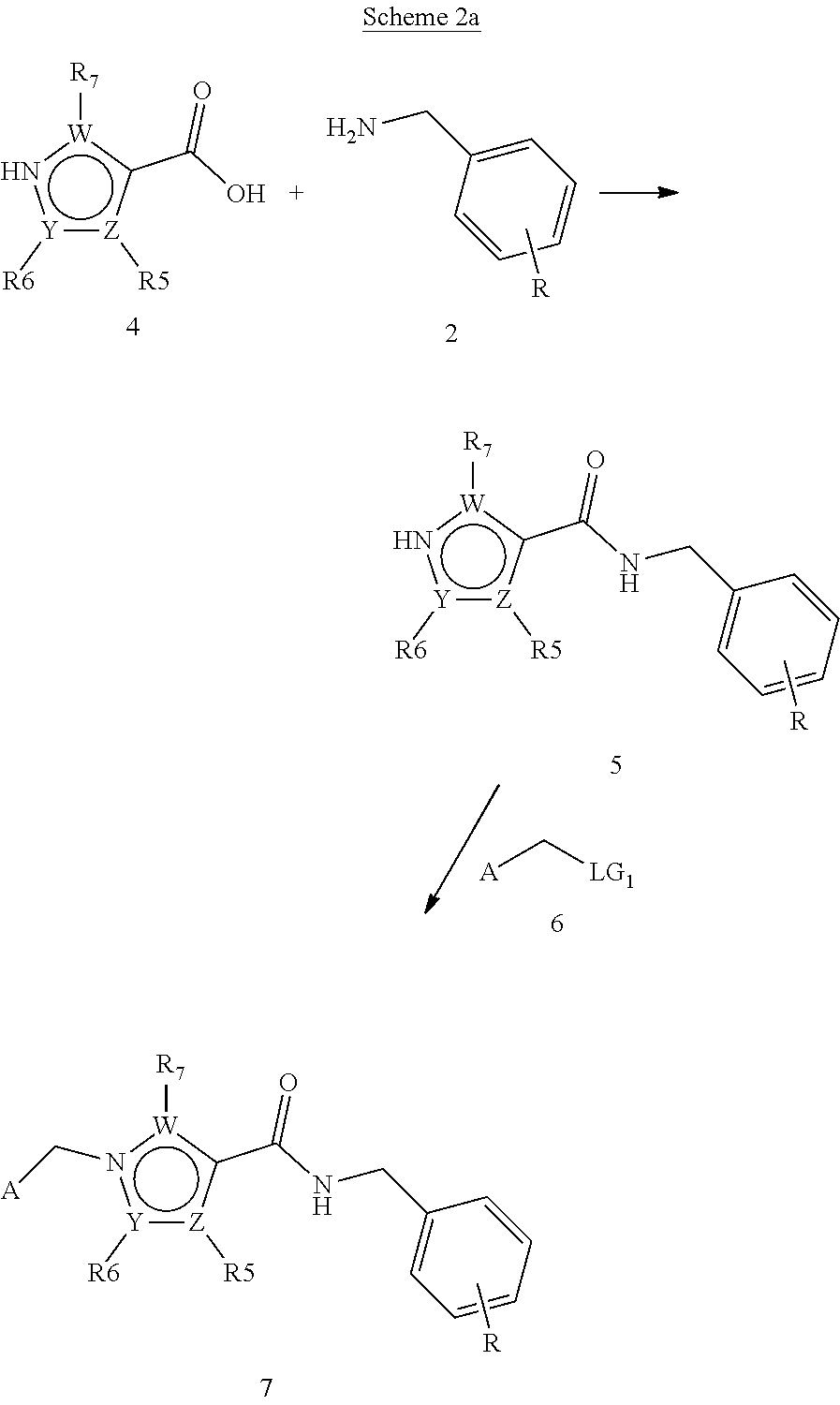
C00014
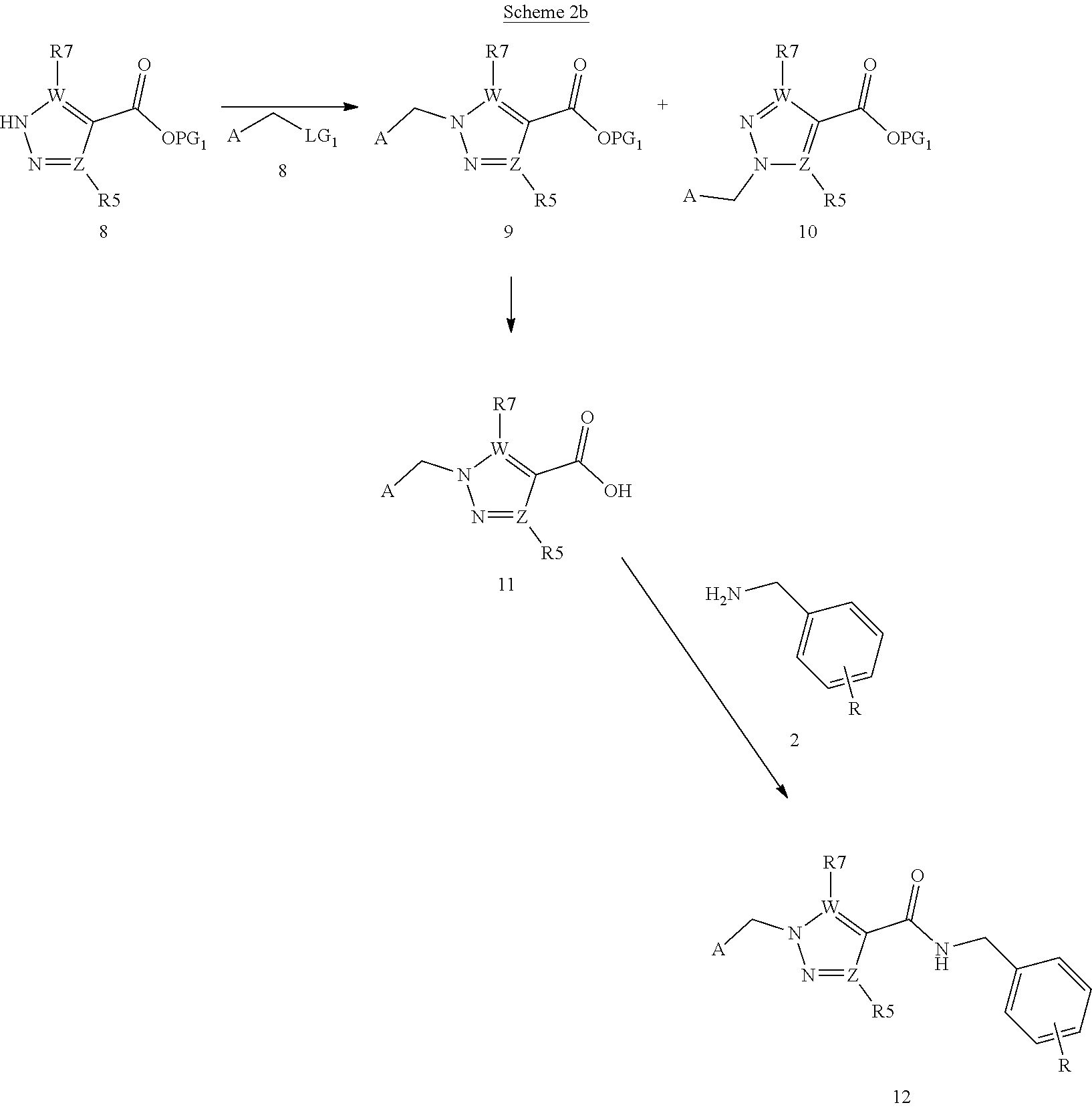
C00015
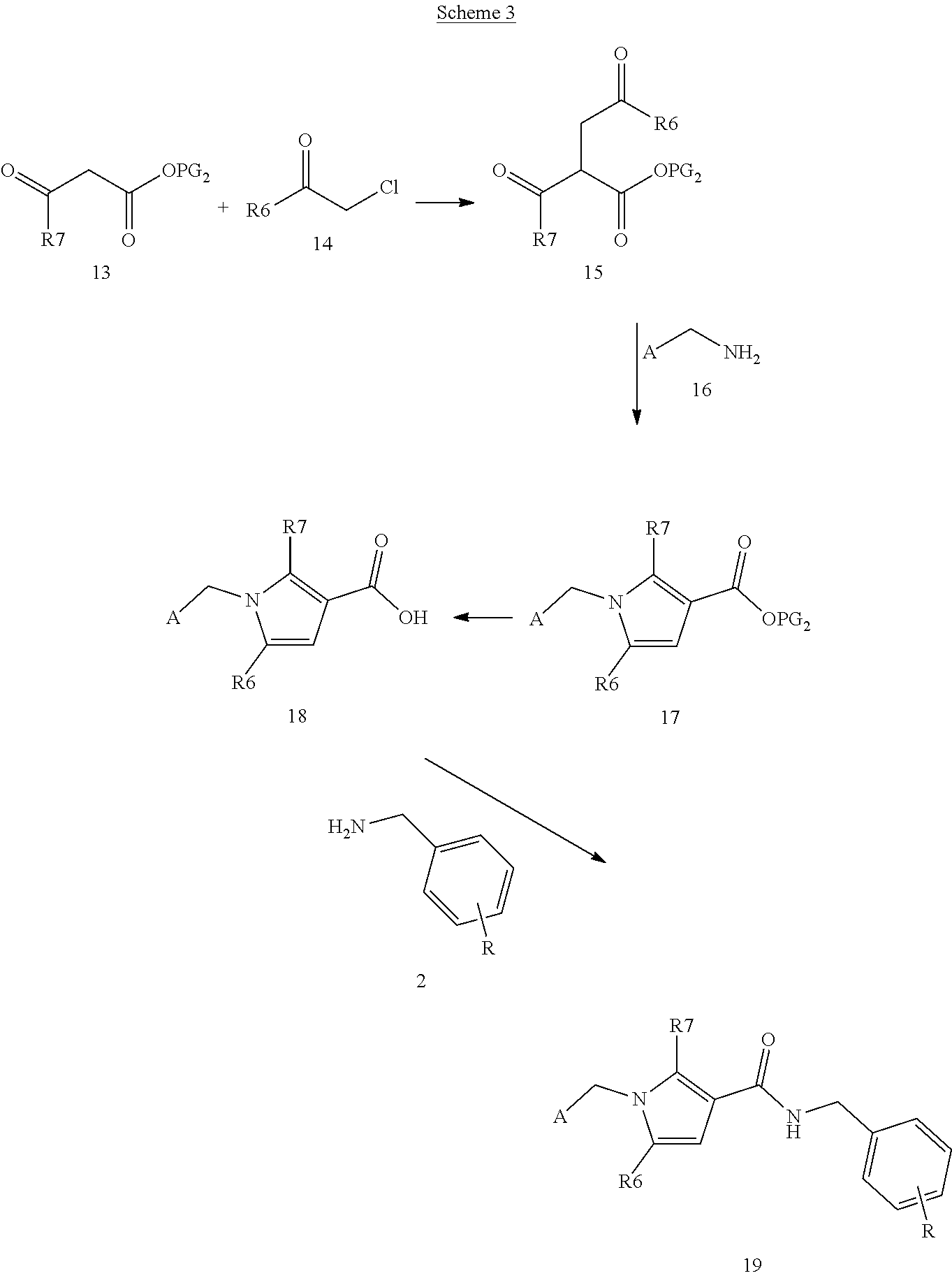
C00016
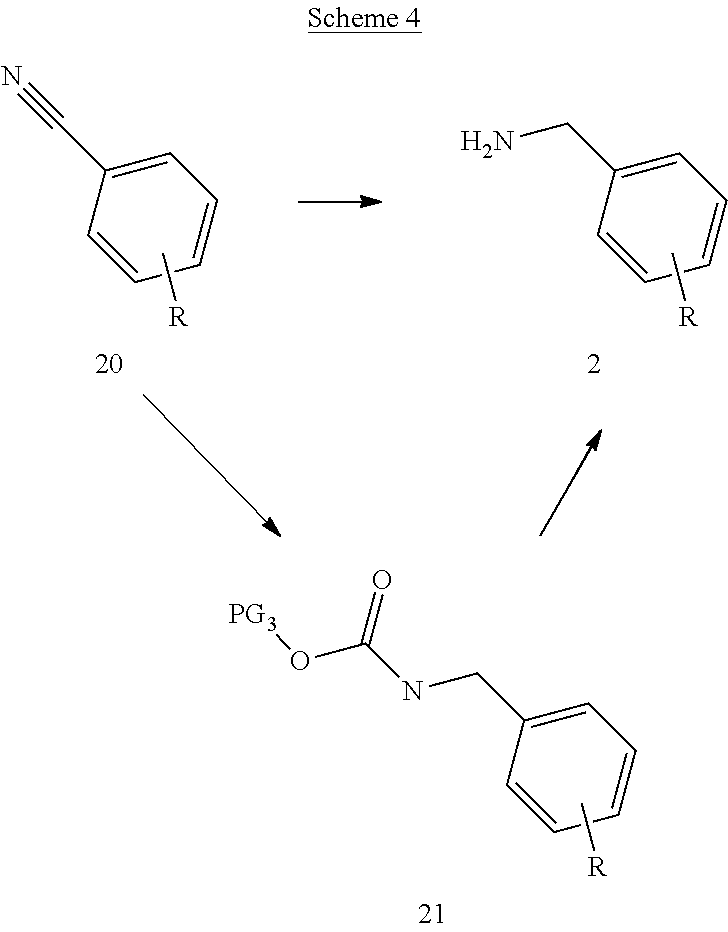
C00017
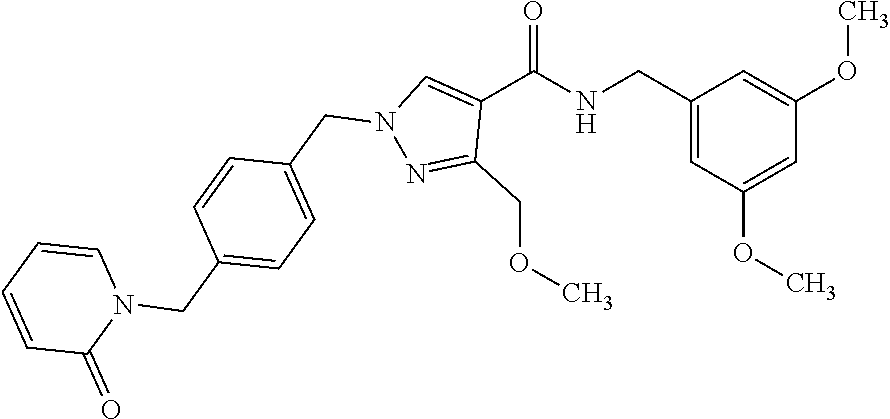
C00018
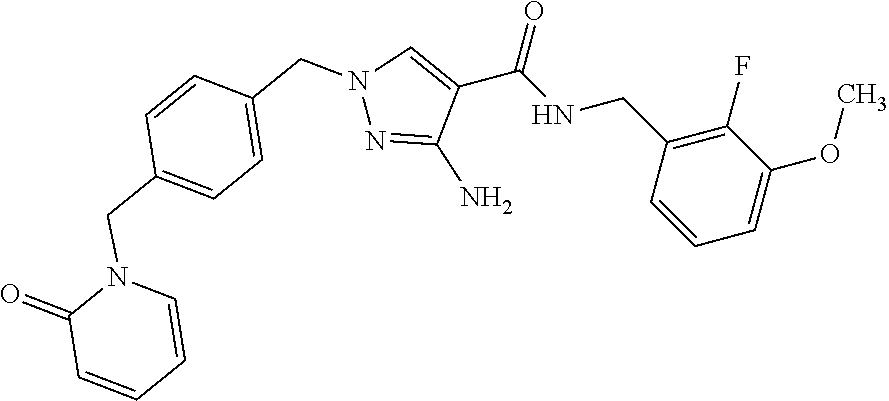
C00019
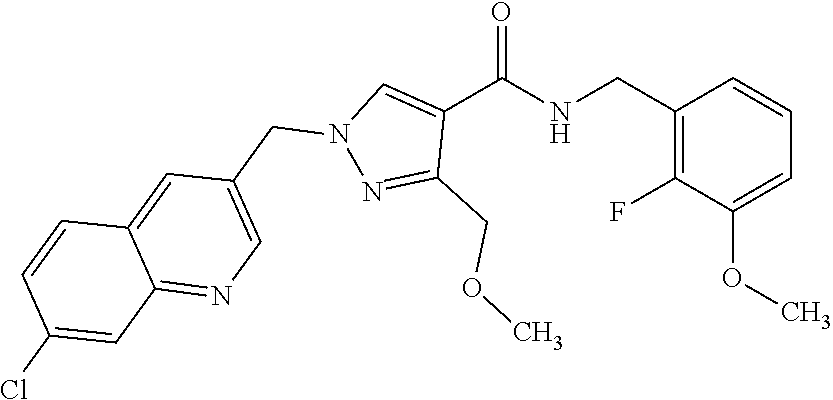
C00020

C00021
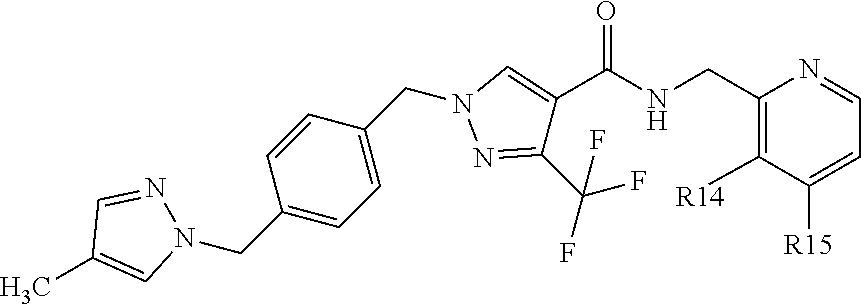
C00022
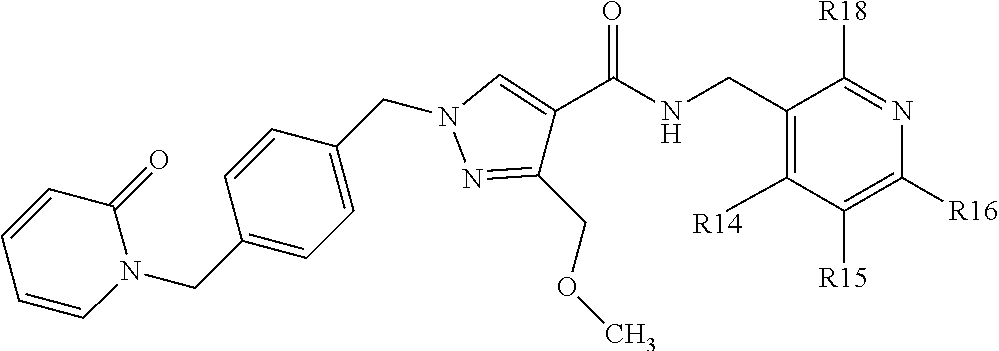
C00023
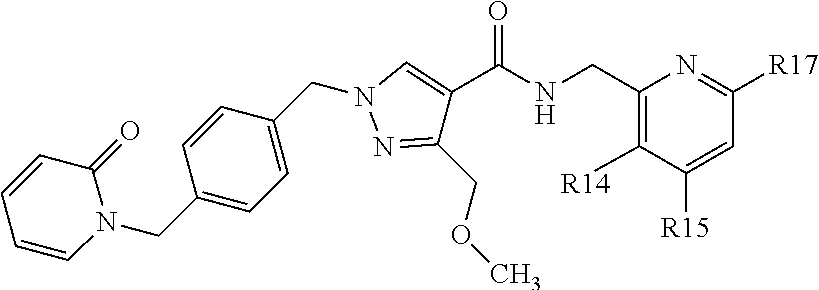
C00024
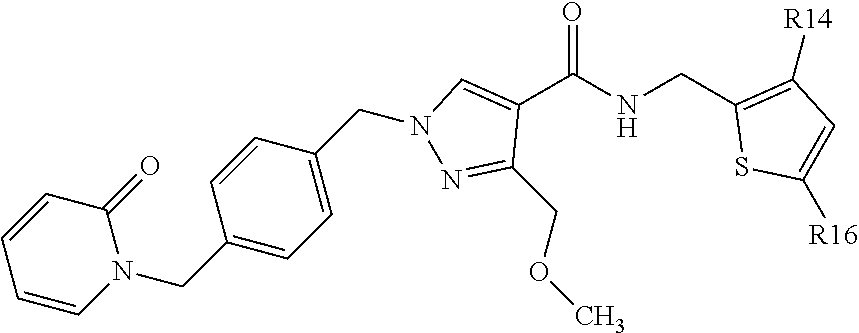
C00025
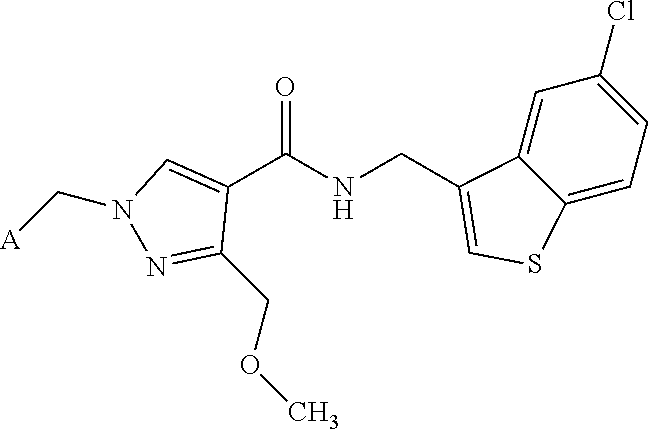
C00026
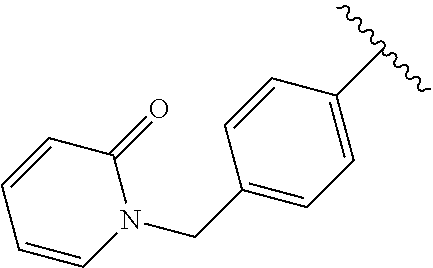
C00027
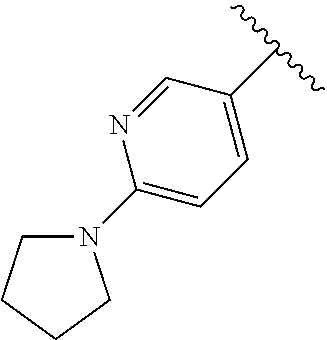
C00028
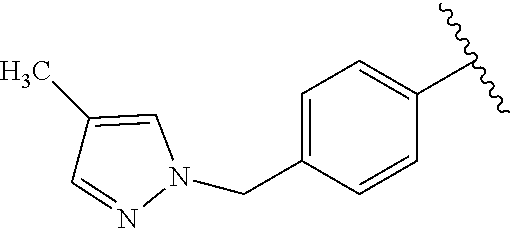
C00029
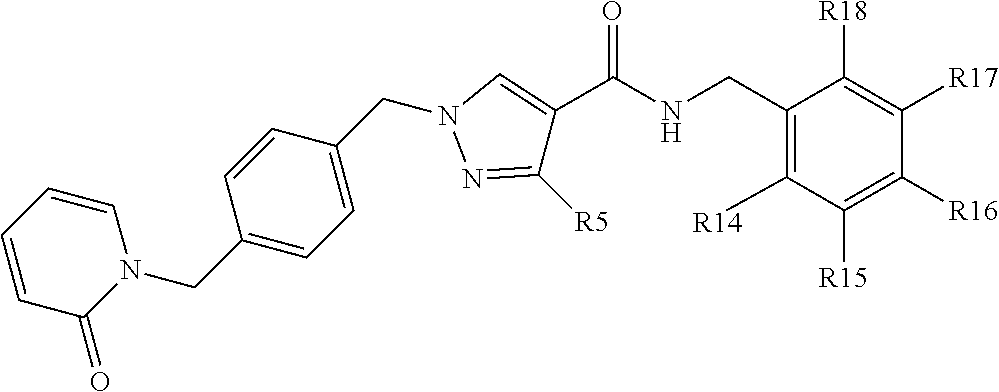
C00030
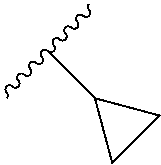
C00031
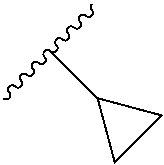
C00032
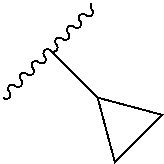
C00033
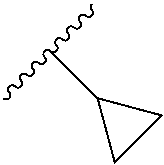
C00034
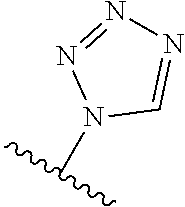
C00035
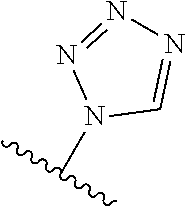
C00036

C00037
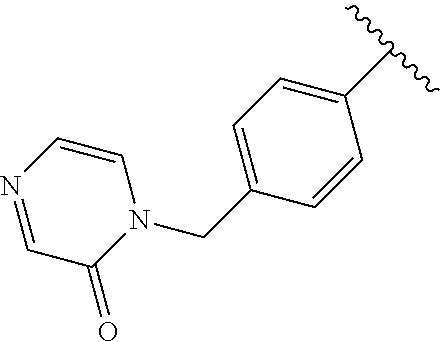
C00038
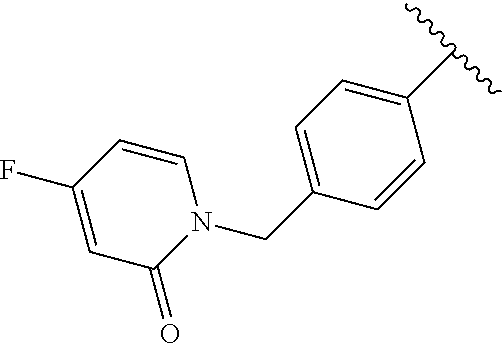
C00039
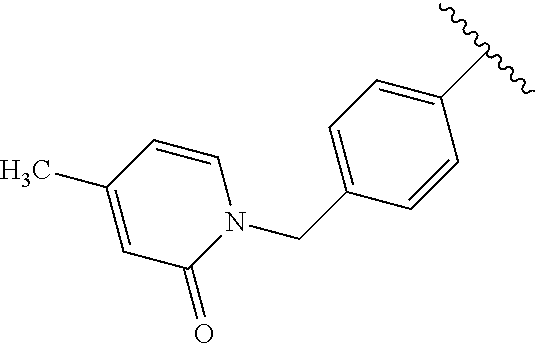
C00040
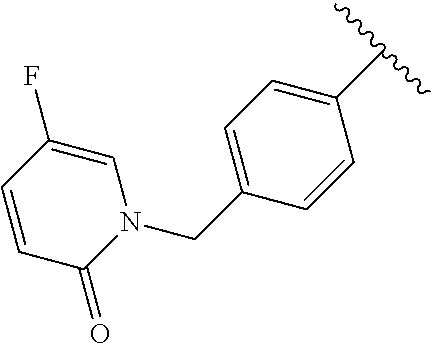
C00041
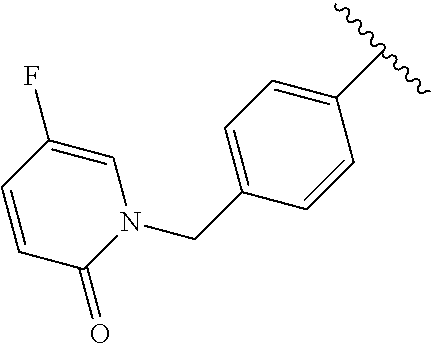
C00042
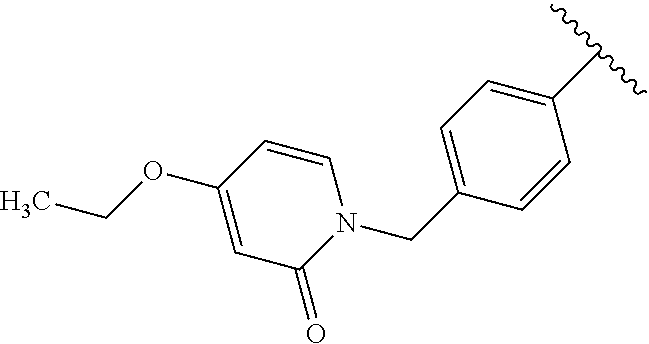
C00043
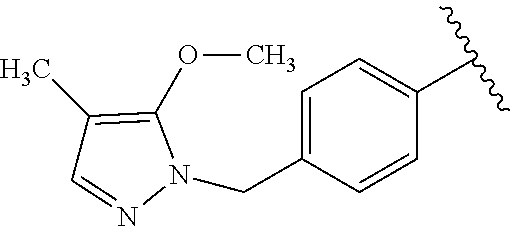
C00044
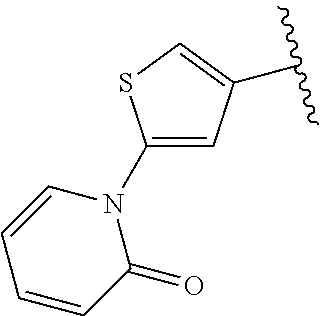
C00045
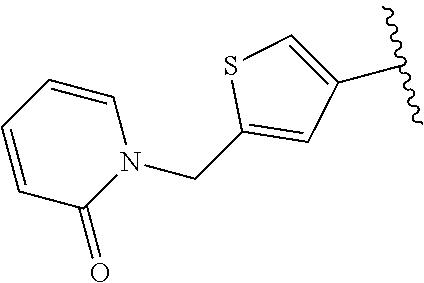
C00046
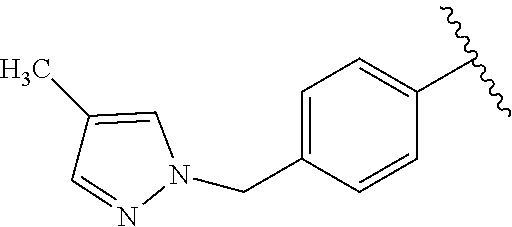
C00047
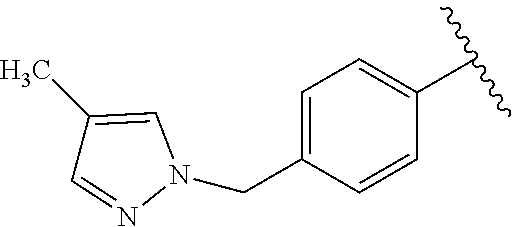
C00048
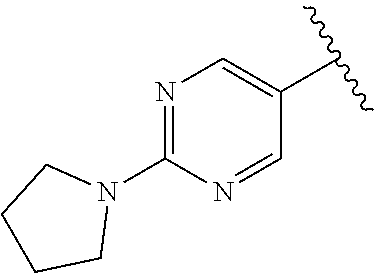
C00049
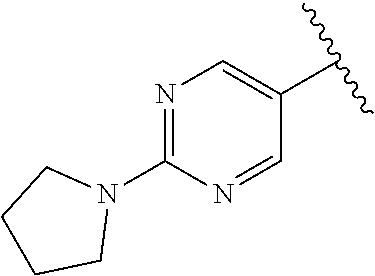
C00050
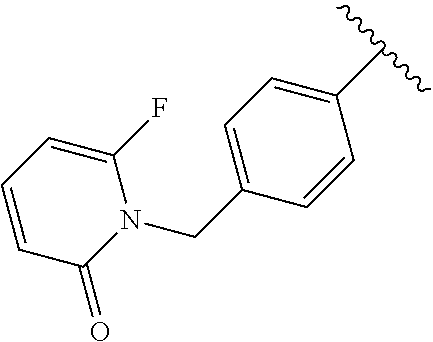
C00051
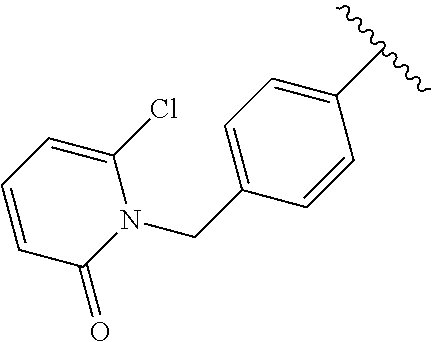
C00052
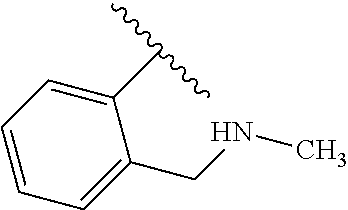
C00053
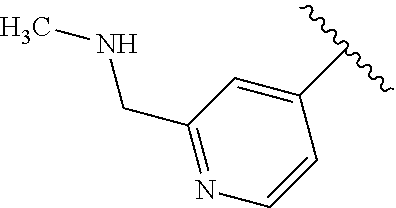
C00054
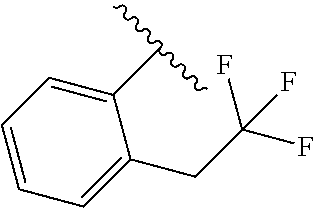
C00055
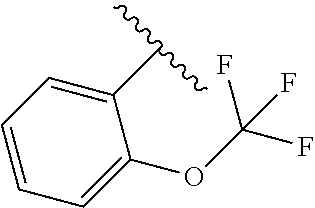
C00056
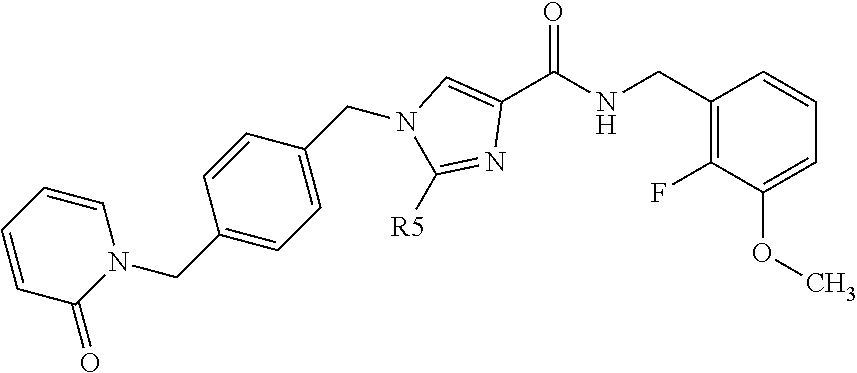
C00057
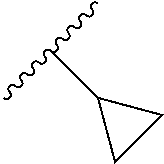
C00058
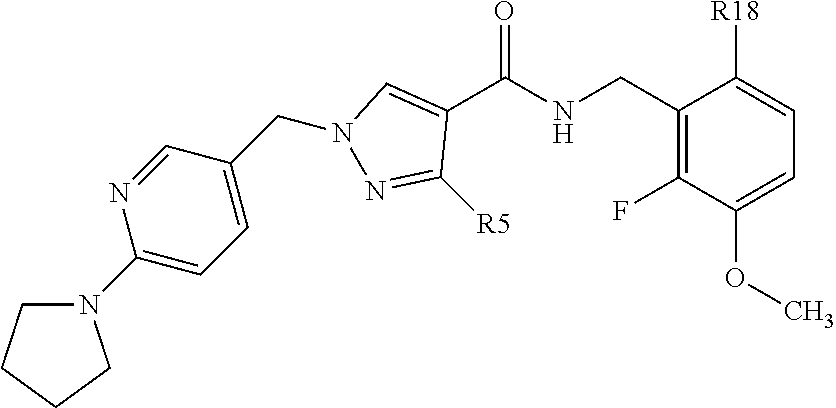
C00059
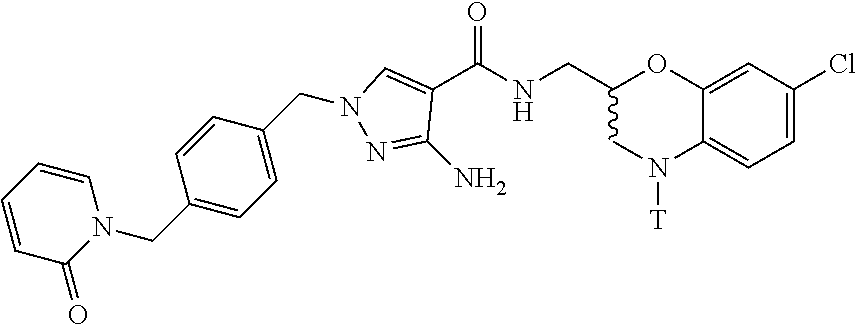
C00060
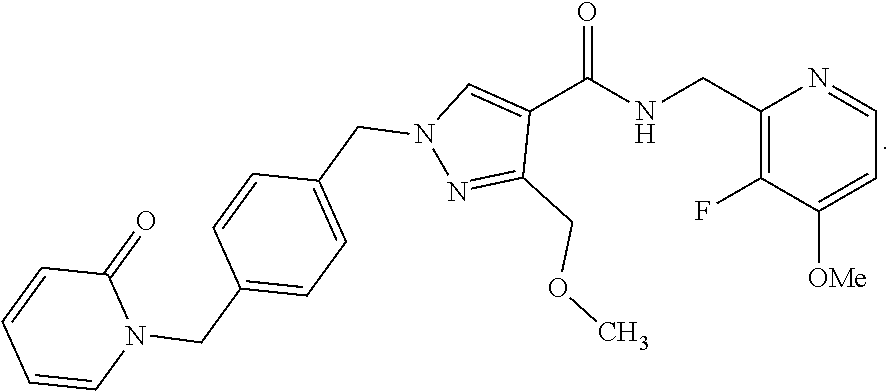
XML
uspto.report is an independent third-party trademark research tool that is not affiliated, endorsed, or sponsored by the United States Patent and Trademark Office (USPTO) or any other governmental organization. The information provided by uspto.report is based on publicly available data at the time of writing and is intended for informational purposes only.
While we strive to provide accurate and up-to-date information, we do not guarantee the accuracy, completeness, reliability, or suitability of the information displayed on this site. The use of this site is at your own risk. Any reliance you place on such information is therefore strictly at your own risk.
All official trademark data, including owner information, should be verified by visiting the official USPTO website at www.uspto.gov. This site is not intended to replace professional legal advice and should not be used as a substitute for consulting with a legal professional who is knowledgeable about trademark law.